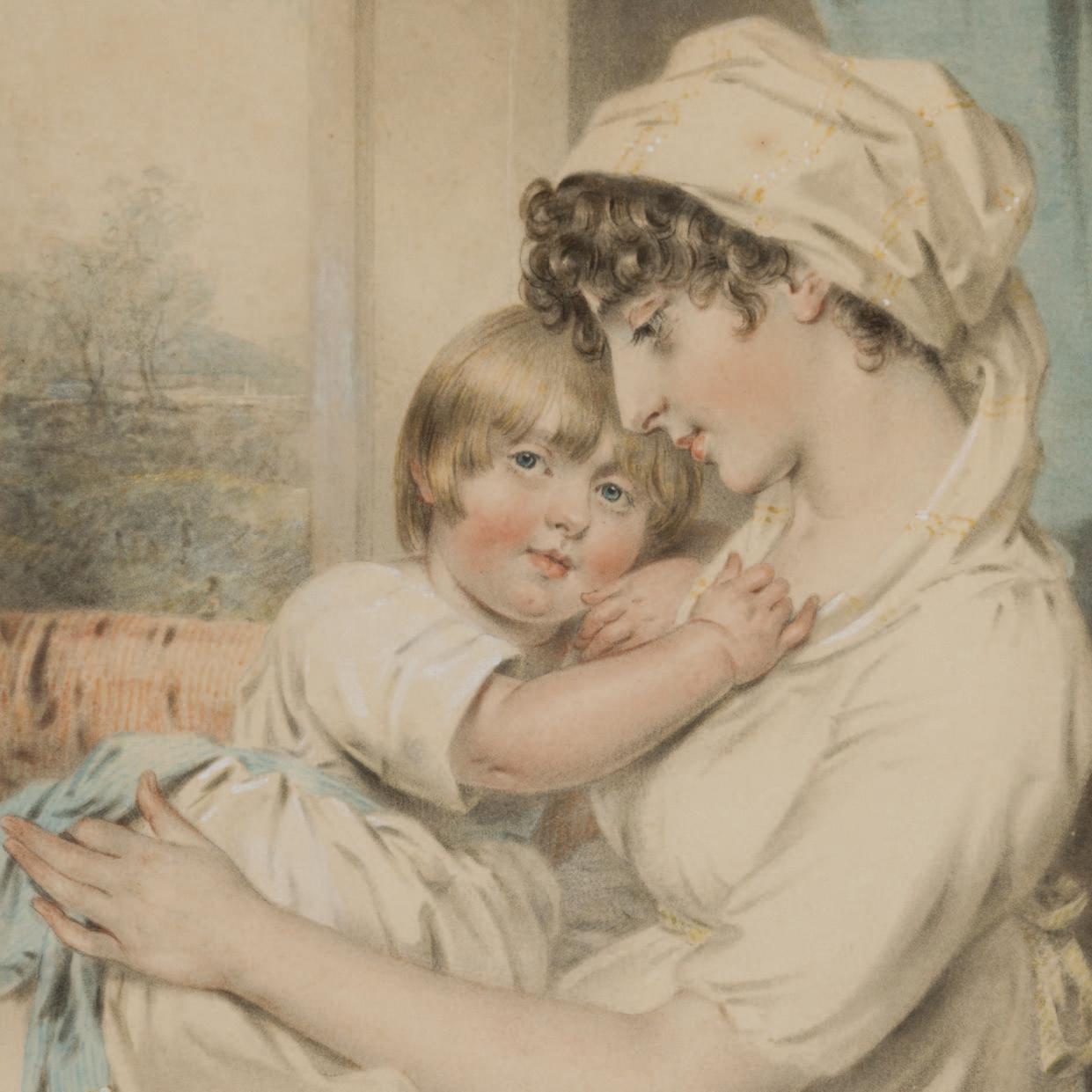
VELLUM, PAPER AND IVORY: PORTRAITS AND PORTRAIT MINIATURES
1550-1950



VELLUM, PAPER AND IVORY: PORTRAITS AND PORTRAIT MINIATURES
1550-1950

28TH APRIL TO 9TH MAY 2025
Monday to Friday 10am to 6pm
Weekends and evenings by appointment
Riverwide House, 6 Mason’s Yard Duke Street, St James’s, London SW1Y 6BU
Front Cover: (43) Anna Tonelli (c.1763-1846)
Portrait of Amelia and Harriet Harding-Newman of Nelmes, Essex at their Music Lesson
Rear Cover: (1) Attributed to Levina Teerlinc (1510-1576) King Edward VI (1537-1553); circa 1550
Opposite: (30) Richard Cosway, R.A. (1742-1821)
Portrait miniature of Thomas Augustus Hervey (1775-1796), wearing a dove grey coat and a white cravat, his hair worn down and curled; 1793
THE LIMNER COMPANY was established in 2023 by leading consultant Emma Rutherford, who has specialised in portrait miniatures for 25 years. She has worked in museums, with art dealers and in the auction world, her research and discoveries published in articles in academic publications as well as national media. Emma is also a curator, lecturer and writer. Based in London, The Limner Company works with researchers and restorers, while also holding a carefully curated selection of original works for sale. The works in this catalogue have been catalogued by Emma Rutherford, Rebecca Ingram and Emma Blane, with additional research by Phoebe Griffiths.
Works on ivory: Portrait miniatures painted on ivory before 1918, with a surface area smaller than 320cm, are exempt from the Ivory Act of 2018, but must be registered with the Department of Environment, Food and Rural Affairs (DEFRA). All of the portrait miniatures with this criteria in the catalogue are registered and the reference number will be provided to the buyer.
Opposite: (17) John Smart (1741-1811)
Mrs Fenton, wearing a white dress, a red surcoat trimmed with ermine, a drop-pearl brooch and sapphires at her corsage, her upswept, powdered hair dressed with white ribbon; 1774

Edward VI (1537-1553); circa 1550
Watercolour on vellum, laid down on card
Set into a turned ivory box
Circular, 43 mm (1 ¾ in) high
Provenance
Dr John Lumsden Propert (1834-1902), London, by 1887; Christie’s, London, 23 October 1989, lot 152 (as English School); Dr Erika Pohl-Ströher (1919-2016), until 2018; Private Collection, UK.
Exhibited
London, Spencer Club, Art Exhibition at Spencer House, 1887, no.467 (as Levina Teerlinc);
London, Burlington Fine Arts Club, Exhibition of Portrait Miniatures, 1889, case XXXIV, no.21 (as Levina Teerlinc);
London, The New Gallery, The Royal House of Stuart, 1889; London, The New Gallery, The Royal House of Tudor, 1890; London, The New Gallery, The Royal House of Guelph, 1891; London, The Fine Art Society, Historical Collection of Miniatures formed by Mr. J. Lumsden Propert, 1897, no.11 (as Levina Teerlinc); Philip Mould Gallery, ‘Jewel in the Hand; Early Portrait Miniatures from Private and Noble Collections’, 12 March – 18 April 2019, cat. no. 1; Compton Verney House, Exhibition ‘The Reflected Self; Portrait Miniatures 1550-1850’, September 2024-February 2025 as Attributed to Levina Teerlinc.
Literature
J. L. Propert, A History of Miniature Art (London and New York, 1887), ill. opp. p.66 (as L. Teerlinc); B. Long, British Miniaturists (London, 1929), p.433 (as Attributed to Levina Teerlinc).
The present portrait would appear to be one of only two portrait miniatures painted during Edward’s short reign. The other, a smaller version of the present work, appeared at a Christie’s auction 26 May 1879 and is recorded in the Heinz archive at the National Portrait Gallery in a colour photograph. Both images of Edward are almost certainly by the same hand, and belong to a small but cohesive group currently attributable to Levina Teerlinc, who was working at the English Court from 1545.
As the daughter of the celebrated Bruges manuscript illuminator, Simon Benninck or Bening, Teerlinc seems to have been highly praised for her artistic skills. Georgio Vasari (1511-1574) stated that she was ‘…held in estimation by Queen Mary, even as she is now by Queen Elizabeth’.1 The master of illumination Giulio Clovio (1498-1578) seems to have owned a portrait of Elizabeth I by Teerlinc. The present portrait, along with the other reduced version, would, perhaps unsurprisingly, firmly link Teerlinc to the court of Edward VI.
At Edward’s accession, Teerlinc may have been the only viable option as an artist to paint his portrait in miniature. Hans Holbein the Younger had died in 1543, Gerard Horenbout in 1541, and his son Lucas in 1544. Teerlinc may also have been the teacher of Nicholas Hilliard (1547-1619), although there is no firm evidence for her involvement in his training as a limner.2 Teerlinc’s £40 annuity from the crown for limning, which began in the reign of Henry VIII, continued until her death in 1576. It is notable that this was the same amount given to Gerard Horenbout and is evidence of both her status as an artist and her output as a limner.
The scarcity of portraits of Edward are testament to both his short reign and the fact that many would have been given away as gifts, likely to foreign rulers. The rarity of his image ‘in little’ can also be explained by the religious turmoil which followed his reign, spearheaded by his Catholic half-sister Mary I. Portraits of Edward would have been
destroyed or hidden away during this time, with his portraiture in demand again when his half-sister, the Protestant Elizabeth, became Queen.
The present portrait was likely painted between 1550 and 1553 when Edward died. The young King was often presented as being more mature than his actual age, adding a sense of security and strength, and a natural line from the only legitimate son of the powerful Henry VIII. As was the established practice with portrait miniatures, even from their inception, the sitter was expected to be present for the sitting. It is therefore no surprise that this portrait shows Edward in costume unique to the two portrait miniatures, with a heavily goldembroidered hat and tunic.
Later copies of this portrait, including one by Bernard Lens III, show that this miniature was considered a notable likeness of Edward.3 In all recorded copies of this portrait, including those 18th-century versions in the collections of the Duke of Buccleuch and the Earl of Beauchamp (as of 1965), the precise detailing on the costume has been translated faithfully and it is clear that whoever made the copies had either the present work, or another example from the period, close to hand.
As a rare ad vivum portrait miniature of Edward VI, the historical importance of this image cannot be overstated. Dying at the age of fifteen, Edward had looked to fulfil the legacy of his father, but, given his youth, his reign was dominated by infighting amongst the nobility, all looking to seize power. Although portrait miniatures were important tools in diplomacy, they also performed a more intimate role in Tudor relationships. It should not be overlooked that this miniature portrait may have been intended as a gift to a member of Edward’s family. Intended recipients may have been his halfsisters Mary and Elizabeth, his uncle Edward Seymour, the self-styled Duke of Somerset who would also serve as the Lord Protector, or even his successor, his fated cousin Lady Jane Grey.
1 Vere, Gaston du C. De (translated), Vasari, Giorgio, Lives of the Most Eminent Painters, Sculptors and Architects, 1996 Edition, Vol. 2, p. 865.
2 This has been most recently discussed in Dr. Elizabeth Goldring’s book, Nicholas Hilliard, Life of an Artist, published by Yale in 2019. Dr. Goldring notes that Teerlinc received a gift of plate each New Year from Elizabeth I, often from the workshop of Charles Brandon, Hilliard’s father-in-law and Goldsmith master.
3 A version of this portrait, signed by Bernard Lens III, sold at Christie’s, London, 7 December 2005, lot 95.
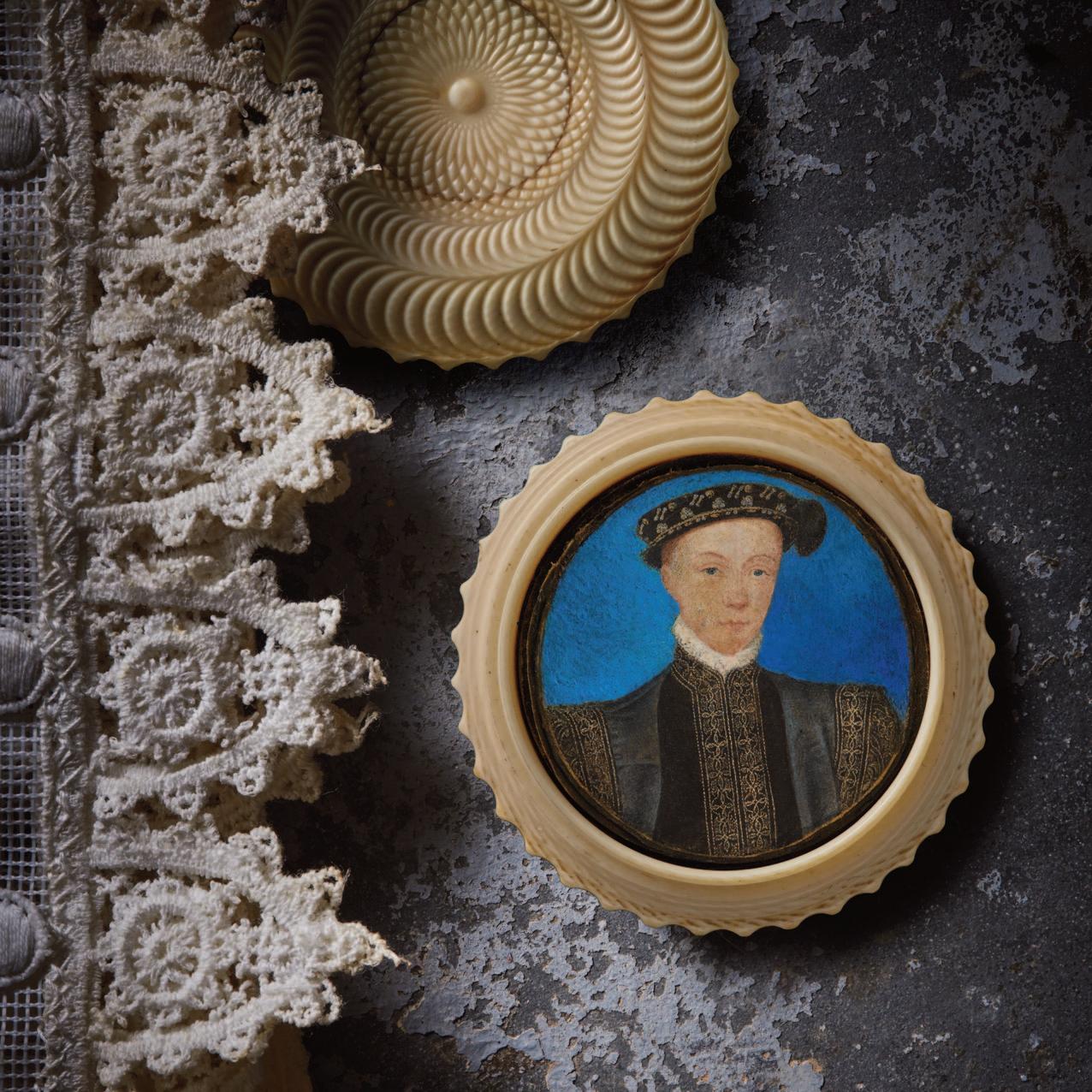
A Lady of the French Court, wearing pearl earring and large, lace ruff
Pencil and coloured chalks on laid paper; watermark: Grapes with narrow stem, surmounted by the letters "III" (Briquet 13196: Lyon, 1582) and later inscription
Polished cassetta frame with burr walnut inlay
Rectangular (trimmed) 240 x 195 mm (9 ½ x 7 ⅔ in)
Provenance
Private Collection, UK.
This sensitive drawing is a rare example of a 16thcentury portrait drawing which has survived in remarkably good condition. Possible artists would be Daniel Dumonstier (1574-1646) or the Edinburgh-born François Quesnel (1543-1619), both of whom were working at the French court in the final decade of the 16th century, attempting to fill the role of the mighty Francois Clouet who had died in 1572.1
The sitter seems to be following the influential fashion of Gabrielle d'Estrées, Marquise de Monceaux, mistress of Henri IV, King of France (1571-99).2 She was usually portrayed with her hair combed back high over her head, with a large pearl earring, including in the famous double painting in the Louvre, dated 1594, where she sits in a bath with her sister, Julienne-Hippolyte-Joséphine, Duchess of Villars, pinching her nipple in a gesture assumed to relate to the fertility or pregnancy of the twenty-one year old.3
The watermark on this drawing is identical to one found on a drawing, currently catalogued as ‘School of François Clouet, Portrait of Marguerite de Valois’, now in the Morgan Library and Museum, the paper identified as made in Lyon in 1582 (Briquet, 13196).4
Although, as with so many French drawings of this period, both the sitter and artist are yet to be identified, the work still retains the immediacy of an ad vivum sitting.
1 If by Daniel Dumonstier, this would be a juvenile work as the earliest dated work by him is 1605. Large groups of portraits by Dumonstier are in the Bibliothèque Nationale, Paris (J. Adhémar, 'Les dessins de Daniel Dumonstier au Cabinet des Estampes', Gazette des Beaux-Arts, March 1970, LXXV, pp. 129-150) and in the Louvre (J. Guiffrey and P. Marcel, Inventaire général des dessins du Musée du Louvre et du Musée de Versailles, Ecole Française, Paris, 1949, V, nos. 3799-3827).
2 A group of portraits of women from the same date were illustrated in the catalogue ‘Les Clouet de Chantilly’, Gazette des Beaux-Arts, Paris, Mai-Jun 1971, as ‘Quelques Dames de la fin du siècle, nos 339-344, p. 329.
3 Louvre Museum, accession number RF 1937-1.
4 Briquet, Les Filigranes: Dictionnaire historique des marques du papier dès leur apparition vers 1282 jusqu'en 1600.

Lady Anne Cobham (d. 1612), wearing embroidered black and gold dress, wired, white standing ruff and black cap with gold trim, circa 1595
Watercolour and bodycolour on vellum, on card
Oval, 48 mm (1 ⅞ in) high
Silver locket frame
Provenance
Mrs P. B. K. Daingerfield of Baltimore Collection; Sotheby’s, London, 9 February 1961, lot 24 (as a Lady, called Lady Cobham, by Hilliard); Edward Grosvenor Paine (1911-1989) Collection, New Orleans, inv. no. 186; Christie's, London, 20 March 1989, lot 161 (as Lady Cobham by Rowland Lockey);
With D. S. Lavender (Antiques) Ltd., in 2000 (as Anne, Wife of Sir Henry Cobham by Rowland Lockey);
The Collection of the late Mrs. T. S, Eliot, Christie’s, London, 20 November 2013, lot 88 (as Anne Cobham née Sutton (d. c. 1612)); Private Collection, UK.
Exhibited
Victoria and Albert Museum, Artists of the Tudor Court, (London, 1983), no. 124 (as an Unknown Lady, attributed to Roland Lockey).
Literature
Strong, R. (1983) The English Renaissance Miniature, London: Thames & Hudson. Illustrated p. 139 (as an Unknown Lady by Rowland Lockey) and p. 140.
Portrait miniatures attributable to Rowland Lockey are extremely rare, but the present example has been given to his hand by many eminent art historians, including Sir Roy Strong. The case for this particular Rowland Lockey is based on the stylistic and technical similarities between this work and those miniatures by his master, Nicholas Hilliard.1
Technically, the present miniature is complex – the black silk of the gown is drawn in lattice ribbons over an embroidered under gown, with an intricate thread weaved in loops. Each pearl on the sitter’s neck and cap is carefully highlighted with silver (now blackened through oxidisation). Shell gold is added to the cap to give the jewelled element weight, and the ruff is carefully drawn with each layer carefully delineated (albeit in a much thinned down white pigment compared to Hilliard’s three-dimensional depiction of lace). Clearly the artist of this miniature had an intimate understanding of the technical elements which Hilliard guarded so carefully. The fact that the two men worked alongside each other, meant that, unlike Isaac Oliver (c.1565-1617), Lockey was a colleague, not a rival.
Lockey is recorded as joining the household of Nicholas Hilliard in 1581 as apprentice to the artist who would only have been in his mid-30s, but who was already considered the chief image-maker of Elizabeth I. Since his childhood therefore, Lockey was also likely learning his craft from Hilliard’s mastery.2 In his Treatise concerning the Arte of Limning, Hilliard comments on the difficulties in
finding good assistants who can work to his exceptional standard. ‘The good workman also which is so excellent dependeth on his own hand, and can hardly find any workmen to work with him, to help him to keep promise, and work as well as himself, which is a great mischief to him’.3 As Elizabeth Goldring notes, many of Hilliard’s ‘schollers’ would have been trained in an unofficial capacity, freeing the ever insolvent Hilliard from paying for their board and lodging.4
Despite the circumstantial and documented evidence, which places both Lockey and Isaac Oliver as successors to their former master, it is only Isaac Oliver who leaves a body of recognised and recognisable work. As Otto Kurz stated in his article of 1957, ‘a number of elusive or shadowy personalities remain. One of them is Rowland Locky (sic)’.5 As was the case of his former master, Lockey was making a living outside the sphere of limning.6 Lockey is also noted as an independent artist in contemporary literature – his name appears in Richard Haydocke’s preface to A Tracte Containing the Artes of Curious Paintinge, Carvinge & Buildinge (1598); he is also mentioned by Francis Meres, in his Palladis tamia (1598), among the eminent artists then living in England, and in Edward Norgate’s Miniatura (1627-28), as using a third technique of crayons, or ‘dry colours’.7 The antiquary William Burton calls him Hilliard’s ‘expert scholler…who was both skilful in limning and in oilworks and perspectives’.8
1 Lockey’s signed and dated, visual family tree of the More family of 1593 is one of the most important paintings by him (National Portrait Gallery, NPG 2765).
A cabinet miniature copy of this oil painting, dated slightly later, is in the Victoria and Albert Museum; a further oil version is at Nostell Priory (West Yorkshire).
2 This information was first given by Edmond, M, Hilliard & Oliver: The Lives and Works of Two Great Miniaturists, (London: Robert Hale, 1983), p. 72, where she quotes the 1588 will of Dutch student Pieter Mathewe which referred to ‘my twoe fellowes Isac Olivyer and Rouland Lacq’.
3 P. Norman, ed., ‘Nicholas Hilliard’s Treatise concerning ‘The Arte of Limning’, with Introduction and Notes by Philip Norman, LL.D.,” The Walpole Society 1 (1911-12), p. 41.
4 Goldring, E, Nicholas Hilliard: Life of an Artist (London: Yale University Press, 2019), p. 181.
5 Kurz, O, ‘Rowland Locky’, The Burlington Magazine, Vol. 99, (1957), no. 646, p. 12.
6 Elizabeth Goldring notes that at the time of Lockey’s apprenticeship: ‘Hilliard and his workshop produced not just miniatures but paintings in great (portraits as well as ‘story work’), seals, medals, illuminations, designs for prints and miscellaneous decorative painting’, see; Goldring, (2019) Hilliard, p. 170. Lockey was also responsible for designing title-page borders for the Bishop’s Bible in 1602 – evidence that he was supplementing his income outside of painting oils or miniatures.
7 Burnette, A. (2010). ‘Lockey, Rowland (c. 1566-1616), painter and goldsmith’, Oxford Dictionary of National Biography [online] Available at: https://www.oxforddnb.com/view/10.1093/ref:odnb/9780198614128.001.0001/odnb-9780198614128-e-16897 [accessed 9 Feb 2021]. This technique presumably refers to the type of drawing in chalks used by Holbein and later at the French court by Jean Clouet and others. In France they were often preliminary life drawings for miniatures or oils.
8 Murdoch, J The English miniature, (London: Yale University Press, 1981), p. 60.
By 1589 it is likely that Lockey was a freeman of the Worshipful Company of Goldsmiths and in 1600, his brother Nicholas joined Hilliard as an apprentice.9 In the exhibition Artists of the Tudor Court (1983), the curator Roy Strong attempted to assemble his oeuvre.10 The written plaudits afforded to Lockey by his contemporaries have not been matched by documented portrait miniatures, but Strong used as his basis the More series and an oil of Margaret Beaufort, Countess of Richmond and Derby, of 1598, inscribed ‘Rolandus Lockey pinxit Londini’.11 He also compared a miniature of an unknown noblewoman by Hilliard and a contemporary copy of the same subject; the latter he attributed to Lockey.12 However, unlike the work of Laurence Hilliard (1582-1648), there are simply no signed works with which to compare those mysterious, non-Hilliard miniatures of the later 16th century.13
Although Lockey clearly made a living through his oil copies, he was fully trained to paint ad vivum miniatures. As Strong pointed out, the presumed sitter of the present miniature is of the type of aristocratic rank who appears to have employed Lockey, as he is recorded as working for both Elizabeth (‘Bess’) of Hardwick. Anne Cobham married Walter Haddon (c. 1514-1571) but had no children, and secondly Sir Henry Cobham (15381591/2), with whom she had three children.
9 The exact date is unknown but it was certainly after 1589 and no later than the summer of 1592, as by then Lockey was employing an apprentice of his own.
10 Strong, R. and Murrell, V.J, Artists of the Tudor court: the portrait miniature rediscovered, 1520–1620. (London: Victoria and Albert Museum, 1983).
11 The Mater and Fellows of St John’s College, Cambridge. This painting is a copy of an earlier work.
12 Strong and Murrell, p. 94.
13 Miniature of an unknown lady by Nicholas Hilliard, collection of the Duke of Buccleuch and Queensberry KT and second version in the National Museum, Stockholm (NMB 1694).

after JOHN DE CRITZ THE
(1551/2-1642)
King James VI/I of Scotland and England, wearing a silver doublet, white lace ruff, and a black hat with the ‘Mirror of Great Britain’; circa 1635
Oil on copper
Turned ebonised wood frame
Oval, 85mm (3 ⅓ in) high
Provenance
Private Collection, UK.
Although generally considered to be a vain man, James VI/I of Scotland and England did not enjoy having his likeness taken. Sir A. Weldon, author of a work on the Court of James from 1650, said that the King ‘could never be brought to sit for the taking of that [picture], which is the reason of so few good pieces of him’.1 This may be part of the reason that so much of the iconography of James is based on certain ‘types’ of portraits, painted by artists close to the monarch. In the present miniature, the likeness has been taken from the well-known ‘De Critz’ type, of which at least 20 full-length portraits are known. John De Critz was Serjeant Painter to the King, a post that he shared with Robert Peake the Elder. James was also known to have employed Isaac Oliver, as his Painter in Miniature, as well as Marcus Gheeraerts the Younger. The De Critz portraits (and versions) are scattered in collections across the world, including the Dulwich Picture Gallery, the Prado, and the Pitti Palace. These full-scale portraits are first recorded to have been painted in 1606.
On the reverse of the miniature, the name of the artist ‘Gonzales Coques’ is engraved. Coques was known as the ‘little van Dyck’ for the influence he took from the great portrait painter and trained under Pieter Breughel III. Like van Dyck, he was an Antwerp-born artist, but it is thought that he worked in England between 1635 and 1640, so he may have encountered and copied this portrait of the King at this later date. The robust nature of oil on a copper support means that the present work has remained vibrant and animated, as is usually the case with smaller works painted by Coques.
The different versions of the De Critz portrait type vary, specifically in the jewel that the King wears on his hat, whether this hat has a feather on it, whether or not his shoulders are covered by a coat, and, very specifically, whether his collar has ties
1 Sir A W[eldon], The Court and Character of King James, 1650, reprinted by G. Smeeton, (London, 1817), pp. 55-59.
2 Roy Strong, The Tudor and Stuart Monarchy, volume III, Jacobean and Caroline, p. 73.
falling down from its centre. Looking at these details, it has been possible to identify that this miniature must have been taken by Coques from the De Critz portrait now in the National Maritime Museum, Greenwich, as this is the only full-scale portrait which matches the present composition in all these details.
King James wears the hat jewel known as the ‘Mirror of Great Britain’, which had been created, Strong believes, from jewels held by the Elizabethan court.2 Other formal jewels include those known as ‘The Three Brothers’ and ‘The Feather’. All of these jewels were pawned off at the end of James’s reign. ‘The Mirror’ was formed of a rhombus made from three diamonds, and a ruby, surmounted by two diamonds. Below this rhombus sat the famous ‘Sancy’ diamond, which is reputed to have been owned by numerous royals throughout history.
The rest of the King’s attire does not go unadorned; he wears a necklace with pearls and what appear to be more diamonds, and from this hangs a George of the Garter, likely to have also been encrusted with diamonds.
King James is predominately remembered in popular culture for his scandalous behaviour within his court. He had numerous ‘favourites’ who rose to gain extraordinary power and privilege at court, sometimes well beyond their abilities. The son of Mary, Queen of Scots, he became King of Scotland in 1567 when his mother was forced to abdicate the throne. In 1603 he became the King of England, following the death of his cousin Elizabeth I, who had been responsible for the execution of his mother. As a monarch in both countries, he created a ‘dynastic union’, a precursor to the political union of the nations of Britain in 1707.

A Gentleman, traditionally called Charles Fleetwood, later Lord Fleetwood (circa 1618-1692), wearing armour and lawn collar; circa 1655
Watercolour on vellum
Inscribed verso, in a later hand, ‘11 / General Fleetwood’
Oval, 57 mm (2 ¼ in) high
Turned wood frame with later scroll plate
Provenance
Sotheby’s, London, 6 June 2007, lot 153 (as Portrait of an Officer); Private Collection, UK.
1 Yale Center for British Art, accession number B1974.2.12.
2 Rosenbach Foundation, Philadelphia.
The previous identification of this miniature portrait stems from an inscription on the reverse of the original backing, which appears to have been added at a later date. Identifying the portrait as one of General Charles Fleetwood, it is probable that this name was added to the miniature during the nineteenth century, when interest in the interregnum and Oliver Cromwell experienced a revival. Fleetwood was one of the Lord Protector’s most notorious generals, as well as his son-in-law. He had fought at Naseby (1645), Dunbar (1650), and Worcester (1651), and played a major role in governing England when Cromwelll became the Lord Protector. Comparisons to known portraits of Fleetwood, by Samuel Cooper (1607/8-1672)1 and Thomas Flatman (1635-1688)2, indicate that this is not the name of the gentleman portrayed here.
The painter of this portrait was John Hoskins the Younger, son of the well-known elder artist. For a long time, differentiating the hands of the two was seen as almost impossible. The younger is believed to have worked in his father’s studio for over ten years as an apprentice before being employed as an assistant.3 Compared to his father, John Hoskins the Younger lived in a far more peaceful and politically stable climate. Hoskins the Elder was employed by the Court before the outbreak of the English Civil war and had adapted to paint during the war, capturing those on opposing sides and then into the Interregnum.
3 E Rutherford, et. al. Warts and All: The Portrait Miniatures of Samuel Cooper, London, Philip Mould & Company, 2013, p.98.
Hoskins the younger was likely taught the art of limning alongside his older cousin Samuel Cooper. The similarity between their styles attests to this, but Cooper soon became the most sought-after miniaturist in England and garnered an International reputation. The workshop of Hoskins, which had been so successful during the reign of Charles I, suffered from the success of its most promising pupil. Family loyalty to Hoskins the elder might be behind the commission of this officer, painted against a distinctive half-sky blue background.
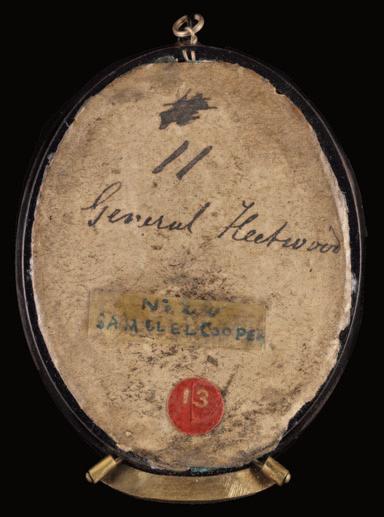

King Charles II (1630-85), wearing a decorated doublet under an armour breastplate, blue sash of the Order of the Garter, and a lawn collar; circa 1651
Watercolour on vellum
Signed with initials and dated DDG
Original turned stained wood frame
Oval, 57 mm (2 ¼ in) high
Provenance
Christie’s, London, 9th December 2008, lot 221; Private Collection, UK.
Exhibited Compton Verney House, Warwickshire, ‘The Reflected Self; Portrait miniatures 1540-1850’, September 2024-February 2025.
This portrait by David des Granges is one of a series commissioned by the young Charles while fleeing into exile. Here, his official title was ‘King of Scots’, as after his father Charles I’s execution in January 1649, The Scottish Parliament proclaimed Charles II as king.
This title was not a comfortable fit, as Charles’s relationship with the Scottish Parliament was fraught to say the least. The young king refused to bow to demands concerning religion, union, and the peace of Scotland, according to the covenants. After a final attempt to invade England, Charles’s army was defeated at Worcester in 1651. That year had begun with Charles’s coronation as ‘King of Scots’ in January but he now became a fugitive, hunted through England (hiding from the army’s search in, among other places, the famous oak tree at Boscobel), protected by a handful of his loyal subjects until he escaped to Normandy, France in October 1651.
Based back in Perth, the artist des Granges was tasked with painting miniatures of Charles to distribute to those who were loyal to the monarchy and providing much needed funds to the royal family.1 New research into the life of des Granges and his family has shown that the artist had relocated from London to Edinburgh by 1649, where they baptised a son named Samson, after his grandfather, in Canongate. Although it has been suggested that des Granges followed Charles II to Edinburgh, when the future king arrived in the city in June 1650, Des Granges had actually already been based there for at least a year.
The dire financial circumstances of the monarchy are well illustrated by des Granges’s own plea to be paid for portrait miniatures, such as the present example, in the Treasury Papers of 1671. Called ‘A Schedule of Work done by David de Grange Intertained Limner to His Majty during Y or Royal abode at St.Johnstons at Scotland’. The artist had
already waited two decades to be remunerated for his work. The only gain for des Granges, other than this expression of his loyalty to the crown, was the title of King’s Limner.
One of barely a dozen portraits gifted to those closest to the royal family, the remaining extant miniatures have ended up in large and important collections across the country, including the Buccleuch collection, Ham House collection, and the National Portrait Gallery. Without the King to hand, des Granges took his visage from oil portraits. The lost oil by by Adriaen Hanneman is the likely source here.2 Des Granges also seems to have gained inspiration from the portraits by Champaigne for his own composition, featuring similar tassels on Charles’s lawn collar, and slightly flattening the King’s hair too.
Two years after the death of Oliver Cromwell, in 1660, Charles returned to England to begin the process of restoring the crown. Portraits, particularly portrait miniatures, were a key feature in this transition – they had kept the image of the King and his claim to the throne alive during the Protectorate. Given that portrait miniatures were deemed to represent the absent sitter ‘by proxy’ (i.e. as if they were bodily present), they invoked the loyalty of the owner far more than other portrait formats. Their size also meant that they could be hidden and secretly gifted. The original stained wood case would originally have had a lid, which would have kept the portrait both protected and concealed.
The present work is both a rare survival and a key object in the story of the Restoration of the monarchy.
1 Des Granges is known to have been based as St Johnston’s, the 17th century name for Perth, the city closest to Scone Palace where Charles II had just been crowned King.
2 O. Ter Kuile, Utrecht, Adriaen Hanneman, 1604-1671: A Portrait Painter in the Hague, 1976, p. 68.
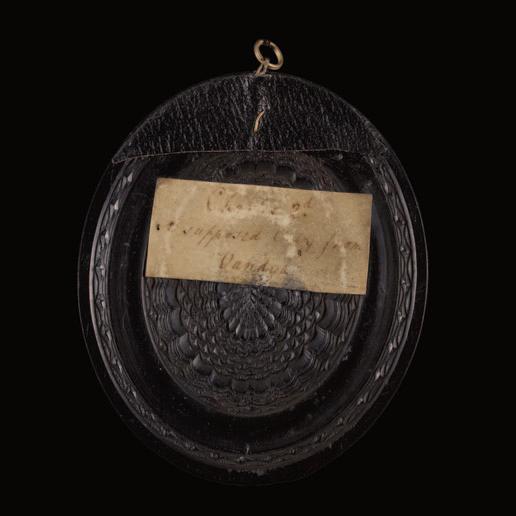
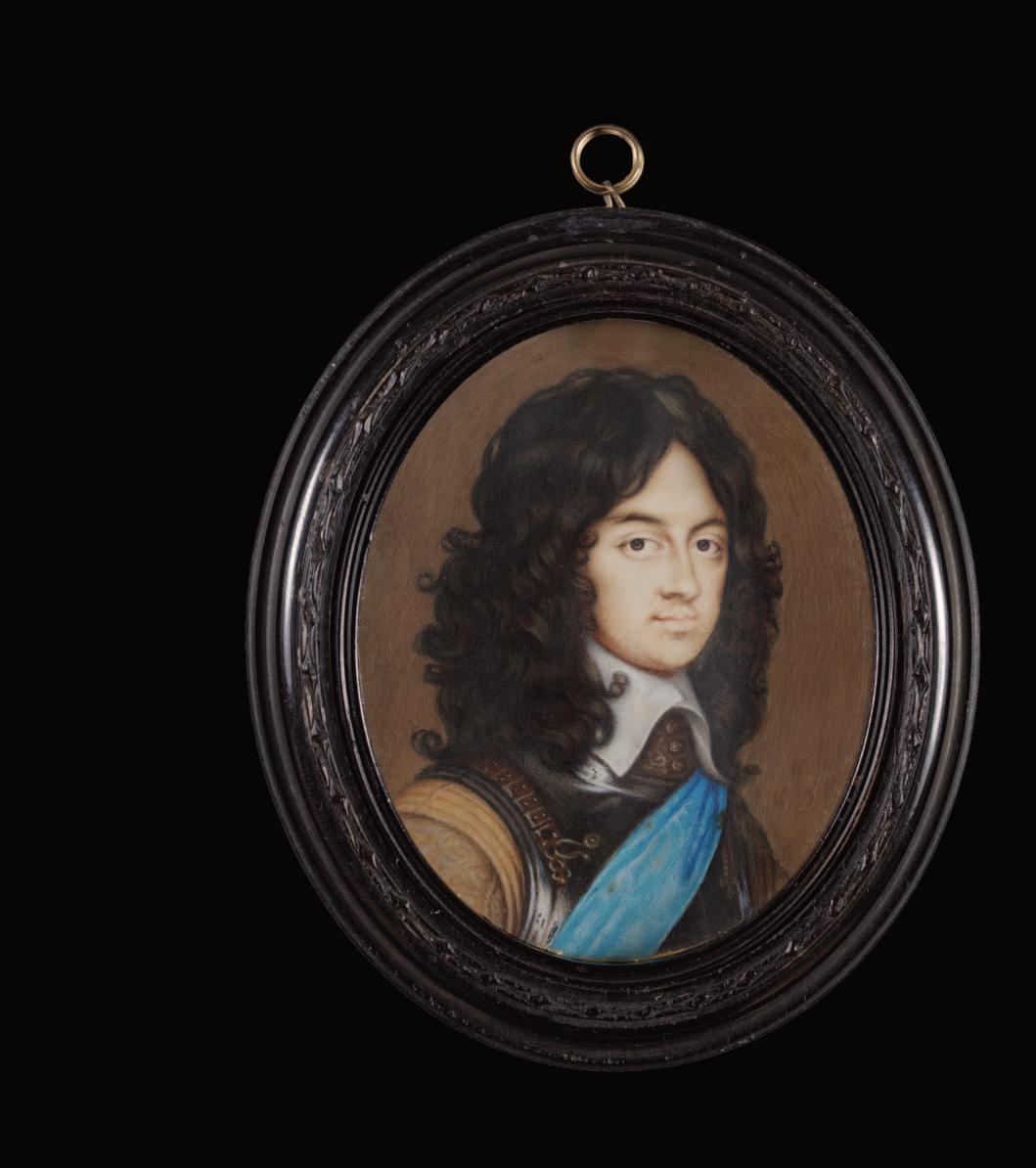
King James II as Duke of York (1633-1701); circa 1649/50
Watercolour and bodycolour on vellum
Silver frame, likely contemporary, inscribed verso ‘REMEMBER DEATH’ with a border of engraved bones
Oval, 61 mm (2 ¾ in) high
Provenance
The Collection of Edward Grosvenor Paine, Christie’s, 23 October 1979, lot 29; Private Collection, UK.
Exhibited
London, Philip Mould Gallery, Warts and All: Portrait Miniatures of Samuel Cooper (title in italics), 13 November - 7 December 2013, cat. no. 29.
Literature
E Rutherford, et. al. Warts and All: The Portrait Miniatures of Samuel Cooper, London, Philip Mould & Company, 2013, p.88.
After the shocking execution of their father, King Charles I, in January 1649, his two eldest sons fled into exile on the Continent. It was assumed that the ‘Divine right of Kingship’ would be restored by one, or eventually, both of the young men. This portrait miniature likely marks the point at which James, like his brother Charles, was abroad but keeping the memory of the monarchy very much alive while Cromwell ruled as Lord Protector over England’s new Commonwealth.
The dating of this miniature can be evidenced by several factors. Firstly, it aligns closely with Sir Peter Lely’s oil portrait of the three younger children of Charles I, painted while they were in the custody of the Duke of Northumberland in 1647. In the year following, Lely painted the double portrait of Charles I and his son James (who was by then in captivity). Like the portraits painted in the early 1650s, also by des Granges, this image of James was constructed from earlier images, as he could not be present for the miniature. Although this bucked the tradition of having the sitter in attendance for his or her portrait miniature, the recipient (often a highly valued member of the royal household or important royalist) was still given a sense of the sitter’s presence. As well as being highly portable and easily hidden, the intimate nature of portrait miniatures was well-established by this date and the recipient would have been rewarded for their loyalty by this decidedly personal gift.1
Contemporary accounts show that des Granges was working in Scotland (Perth) for the Royal Household at this date. His appointment as ‘His Majesty's Limner in Scotland’ in 1651 kept him busy producing portrait miniatures for those closest to the royal family. Stylistically, this portrait of James conforms to the known portraits of his brother Charles, further confirming the likely dating to the early 1650s.2
The unusual frame is a further clue to the dating of this miniature, as it would have reminded the owner of the death of James’s father, Charles I (note the bones which act as a border, engraved into the silver). A type of ‘vanitas’, this message would have been clear – the time in which a legitimate line of monarchs to be restored was not infinite.
Born in 1633 and named after his grandfather James I, James II grew up in exile after the Civil War (in France, the Dutch Republic and Germany) . During this time James proved a brave and effective soldier in both the French and Spanish armies, and saw action at the Battle of the Dunes. In 1673, by which time he was an open Catholic, the Test Act debarred him from public office and forced his resignation as Lord High Admiral. Charles, who had characterized his stubborn inflexibility as 'la sottise de mon frère' (the stupidity of my brother), had predicted that if James became king he would not remain so for more than four years. He lasted only three. In 1688, a highly placed Protestant cabalfearing a new civil war - engineered the almost bloodless ‘Glorious Revolution’ which replaced him with his Protestant daughter Mary and her Dutch husband, Prince William of Orange, as joint monarchs William III and Mary II.
1 A recent discovery of provenance for another version of cat. no. 6 shows that it was commissioned by Charles, Prince of Wales, for Henry Seymour (Langley) (1612-1686), a loyal Gentleman of the Bedchamber who was the last member of the royal household to see King Charles I alive and entrusted to take messages from the late king to his family in exile.
2 Des Grange’s career can be traced back to when he was still in his teens, when stylistically he followed the path of the elder Hoskins and Peter Oliver. The present work is quite different in technique and very close in style to his output while in Scotland.


Probably a self-portrait of the Artist, wearing lawn collar, his hair long and curled; circa 1660
A counter-proof, black and red chalks, possibly reworked, on laid paper prepared with a pink wash
Inscribed verso: ‘Mr Gibson the Dwarf / Husband to Mrs. Gibson the Dwarf’
Rectangular, 162 by 126 mm (6 2⁄5 x 5 in)
Provenance
Probably Mrs Richard Gibson, née Anne Shepherd (d. 1707), the artist’s wife; probably Susannah-Penelope Rosse (d. 1700), the artist’s daughter; probably Michael Rosse (d. circa 1735), her husband; probably his sale, London, Cecil Street, April-May 1723, unknown lot number; (according to family tradition) Christopher Tower of Huntsmoor Park, Buckinghamshire (1657-1728); possibly Christopher Tower (1692-1771); possibly Christopher Tower (1747-1810); possibly the Rev. William Tower of Weald Hall, Essex (1789-1847); Mrs William Henry Harford, née Ellen Tower (1832-1907);
Hugh Wyndham Luttrell Harford (1862-1920); Arthur Hugh Harford (1905-1985); Sotheby’s, London, 5 July 2023, lot 17.
While we cannot be completely certain that this is a self-portrait, the features of Richard Gibson are well-known from other portraits of him, including a drawing by Sir Peter Lely (1618-1680). This drawing, now in the British Museum, was previously thought to have been a self-portrait by Gibson, but is now firmly attributed to Lely.1
The re-attribution of the present work to Gibson himself is based on other chalk drawings by the artist, two of which are also in the British Museum.2 These drawings, both of young girls, show strong similarities in the drawing of the sitter’s eyes with the current work, with the eye furthest from the viewer shown on a slightly lower pane and the eyes also drawn with heavy upper and lower lids. Although there are differences in these finished and coloured portraits of girls, the drawing of the faces shows a consistent pattern in the handling of the eyes.3
If accepted as a self-portrait, it would be the only one by Gibson, who clearly, like his fellow miniaturists, drew his immediate family and friends for pleasure. Datable to circa 1660, the pose shows a knowledge of Lely’s own self-portrait from the same date.4 Although Lely’s image is far grander, with his hand gesturing towards his own countenance, the stance of the body, with the eyes toward the viewer (presumably looking into a mirror) are all suggestive of a study of the self. Furthermore, the portrait was probably sold in the sale of Michael Rosse, son-in-law of the artist (married to Gibson’s daughter, Susannah-Penelope), in 1723.5 Its presence in the Tower/s family collection, is also suggestive of a self portrait, as Tower was said to be close to the artist.6 Part of a group of drawings by Cooper, Gibson and Susannah-Penelope Rosse, they remained together for 300 years before an auction sale in 2023.
Richard Gibson (1605/15-1690) had a long and fascinating life and a successful career as a miniaturist or limner.7 As a dwarf, who was 3 feet
10 inches in height, he was unique in breaking from the servitude of English court life to direct his own profession. What is clear is that he was a talent to nurture from an early age - his early training was under Francis Cleyn (c. 1582-1658) and from the late 1630s he entered the service of the Lord Chamberlain, Philip, 4th Earl of Pembroke. It was in Lord Pembroke’s household that Gibson met his future wife, Anne Sheppard (d. 1707), who was also a dwarf. Their marriage, in February 1641, was one of the last court festivities in London before the onset of the Civil War.
After his death in 1650, Lord Pembroke’s patronage was taken up by his grandson, the 2nd Earl of Carnarvon. Throughout this period and after the Restoration in 1660, Gibson’s work was much in demand. It is thought that this self-portrait could have been taken during this high point of Gibson’s career, although before being made ‘picture maker’ to Charles II after the death, in 1672, of the previous incumbent, Samuel Cooper. The following year, Gibson relinquished the post when he was appointed drawings master to the daughters of James, Duke of York. In 1677, he accompanied Princess Mary to the Hague at the time of her marriage to Prince William of Orange, remaining in the Netherlands for over ten years. He returned to London when Princess Mary and William of Orange acceded to the British throne 1688. Of the five surviving children of Richard and Anne Gibson, one was the miniaturist Susannah-Penelope Rosse, who may have been the original recipient of this drawing given that it most likely appeared in her husband’s possessions in the auction of 1723.
1 For a discussion of the re-attribution see https://www.britishmuseum.org/collection/object/P_1881-0611-157 Lely's double portrait of Richard Gibson with his wife Anne Sheppard (formerly Kimbell Art Museum, Fort Worth), probably painted about 1649-50, and another portrait by Lely of 1658 (an early copy of which is in the National Portrait Gallery, London), all concur with the features in the present drawing. Sir Oliver Millar also suggested that a painting of a sleeping dwarf (Millar (1978) 16) is also a portrait of Gibson, datable in the late 1640s.
2 Museum numbers 1900,0717.40 and 1900,0717.41.
3 This distinctive handling of the eye area can also be seen in a fine drawing by Gibson of an unknown young woman, also once in the possession of William Towers (d. 1693). See L. Stainton & C. White, Drawing in England from Hilliard to Hogarth, British Museum catalogue, 1987, p. 102.This distinctive handling of the eye area can also be seen in a fine drawing by Gibson of an unknown young woman, also once in the possession of William Towers (d. 1693). See L. Stainton & C. White, Drawing in England from Hilliard to Hogarth, British Museum catalogue, 1987, p. 102.
4 Sold from a Private Collection at Sotheby’s, 6 July 2016, lot 216.
5 Sotheby’s, London, July 5 2023, lot 17.
6 D. Foskett, London, Samuel Cooper, 1609-1672, 1974, p.85.
7 Oxford Dictionary of National Biography, Gibson, Richard [called Dwarf Gibson] , J. Murdoch, 2004.

A Lady, called Lady Lonsdale, probably Katherine Lowther Lowther [née Thynne], later Viscountess Lonsdale (1653-1713) wearing white chemise and blue cloak, her blonde hair curled and loose; circa 1680
Watercolour and bodycolour on vellum
Inscribed verso ‘wife of John Lord Lonsdale/ Bought from Byram/ A Pair with Minit of/ Lord Lonsdale CB’
Turned wood frame with inner metal border
Oval, 70 mm (2 ¾ in) high
Provenance
Pierre de Regaini Collection, Paris; Christie's, London, 11 May 1994, lot 6 (as a Lady by Charles Beale); Christie's London, 28 November 2012, lot 373; Private Collection, UK.
Literature
‘Gages d’amour. Les Miniatures’, ABC Decor, no.153-154, July-August 1977, illustrated in colour following p.10 (as by Lawrence Crosse).
The present portrait miniature aligns very closely with the work of both Charles Beale Junior and his mother, Mary Beale (1633-1699). Noted as ‘a good copyst in miniature’, many of his works are taken from paintings by Sir Peter Lely.1 Charles learned to draw and paint by practising in his mother’s studio from a young age and took lessons with the miniaturist Thomas Flatman (1637–1688) one of the earliest and closest friends of the Beales. Flatman shared with Beale a preference for naturalistic likenesses and the idea of painting ‘out of love and friendship or for study and improvement’.2 The attribution of the present portrait to Charles Beale is based on the portrait of his mother, Mary (now in the collection at Tate Britain), which through a reassessment of documentation, was shown to be by his hand.3 Sharing the same technique and palette, this work can be added to a small oeuvre by him.
It is difficult to pinpoint whether the present work is copied from an oil painting, possibly one by Mary, or painted ‘out of love’. Certainly, the sitter shows a close resemblance to portraits painted at this period by the court artist Sir Peter Lely, who painted his female subjects with a sensual allure which also translated, perhaps almost more successfully, to portrait miniatures of the period.
The great protagonists for this ‘sensual’ style of portraiture were of course the mistresses of King Charles II, and here we see a direct correlation between this portrait and those of Nell Gwyn. Gwyn was the favourite mistress of King Charles II and one of the most colourful characters of the Restoration age. Her image was widely sought after, but high demand both in her own lifetime and later has led to great confusion in her iconography, with a proliferation of portraits showing unknown, sultry-looking Stuart beauties misidentified as Nell.
The identification of the sitter as Katherine, Viscountess Lonsdale (1653-1713) would date the portrait to around her age of twenty-seven and after her marriage to John Lowther. It is likely that she was in London up until 1680, where several of her children were born. Her husband became Viscount Lonsdale in 1696 and a member of the House of Lords, but after his death she took the unusual step (for a woman at that date) of continuing his political influence in North-West England.
1 Basil Long, British Miniaturists, (London: Geoffrey Bles, 1924), pp. 20–21.
2 Helen Draper, ‘Mary Beale and her ‘paynting roome’ in Restoration London, (Institute of Historical Research and Courtauld Institute, 2020), p. 98.
3 Tate Britain, T14107. The portrait was sold to Tate Britain by Philip Mould & Co. – for a full catalogue description see http://www.historicalportraits.com/Gallery.asp?Page=Item&ItemID=1817&Desc=Mary-Beale-%7C-Charles-Beale-II

Jean-Baptiste Colbert (1619-1683), First Minister of State, wearing black robes, lace jabot and the blue sash of the order of the Saint-Esprit; circa 1676
Watercolour and bodycolour on vellum
Silver-gilt frame with spiral cresting
Oval, 45 mm (1 ¾ in) high.
Provenance
By descent within the artist’s family to; Gaspard-Louis, Duke of Clermont-Tonnerre (d. 1889); by family descent until; Professor Théophile Alajouanine (d. 1980); his executor’s sale, Paris, Hôtel Drouot, 30 March 1981, lot 37; with Edwin Bucher, Trogen; Collection Dr. Erika Pohl-Ströher.
Exhibited Evreux, 1864, Exposition d'objets d'art et de curiosité à Evreux1 Paris, Exposition Universelle, 1867.
Originally part of a set of twenty-four miniatures of courtiers, this important miniature is a fine example of the work of Samuel Bernard, painter to Louis XIV, and father of the well-known French financier, also Samuel Bernard (1651-1739). This set of miniatures remained together for a significant period of time and have been exhibited historically, including at the International Exhibition in Paris in 1867.2, Another two of these miniatures, with the same provenance, were sold at Sotheby’s in 2019.3
Samuel Bernard had been trained by Louis du Guernier and Simon Vouet and, through his success in art, ended up being one of the founders of the academy of painting and sculpture in Paris in 1848. At the same time, the sitter of this portrait, Colbert, was rising to his first political rank. Known as Le Grand Colbert, he developed an economic approach during his time as the First Minister to Louis XIV that became known as Colbertism. This
was a form of mercantilism designed to serve the state, with actions including reducing the number of people benefitting from possessing titles of nobility, increasing the international power of France to compete with the Netherlands, and introducing import tariffs. These tariffs included one on foreign lace, which was banned completely in 1667. It is possible, then, that the unusually large lace Jabot that Colbert is seen to wear here, something that he was often depicted in, was intended to represent his loyalty to national production.
The present miniature shows Colbert circa 1676 and shares some similarities with the depiction of the sitter’s clothing in the pastel portrait in the Musée Condé, Chantilly by the Parisian artist Robert Nanteuil (1623-1678).
Colbert’s close relationship with Louis XIV, also known as ‘The Sun King’, cannot be understated. He held almost all the great offices of State - as Comptroller-General of Finances, Secretary of State for the King’s Household, Secretary of State for the Merchant Navy and Superintendent of Royal Buildings, Arts and Manufactories. He met with the monarch five times a week and kept up regular correspondence with him. Colbert’s allegiance to the nation often put him at odds with those in business. Merchants, he repeatedly declared, were little men with only “little private interests”. Colbert’s ideas on taxation were those of almost every minister of finance everywhere, except they were more clearly and far more candidly expressed: “The art of taxation,” he said, “consists in so plucking the goose as to obtain the largest amount of feathers with the least amount of hissing.”
Colbert’s influence extended far and wide during Louis’s reign, even impinging on the people’s leisure activities. Personally, he preferred the Italian opera form to the French ballet and so doomed the latter to the benefit of the Italian import. He also created
1 Catalogue available online, Bibliothèque nationale de France, Notice no. FRBNF31844983.
2 Two of which are for sale with the Limner Company.
3 Sotheby’s, London, 5 December 2019, lots 225 and 226.
4 E. Clermont-Tonnerre, Histoire de Samuel Bernard et de ses enfants, 1914.
a theatrical monopoly. In 1673, he forced two existing theatres to unite: when a third troupe was later forced to join them, the Comédie française was thereby formed in 1680. The Comédie française was given a monopoly of all dramatic performances in Paris and was subjected to tight state regulation and control, as it was aided by state funds.
As a man, Colbert gave his entire life to the service of the King, even performing the most personal and sometimes demeaning tasks – for example, he searched for the King’s missing swans, supplied Louis with his favourite oranges, took on arrangements for the birth of Louis’s illegitimate children, and bought jewels for mistresses on the King’s behalf. Colbert’s personal philosophy was best summed up in his advice to his beloved son, Jean-Baptiste Colbert, Marquis de Seignelay (1651–1690), on how to get ahead in the world. He told his son that “the chief end that he should set himself is to make himself agreeable to the king, he should work with great industry, during his whole life to know well what might be agreeable to His Majesty”.
Apart from painting his portrait, Samuel Bernard also had other connections with Colbert. In 1681, the artist was forced to leave the academy of painters and sculptors as he was a protestant, a religious persecution that Colbert had not opposed as the King’s first secretary. From this information it is possible to suggest that the miniature was painted earlier than this date, most likely in the 1670s when Bernard had a comfortable amount of influence within the academy. Furthermore, Bernard’s son would go on to become a famed financier, and it is possible that his path crossed with that of the present sitter.
A member of the artist’s family who previously owned this set of miniatures, Elisabeth, Duchess of Clermont-Tonnerre, published a work on Bernard and his children in 1914.4

A Lady, wearing white silk dress over white lace chemise, pearl and diamond clusters at her corsage and shoulder, blue cloak, further pearls at her neck and drop earrings; circa 1675
Watercolour on vellum
Oval, 60 mm (2 ⅓ in) high
Provenance
Walter, 5th Duke of Buccleuch (1806-1884); Private Collection, UK.
Exhibited London, South Kensington Museum, 1865, no. 1624 (as ‘Nell Gwyn’ lent by Walter, 5th Duke of Buccleuch (1806-1884)).
Perhaps unsurprisingly, the present miniature has long been thought to be a portrait of the infamous Nell Gwyn, mistress of King Charles II. Nicholas Dixon succeeded the short tenure held by Richard Gibson, following the long career of Samuel Cooper, as King’s Limner to Charles II in 1673. Despite his obscure origins and apparent intermittent poverty (he is documented as paying the ‘poor rate’ from his London home in the 1670s) he belongs, in style and quality, to the small, distinctive circle of Restoration court miniaturists, and was adept at transferring to miniature the languorous court beauties portrayed on the King’s walls by Peter Lely and Godfrey Kneller.
The present miniature can be dated to Dixon’s time at court, when he would have been granted the patronage of this elite assemblage. Although the sitter in this portrait is unknown, her gown and jewels mark her as a wealthy noblewoman. The present work can be compared in quality to the portrait of an unknown lady in the Victoria and Albert Museum [P.4-1942], dated to c. 1675 (previously identified as Frances Theresa Stuart
(1657-1701)). Similarly, the portrait now thought to represent Anne Hyde, Countess of Ossory (d.1685) [Royal Collection 420938], sports a parallel dark background and monogram. At this date, Dixon was clearly entrenched in the task of producing fashionable portraits of the King’s immediate circle, including his mistresses, imbuing his sitters with a sensuality that directly reflected the mood of the court.
Dixon was not only the King’s Limner but also the Keeper of the King’s Picture Closet and as such had access to the royal collection of paintings. This portrait marks a high point of his career, as it would only be a matter of years before he had lost his royal appointment to Peter Cross (c. 1645-1724) in 1678. Dixon’s work thereafter is often viewed as a decline from his glittering court career, ending with a lottery of his cabinet miniatures in 1698 that failed to attract public interest. The present miniature marks a point in Dixon’s life of great prosperity and patronage to which, sadly, he was never able to return.


The Head of a Lady, traditionally identified as Barbara Villiers, 1st Duchess of Cleveland (1640-1709); circa 1680
Black lead and ink on laid paper
Stained black wood frame
Rectangular, 126 mm (5 in) high
Provenance
Howard Collection (according to an inscription verso).
The artist of this portrait, which dates to the 1680s, was likely influenced by artists such as Sir Peter Lely, Samuel Cooper and Richard Gibson, all of whom produced drawings which were highly valued in the 17th century. Several drawings which remained in Lely’s studio after his death, were subsequently sold as framed and appreciated as works of art in their own right (as opposed to preparatory studies).
The unfinished nature of the drawing would have been much appreciated in this period as an insight into the artist’s creative processes. In an intimate portrait, such as this, might have made the recipient feel closer to the sitter - the artist’s concentration on the face focusing attention on the sitter’s expression as she looks directly out of the portrait. Evidence shows that there was considerable interest in obtaining examples of the miniaturist Samuel Cooper’s unfinished work after his death in 1672. Cosimo III, Grand Duke of Tuscany, who had been painted by Cooper in 1669, opened negotiations for the purchase of the sketches belonging to Mrs Cooper in 1674 but declined to buy, because of the price. A sketch by Cooper of
Barbara Villiers, Duchess of Cleveland c. 1660-61, was described in 1683 by Francesco Terriesi, an agent acting for Cosimo III de’ Medici, as ‘Duchess of Cleveland, face and head finished and beautiful, but nothing else’ and was priced at £30, slightly lower than the £50 demanded for other sketches from the same group.
Traditionally, this drawing has been identified as Barbara Villiers, 1st Duchess of Cleveland. Villiers achieved fame as the mistress to King Charles II (1630-1685). Her influence remained throughout the 1660s, until in 1671 Louise de Keroualle caught the eye of the King and she replaced Villiers as his principal mistress. However, a facial comparison to other known portraits of Villiers confirms that the present is unlikely to represent her, but closely conforms to the ideals of beauty in this period.
The excellent condition of the present work suggests that it too may have come from an artist’s studio or preserved in a folio.


Self-portrait; circa 1690
Oil on card
Inscribed on label, verso: ‘peint / par Fairgusen / de Toulouse / son portrait’
Oval, 75 mm (3 in) high
Provenance
Private collection, Toulouse.
Recently discovered in Toulouse, where the artist worked for much of his career, this newly identified self-portrait by the Anglo-Dutch landscape painter Henry Ferguson is now the only known example of his foray into portraiture.
Likely painted when the artist was working in the studio of Sir Godfrey Kneller (1646-1723) during his formative years as an artist in London, it must have been considered an important keepsake for the artist, presumably travelling with him from England to France, where it would remain for over 300 years.
Henry Ferguson (or ‘Vergazon’ as he was known in Europe) was almost certainly the son of the Scottish emigrée artist William Gouw Ferguson (1632–1695) who spent most of his career in the Netherlands after being admitted to the Guild of St Luke in Utrecht in 1648. A migratory artist like William, Henry was one of several Anglo-Dutch artists working in late 17th-century London London, where he painted backgrounds for Kneller’s portraits, but later settled in Toulouse. While William specialised in still-lifes of dead game, Henry was best known for his darkly atmospheric capriccio compositions of architectural ruins, often with fragments of monumental sculpture.
This self-portrait could easily be confused for a work by the artist’s master Kneller, with its strong colouring and effective use of chiaroscuro. The confidence in its handling – especially considering its miniature scale - and the immediacy of the subject’s gaze would suggest that it was an exercise purely for the artist’s own use.
Its historic Toulouse-based provenance would also indicate that this remained with the artist until his death there in 1730, suggesting it was of great sentimental value to him.
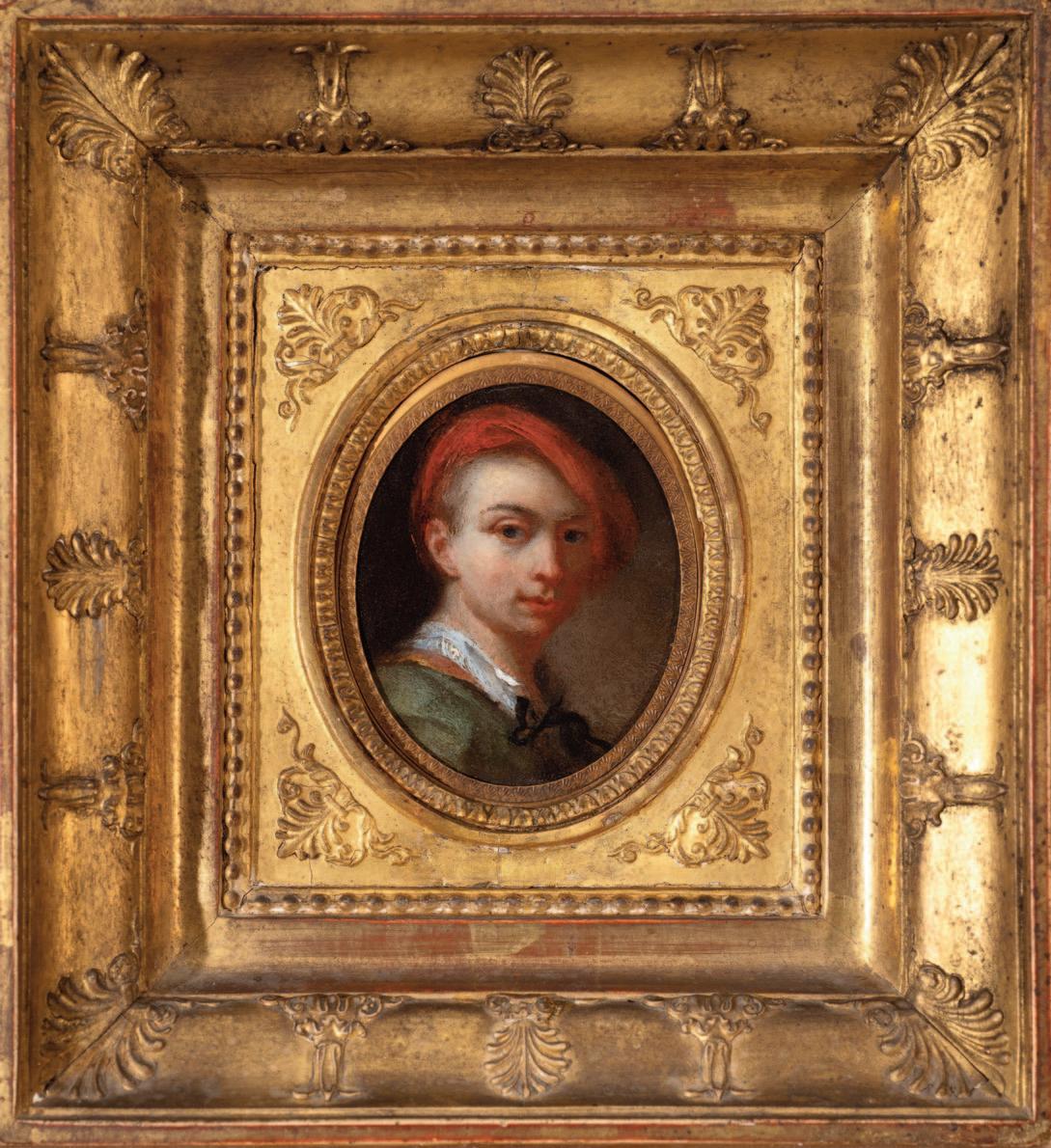
A Lady, wearing ‘Turkish-style’ dress; 1748
Enamel on copper
Signed and dated on the counter-enamel ‘G. Spencer. pinx./1748’
Oval, 44 mm (1 ¾ in) high
Gilt metal mount with stamped detail
Provenance
Sotheby’s, London, Silver, Portrait Miniatures, and Objects of Vertu, 7 November 1996, lot 226. Bonham’s, London, Fine Portrait Miniatures, 23 November 2005, lot 32; Private Collection, UK.
This miniature is an example of how Gervase Spencer excelled at painting portraits of women in enamel. As a miniature painter, he also worked on ivory, though most of his portraits were on copper, or sometimes gold, using the difficult medium of enamel. The unidentified woman in this portrait wears fashions inspired by the Ottoman Empire, which were also common amongst portraits of women by Spencer. A notable comparison is the portrait of another unknown woman in the Victoria and Albert Museum1, previously identified as Lady Mary Wortley Montagu (1689-1762).
Britain had a long history with the Ottoman Empire, being one of the first countries to establish an embassy in Istanbul in 1535. In the 1740s, the war of Austrian Succession meant that British troops were fighting closer to the Ottomancontrolled Mediterranean2. Though this did not spell good news for British-Ottoman relations, it did mean that more and more British men were gaining exposure to the cultures, and more importantly in this case fashions, of the empire. The robe that the lady in this miniature wears is known in Turkish as a Kurdi, and typically takes the form of a floor-length robe trimmed with fur. Such robes became popular amongst western women, as did hair turbans, also seen in this portrait.
Whereas later works were often signed on the obverse, this miniature has been signed and dated on the counter-enamel. Therefore, it is a rarer and earlier example of Spencer’s work. He became known for his fashionable portraits, and this is certainly not an exception. Though the colours of the woman’s outfit are more subdued than in other examples, such as the V & A portrait, she has still been depicted as a glamorous and wealthy sitter.
1 Victoria and Albert Museum, London, accession number P.4-1943.
2 M. Talbot, British-Ottoman Relations, 1713-1779: Commerce, Diplomacy, and Violence, Gale Internation, online at https://www.gale.com/intl/essays/michael-talbot-british-ottoman-relations-17131779-commerce-diplomacy-violence


A Gentleman, believed to be James Dunlop of Garnkirk (1741-1816), wearing a green coat, embroidered waistcoat, solitaire, and white stock, with pink powdered hair; 1770
Watercolour on Ivory
Signed with initials and dated ‘J.S/1770’
Oval, 40 mm (1 ½ in) high
Provenance
The family of the sitter; Moore Allen & Innocent, April 2005; Private collection.
James Dunlop of Garnkirk has been identified as the sitter of this portrait through an inscription that was sold with the miniature when it left his descendants’ collection in 2005. There are other portraits known to depict the sitter, including one by George Romney (1734-1802), sold from the Paul Mellon collection in 1989.
The son of Colin Dunlop, Lord Provost of Glasgow, James purchased Garnkirk from his uncle, also James. Four years following the completion of this miniature, he would marry his cousin, Marion Buchanan of Mount Vernon (1754-1828), the daughter of George Buchanan of Mount Vernon (1728-1762) and Lilias Dunlop of Garnkirk. There are some focal differences between the portrait by Romney and this miniature, however this could be down to artistic licence, and a difference in the age of the sitter at the time of both of these portraits.
One of the most notable features of this portrait is the colour of Dunlop’s hair. Coloured powder, in this case pink, was fashionably applied to wigs in the late 18th century by both men and women. Though we are mostly used to seeing this done with white powder, many portrait miniatures by Smart provide examples of just how many different colours were also used. Contemporary advertisements attest to the fact that various colours and scents in powder were available.
In 1770, Smart was at an early stage in his career as a miniature painter, but clearly already fluent in the highly detailed, highly coloured portraits he would become renowned for painting. Not only has he managed to capture a fine level of textural details across the different fabrics that the sitter wears, but Smart has also created an immense amount of depth in Dunlop’s complexion. If this is who the portrait depicts, the miniature may have been presented to Dunlop’s wife as a wedding gift, to be worn around her wrist or on her person.

A pair of portraits, probably Husband and Wife; circa 1779
Watercolour on ivory
Gold frames
Ovals, 67 mm (2 ⅝ in) high (2)
Provenance
Sotheby’s, London, 7 February 1996, lot 236; Private Collection, UK.
It is extremely rare to find a surviving pair of portraits given their reciprocal purpose. Here, a pair of portraits, likely showing husband and wife, have been painted in a relatively large format as a duo and may have always hung together. Although we do not know the names of the sitters, the miniatures, based on their costume and technique, would appear to date to the late 1770s when Meyer was at the height of his career.
Born in Germany, Meyer moved to England at an early age and settled with his family in London. His early training was with the enamellist Christian Friedrich Zincke, but his mature works, such as these, display little of the hard, stippled bright colours of enamel painting. Instead, Meyer was one of the first miniaturists to exploit the support of ivory, using transparent washes to allow the delicate tones of the ivory to show luminescence through the paint. He only used opaque colours for detail – the thicker white paint used here to describe the delicate lace of the lady’s cap and gentleman’s cravat is typical of his technique.
Meyer was the oldest of a group of artists, including Richard Cosway, John Smart and Richard Crosse, all born around the same date, who attended William Shipley’s new drawing school, the first such school in London. After his expensive apprenticeship with Zincke, it seems that he also spent time at the informal St. Martin’s Lane ‘Academy’ run by William Hogarth. As one of the founding members of the Royal Academy, which opened in 1769, Meyer was one of a new generation of miniaturists who would present their art form in direct competition with oil painters. In 1774, one critic noted ‘[His] miniatures excell all others in pleasing Expression, Variety of Tints and Freedom of Execution’.
In 1764, Meyer was appointed miniature painter to Queen Charlotte and painter in enamel to King George III. This secured his place as primary miniaturist for the royal family and improved his ability to secure this position as he was much in demand. The scale of this pair would have been rare at this date and suggests an expensive commission of importance.


Mrs Fenton, wearing a white dress, a red surcoat trimmed with ermine, a drop-pearl brooch and sapphires at her corsage, her upswept, powdered hair dressed with white ribbon; 1774
Watercolour on ivory
Signed and dated, ‘J.S . 1774’
Associated gold frame with red guilloché enamel and rough-cut diamond surround
Oval, 51 mm (2 in) high
Provenance
The Rt. Hon. The Earl of Lanesborough; Sotheby’s London, 15 July 1968, lot 77 (as ‘unknown Lady’); Christie’s London, Important Portrait Miniatures Including the Walter and Gertrude Rappolt Collection, 14 October 1998, lot 68 (as ‘a young Lady’); Karin Henninger-Tavcar, 1999; Private Collection, Germany; Philip Mould & Co., 2014; Cheffins, The Fine Art Sale, 30 November 2016, lot 839 (as ‘a Lady’); Cheffins, 9 March 2017, lot 422 (as ‘a noblewoman’); Private Collection, UK.
Exhibited
Philip Mould & Company, John Smart: A Genius Magnified, 25 November – 9 December 2014 (as ‘a Lady’).
Literature
Foskett, D., John Smart: The Man and His Miniatures (London: Cory, Adams & Mackay, 1964), p.66; E. Rutherford et. al., John Smart: A Genius Magnified, Philip Mould & Company, 2014, cat. no. 13, pp. 38-39 (as ‘A Young Lady’).
The present sitter can be identified from a pair of preparatory drawings depicting ‘Mr and Mrs Fenton’. The drawings have now been separated, with the preparatory work for the present miniature now in the Albertina Museum, Vienna, and Mr Fenton’s drawing having been sold at Galerie Bassenge, Berlin in 2022.12A Mrs Fenton is recorded among Smart’s known sitters in Daphne Foskett’s monograph, although no date is given, and a Mr Thomas Fenton recorded and dated 1776.3 The present finished miniature is dated 1774 and it is therefore likely that the drawings became a pair at a later date.4 It may be that it was only after this miniature was presented to her husband – possibly as part of their courtship or betrothal - that he decided to sit for the same artist who had captured her so beautifully.
John Smart has been described as ‘the finest miniaturist in 18th-century Britain’; no major collection of miniatures can be considered complete if this artist is not represented.5 He was still a young man when he painted this portrait, and his career was progressing steadily. Having exhibited at the Society of Artists since 1762, he was made Director in 1771. Later, he would be appointed Vice President in 1777 and President in 1778. He was working in an affluent area of London and a decade later would travel to India, one of many British portraitists who journeyed there in search of the lucrative patronage of the ‘wealthy English residents and native princes’.6 Indeed he was appointed miniature painter to the family of the Nawab of Arcot and was in great demand.7 Smart returned home in 1795 and exhibited at the Royal Academy in 1797 until his death in 1811.
1 Illustrated in Keil, N., Die Miniaturen der Albertina in Wien, Vienna, 1977, pp.47-48, n° 41.
2 Galeria Bassenge, Berlin, Old Master Paintings, 1 December 2022, lot 6044.
3 Foskett, D., John Smart: The Man and His Miniatures (London: Cory, Adams & Mackay,1964), p.66.
We are grateful to Dr Bodo Hofstetter, curator of the Miniatures Cabinet in the Museum Liaunig, Neuhaus, Carinthia, for identifying the sitter of this portrait.
4 Smart’s preparatory drawings were likely left in the artist’s studio after his death and later sold, some being cut down and framed like oval miniatures. Many were passed down through the generations and eventually sold at auction in the 20th century.
5 Rutherford, E., & Hendra, L., John Smart: A Genius Magnified (Philip Mould & Company), a catalogue for the exhibition held at Philip Mould & Co. 25 November – 9 December 2014, p.8
6 Foskett, D., British Portrait Miniatures (The Hamlyn Publishing Group), 1968 edition, p.112.
7 Ibid.

A Lady, almost certainly Suzanne Elisabeth de Gaulmyn (1752-after 1804), Countess-Canoness of Saint-Denis Church, Alix (later married name Puy de Semur), wearing white satin dress, a red moiré silk sash, an order and gold epaulette, seated, holding a letter in her right hand and her left arm resting on a table with marble top, maroon covered book beside her; blue silk curtain background; circa 1777
Watercolour on ivory
Silver frame stamped with a coin pattern
Circular, 75 mm (3 in) diam.
Provenance
Christie’s, London, 24 May 2000, lot 100 (as ‘A fine miniature of a young lady called the Chanoinesse de Golmin’); Private Collection, UK.
Previously called the Chanoinesse de Golmin by Christie’s, London, this fascinating portrait shows a young woman, who can now be identified as Suzanne Elisabeth de Gaulmyn.1 Like many other teenage girls, she became a noble canoness at St Denis in Alix (in the Lyonnais region of France). In 1771, Suzanne entered the ‘Chapter’ of the church, after the highly selective process to prove her nobility.2 At the age of 23, in 1775, she left to marry Jacques Augustin du Puy de Semur, a musketeer in the King's Guard, which she did in 1777.3 The portrait here likely marks the occasion of her marriage, but she still wears the insignia of her Chapter: an enamelled gold cross attached to a ribbon worn as a sash for church services.
The option of entering a Chapter would have had much appeal to young women of the period, where choices were limited to the authority of a husband or a bishop. A canoness, however, remained free to determine her own destiny. Upon entering the Chapter, she would acquire the title of Countess, and kept it for the rest of her life, whereas in civilian life she lost (unlike her brothers) her father’s title of nobility to take that of her husband. She was not cut off from the world and regularly stayed with her family. At the age of 25, she could choose to return to live in the society with which she had not broken ties, or took vows, and from then on was able to benefit from a portion of the Chapter’s income. Once a professed canoness, a semi-religious, semi-worldly lifestyle could be lived until her death.
During the Revolution, the chapters, which combined clergy and nobility, were the first to be dissolved. The canonesses of Alix fought to keep
their houses and their income, but many returned to their families, and their houses were eventually sold as national property.
The traditional identification of the artist of this portrait as the elusive Nicolas Hallé still stands. The painting of the silks of the sitter’s dress fit with the description of his painting by Bernd Pappe, given when discussing a miniature attributable to Hallé in the Tansey Collection. Pappe states that Hallé’s miniatures ‘show an individual painting style which is easily recognised: the facial features are painted very precisely and sharply, the face is often directly turned to the viewer, and the clothes appear almost metallic because of the conspicuously placed highlights with their rich contrasts. Fur ther hallmarks of his style are a mouth that appears pinched because of the narrow brown dividing line of the lips, together with striking red accents in the corners of the eyes’.4
This portrait of the Countess de Gaulmyn is typical of the clientele who were attracted to Hallé’s precise yet grand style of miniature painting. Apparently married to a Baroness, Hallé found a patron in the Duc de Penthiève (1725-1793), the illegitimate grandson of Louis XIV.
Hallé was working at the same time as the successful artist Pierre Adolphe Hall. The similarities in their names, techniques and statuses as artists caused some confusion and rivalry, culminating in an incident where, one year after the outbreak of the French Revolution, Hallé’s wife had allegedly thrown apples from her opera box on patriotically minded fellow citizens, but the blame was cast on Hall’s wife.
1 This identification is a new reading of a handwritten old label on the backing paper, which previously identified the sitter as ‘Chanoinesse de Golmin trisaïeule de Ary Chevallier homme de lettres’. The spelling of ‘Golmin’ is phonetic for ‘Gaulmyn’ and her identity is further proved by the order of the Chapter of a canoness of Alix that she wears on her sash.
2 Before the letters patent of Louis XV in 1753, proof of nobility was testimonial, but the king imposed five generations of paternal nobility. The Chapter’s own statutes, written in 1756, went beyond royal prescriptions and required eight degrees of paternal nobility.
The evidence was presented to the Canon-Counts of Lyon designated by the Prioress of Alix, and studied by a genealogist.
3 Suzanne and Jacques had several children, including Jacques Claude Augustin, born in 1778, Gilbert in 1780, Marie Louise, born around 1781, and Charles in 1783.
4 See https://tansey-miniatures.com/en/collection/10244 (accessed March 2025). Very few signed works are known, but one is illustrated in J. de Bourgoing, Die Französische Bildnisminiatur, Vienna, 1928, pl. 45.

A Lady, Traditionally identified as Viscountess Townshend, later Anne, 1st Marchioness Townshend (circa 1752-1819), wearing a blue fur-trimmed coat, white embroidered dress, her hair powdered auburn and worn up; 1777
Watercolour on ivory
Signed with initials and dated ‘J.S/1777’
Gold reeded frame
Oval, 45 mm (1 ¾ in) high
Provenance
Karin Henninger-Tavcar, 1995, as ‘Viscountess Townshend’; Private collection, Germany; Private Collection, UK.
Literature
E. Rutherford et.al., John Smart: A Genius Magnified, London, 2014, p. 46-47.
Exhibited
London, Philip Mould & company, John Smart: A Genius Magnified, 25 November-9 December 2014, cat.no. 17.
This portrait resembles both another portrait of Viscountess Townshend by Smart and portraits of the Viscountess by Angelica Kauffman (1741-1807) and Joshua Reynolds (1723-1792).1 The second portrait by Smart is illustrated in Foskett’s 1964 monograph of the artist, and bears the date 1775.2 In both miniature portraits, she wears a high updo, fur-trimmed coat and a similar style of dress underneath. However, the sitter in the present example is much more subdued in her style, possibly reflecting a change in her lifestyle following some years of marriage since the first portrait was painted.
Anne was the second wife of George, 4th Viscount and later 1st Marquess Townshend (1724-1807). She had been born to Sir William Montgomery, 1st Baronet of Magbiehill (1717-1788) and Hannah Tomkyns in the early 1750s, and was known for her beauty, something that is certainly reflected in this work. Smart had an incredible amount of skill in depicting fine details, such as the sitter’s eyelashes and the baby hairs framing her face. The result here is an extremely delicate rendering of Anne, who gazes softly out of the frame of the portrait. She adopts the same position in Smart’s earlier portrait, though this is slightly larger, so it is possible that the second version was commissioned as a more portable and intimate option.
John Smart painted similarly skillful portraits of important members of society throughout his career as a miniature painter. These included, for a period beginning in 1785, citizens in India, where he travelled to continue receiving commissions at a time when portrait miniatures were popular amongst members of the East India Company. His bright, lifelike, and sensitive works are seen as some of the finest examples of miniature painting of his period.
1 D. Foskett, John Smart: The Man and His Miniatures, London, 1964, p.36, ill. fig.29, plate X; At Burghley House, reference PIC155.
2 At M H De Young Memorial Museum, San Francisco, 75.2.13.
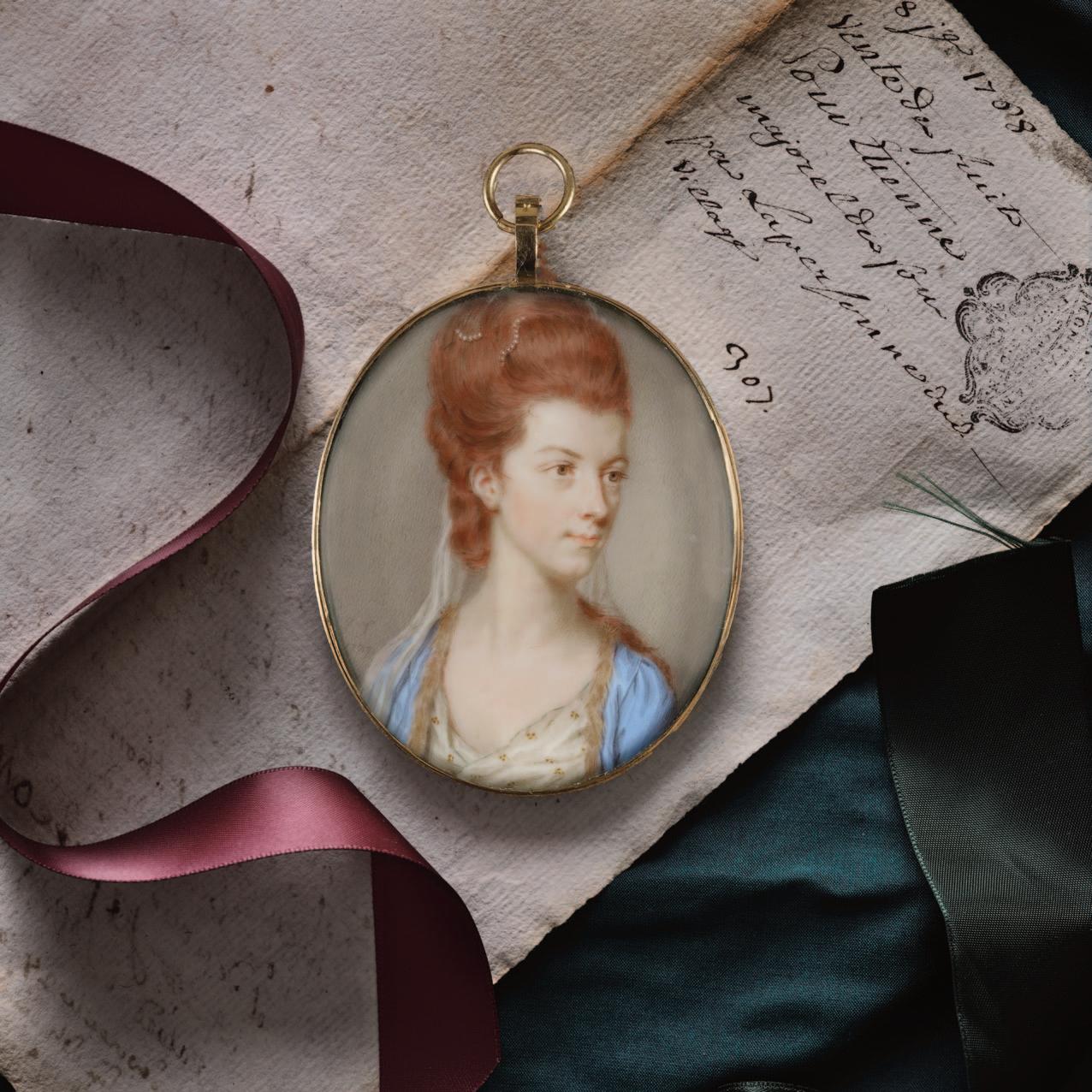
Lady Betty (Elizabeth) Foster (née Hervey) (later Cavendish) (1757-1824); circa 1787
Watercolour on Ivory
Oval, 50 mm (2 in) high
Provenance
Possibly collection of Sir Augustus William James Clifford, 1st Baronet (1788-1877); By descent to Lord Charles Walter James Dormer (1903-1975);
Christie’s, London, 27 March 1984, lot 165 (as Henry Edridge after Sir Joshua Reynolds); Christie’s, London, 21 April 1998, lot 71.
Literature
Dorothy Margaret Stuart, Dearest Bess: The Life and Times of Lady Elizabeth Foster, afterwards Duchess of Devonshire from Her Unpublished Journals and Correspondence, London, 1955, ill. op. p. 116.
The sitter in this portrait, Lady Elizabeth Foster, born Hervey and later Cavendish (from 1809), led an extremely interesting life, the story of which has since been told through films, books, and television. Born in Suffolk, her childhood was not a prosperous one. In 1776 she was married to Thomas Foster (d.1796), an Irish MP. She had two sons with Foster, but the marriage was not happy and soon ended.
Only a few years after her separation from Foster, she became acquainted with William Cavendish, 5th Duke of Devonshire, and his wife, Georgiana. Their relationship soon developed into a ménage à trois, and in 1786 Elizabeth gave birth to William’s son. The affair had not ruined her relationship with Georgiana, however, and when the Duchess fell pregnant with another man’s son, Elizabeth followed her in her exile. When Georgiana died in 1806, she named Elizabeth as the sole guardian of her papers, meaning that her future was secured. Only three years later, she married the Duke of Devonshire.
The trio became known due to the questions surrounding their relationship at the time, which has remained a subject of intrigue since. In 2008, the film ‘The Duchess’, featuring Kiera Knightley, Ralph Fiennes, and Hayley Atwell as Elizabeth, was released and follows the relationship from the perspective of Georgiana. For contemporaries, the gaudish and scandalous behaviour, particularly of Georgiana and Elizabeth, was often satirised and the subject of comment. Aside from being involved in this scandal, they were society hostesses, with Georgiana responsible for receptions at Chatsworth. This exposure meant that their relationship became well known in society. Both Elizabeth and Georgiana were painted by numerous important artists from the period, including Angelica Kauffman, who painted Elizabeth only a year before this miniature is presumed to have been painted.1
According to George Engleheart’s fee book, he painted 3 portraits of a ‘Forster, Lady E’ in 1787. The miniature has previously been sold as by Henry Edridge, but sits much more comfortably within the oeuvre of Engleheart, and matches the other two portrait miniatures painted by him. Though the spelling of the surname is different, transcriptions of his fee book consistently spell the surname in this way, and there are no ‘Fosters’ included, and it is certain that he painted Foster. Historically, then, it has been assumed that the present work is one of those recorded to have been painted in this year.
This implies that there are two other existing versions of the same miniature, by Engleheart. The location of one of these is unknown. Another is recorded in an image from the Courtauld Institute. Last sold in 1958, this other version varies slightly from the present work given that Elizabeth’s ribbon is much less vibrant. Intriguingly, this other version has the initials GD and EF on the reverse, likely to stand for Georgiana Devonshire and Elizabeth Foster. The present version is the third, illustrated in
Dorothy Stuart’s 1955 book ‘Dearest Bess’.2 Stuart quotes in the illustrated table3 that this miniature, as family lore goes, was continuously carried around by her illegitimate son with the 5th Duke of Devonshire, Augustus Clifford, who was born the year after it was produced. Therefore, it is possible that these three miniatures were commissioned by Elizabeth for her loved ones, the version sold in 1958 intended for Georgiana and the lost version for William, and that the present version was intended to be given to Augustus.
Though there is no further evidence for this theory, it would make sense given the nature of the relationship between the Duke, Duchess, and Bess. At this point in time the affections felt by the Duke for Bess were only increasing, emphasised by the distance created by her leaving in 1788 to give birth to Clifford.
The identification of works by George Engleheart is helped greatly by the fact that he recorded many of his sitters in his fee book, which has since been transcribed. Born at Kew in 1750, Engleheart was one of the most well-known and successful miniaturists of his day. He enjoyed commissions from many important members of society, including King George III. The present work hails from the period of Engleheart’s career during which he had become well-established and was in high demand for his likenesses. This example, being a copy of a larger portrait by Reynolds, is somewhat unusual, but the artist is unlikely to have wanted to turn down a commission from such an important patron.
1 Angelica Kauffman (Chur 1741- Rome 1847), Lady Elizabeth Christiana Hervey, Lady Elizabeth Foster, later Duchess of Devonshire (1759-1824), oil on canvas, 127 x 101.6 cm. (50 x 40 in.), Ickworth Collection, Suffolk, NT 851738).
2 Dorothy Stuart, Dearest Bess: The Life and Times of Lady Elizabeth Foster, Afterwards Duchess of Devonshire, from Her Unpublished Journals and Correspondence, London, 1955, opp. p. 116. It should be noted that Stuart dates the miniature to 1788, however it can be assumed that Engleheart gave the correct date in his fee book.
3 Ibid., p. XIII.

The Cavendish Children, probably Harriet (1785-1862) and Georgiana (1783-1858), as children; 1795
Watercolour on ivory
Signed and dated ‘Grimaldi R.A. 1795’1
Gilt-metal frame
Oval, 78 mm (3 in) high
Provenance
The artist, found in his desk upon his death in 1830; Private collection.
Exhibited London, An Evening Soiree at King’s College, 1857; London, Ironmongers Company Fine Art Exhibition, May 3-5 1861.
Literature
A.B. Grimaldi, ‘A Catalogue, Chronological and Descriptive, of Paintings, Drawings, & Engravings by and after William Grimaldi’, p. 17, no. 56.
William Grimaldi, born in Shoreditch, London, in 1751, was known for copying the works of other artists, as he has done here. Specifically, he copied from multiple works by Joshua Reynolds (17231792), and it is recorded by the artist’s descendants that the present work is also a copy from a Reynolds composition, though this original composition has not been traced. Grimaldi trained under Thomas Worlidge (1700-1766), who is believed to have been the artist’s uncle.
The descendants of the artist record in their catalogue of his works that this miniature depicts ‘Lady Georgiana and Lady Harriot Cavendish’, the title coming from an inscription by William himself. Two miniatures of the same subject are listed in the catalogue. The first was painted in 1795 as a commission by the father of the sitters, William
Cavendish, 5th Duke of Devonshire (1748-1811)2
The second, being this portrait, is recorded in the catalogue as being painted in 1796.3 It appears, then, that Grimaldi had become attached to the image and decided that he wanted to keep a version of this for himself.
A closer look at the children in the portrait however, has led to the suggestion that this may not be a portrait of two daughters, but rather of Harriet and her younger brother William (17901858). The ages of these children would make more sense, given that they would be 5 and 10, respectively, matching the apparent age of the sitters here. Furthermore, the younger child wears what appears to be a skeleton suit, usually only worn by young boys in his period. However, given that the original title was taken from the artist directly, it should be assumed that the original identification was correct.
The children’s parents, the 5th Duke and Duchess of Devonshire, are probably best known for their ménage-a-trois with Lady Elizabeth Foster (17581824)4, who would become their stepmother upon their mother’s death in 1806. As the eldest child of the Duke and Duchess, Georgiana was a favourite of her mother, also Georgiana (1757-1806), and the intimate relationship between the two is recorded in a portrait by Reynolds, at Chatsworth House. In 1801, she was married to George Howard, Viscount Morpeth (1773-1848). Following the marriage, Georgiana lived at her husband’s family home, Castle Howard, in North Yorkshire. Harriet was not as favoured as her sister, and was only married once her mother had died. In keeping with the complex and unconventional relationships of the Cavendish family, this was to her aunt’s lover, Lord Granville Leveson Gower (1773-1846).
Despite the strange context of the match, the two had a loving relationship, and Harriet had even lived with Gower in Paris while he was an ambassador there. It is quoted that Harriet was ‘no beauty, [but] she had wit, intelligence, and shrewdness’. William, as the only son of the Duke and Duchess, succeeded to the Dukedom upon his father’s death in 1811. Aside from his numerous political positions, including Lord Chamberlain of the Household (1827-8, 1830-34 and Ambassador Extraordinary to the Russian Empire (1826), William had a passion for horticulture and was known for being extravagant and charming.5
These later lives are very far from the lives these children were living when this miniature was painted. It should be noted that Grimaldi was not the only portrait miniaturist to have painted the children of the Duke; multiple versions by Richard Cosway (1742-1811) are also known.6 However, this miniature differs in its unfinished nature, which is likely to be because Grimaldi was painting it for himself. This gives the portrait a translucent quality, and the sky background is almost visible through the clothes of the two children.
1 Grimaldi was not a Royal academician, but erroneously styled himself as a member of the Académie Royale (Oxford Dictionary of National Biography, ‘Grimaldi, William’).
2 A.B. Grimaldi, ‘A Catalogue, Chronological and Descriptive, of Paintings, Drawings, & Engravings by and after William Grimaldi’, p. 17, no. 56.
3 It should be noted that this date differs from that on the miniature itself. This is likely due to a previous misreading of the signature.
4 The sitter of cat.no. 20.
5 Chatsworth Website, William Spencer Cavendish, 6th Duke of Devonshire (1790-1858), accessed 26 March 2025.
6 One of which was exhibited at the Royal Academy, London, Exhibition of British Art, 1934, no. 1054, lent by Earl Spencer, Althorp.
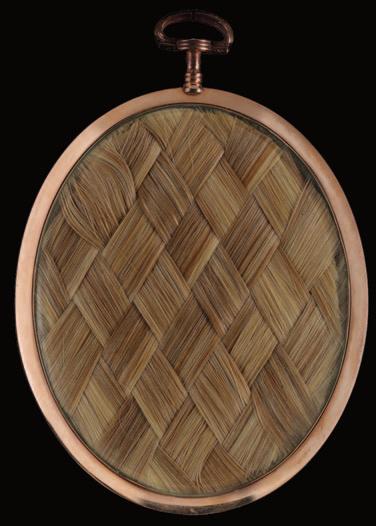
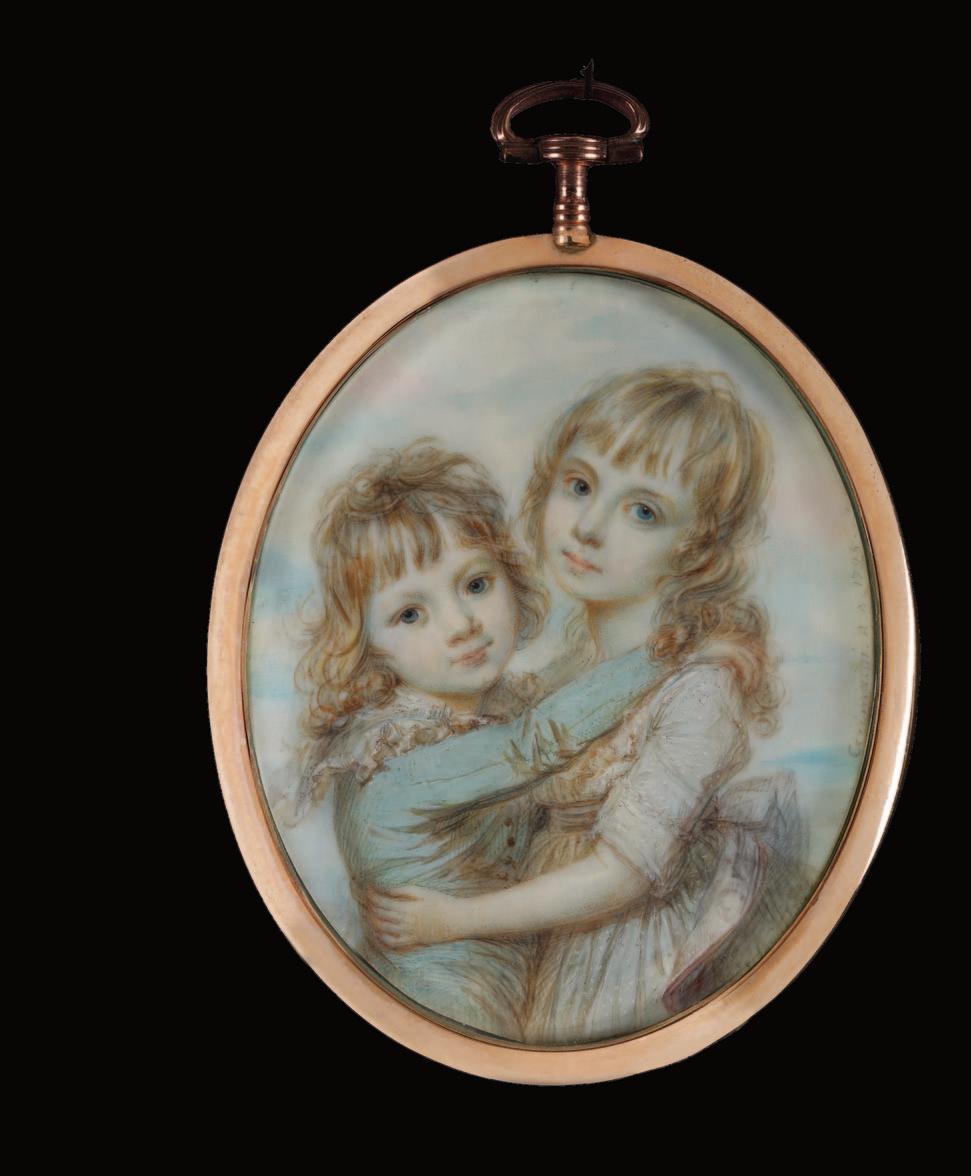
William Henry West Betty (1791-1874), ‘The Young Roscius’; circa 1804/5
Watercolour on ivory
Inscribed in verso:
‘Through all life’s varied scenes preserved Endear’d by kindred love most true, This simple braid, with fond regard, Affection's glistening eye shall view.’1
Circular, 45 mm (1 ¾ in) diam.
Gilt metal frame with hairwork reverse
Provenance Private Collection.
William Henry West Betty, known as ‘Master Betty’ or ‘The Young Roscius’ gained sudden fame between 1804 and 1805 as one of Britain’s greatest actors. As a twelve year old, he had debuted to audiences in Belfast, and was soon swept on a tour across Britain. In Scotland, he was first referred to as ‘The Young Roscius’, a reference to the famous actor from Ancient Rome. Following appearances across the country, Betty first appeared in London in 1804. Here, he played at both Covent Garden and Drury Lane, the two largest competing theatres in the city.
This profile portrait - suitable in its neoclassicism to portray ‘The Young Roscius’ - was likely painted by Engleheart in London in 1804. His London performances of this year were infected by ‘Bettymania,’ with stories of audiences trampling the royal boxes being well-recorded. The young actor began to earn up to £1200 a night for his performances, with the nation so infatuated with the young boy that, when he fell ill after his first
London season, there were demands for daily updates on his health. Multiple memoirs of the life of the actor soon appeared, which have resulted in a somewhat confusing narrative of his life, given that none were official. However, the quantity of information that Betty’s fans craved reflects the level of interest in the boy’s life. Not only were people interested in seeing him perform, but also in understanding his beginnings and learning more about who he was as a person.
The phenomenon of ‘Bettymania’ has been the subject of much debate. Though Master Betty was seen as a talented actor, it has also been said that people’s obsession with him, across the country, came from a sense of knowing Betty, as if he were a member of one’s family.2 Engleheart’s miniature is clearly in a different league from much of the merchandise produced around the child star, suggesting that it was either commissioned by a particularly wealthy fan, or by a member of Betty’s family. The bust format may relate to one of the many sculptures created in the wake of Betty’s sudden celebrity. In 1805, two portraits of ‘The Young Roscius’ were displayed at the Royal Academy exhibition, by John Opie (1761-1807) and James Northcote (1746-1831). Unlike this miniature, these are both full-length portraits, and present Betty in costume.
Comparable examples of Engleheart’s work include his unfinished drawing of Sir Robert Abercromby (1784-1855) and numerous examples of his portraits of women in profile.3 One of Engleheart’s most important commissions was in profile - that of Napoleon I (1769-1821), Emperor of France 1804-1814/1815, as First Consul 1799-1804, painted circa 1801.4
Though the picture painted here may seem one of unfailing praise, Betty was not without his critics. Some of the most famous actors of the preceding period, including David Garrick, and Sarah Siddons (who is often quoted as being the first influence for Betty’s acting), refused to perform opposite him. Though it may seem unfair to show disdain towards a young boy, he was becoming popular at a time when both of these actors were becoming older and less exciting than them. Between 1804 and 1806, Betty performed over 100 shows in London.5 In many of these, he played Shakespearean roles, including Hamlet, Romeo, and Macbeth.
Betty’s fame was, however, short lived. Two years after his debut, in 1806, he was received on the stage of Drury Lane by a hostile audience who booed him.6 Two years later, in 1808, he would ‘retire’ at the age of 17.7
1 This inscription notes the hair held in the reverse of the miniature, presumably that of Master Betty’s and greatly valued by the recipient of the miniature, who notes the ‘kindred love’ with the sitter.
2 J. Kahan, Bettymania and the Death of Celebrity Culture, Historical Social Research / Historische Sozialforschung. Supplement, No. 32, Supplement: Celebrity’s Histories: Case Studies & Critical Perspectives (2019), p.146.
3 Previously with The Limner Company.
4 Sold Christie’s, London, Centuries of Style, Silver, European Ceramics, Portrait Miniatures and Gold Boxes, 26-27 November 2013, lot 142 (the version which was likely retained by the artist).
5 J. Kahan, Bettymania and the Birth of Celebrity Culture, Bethlehem, 2010, p. 157-163.
6 Ibid. p.103.
7 Betty returned to the stage later, aged 20, though this was not a great success.
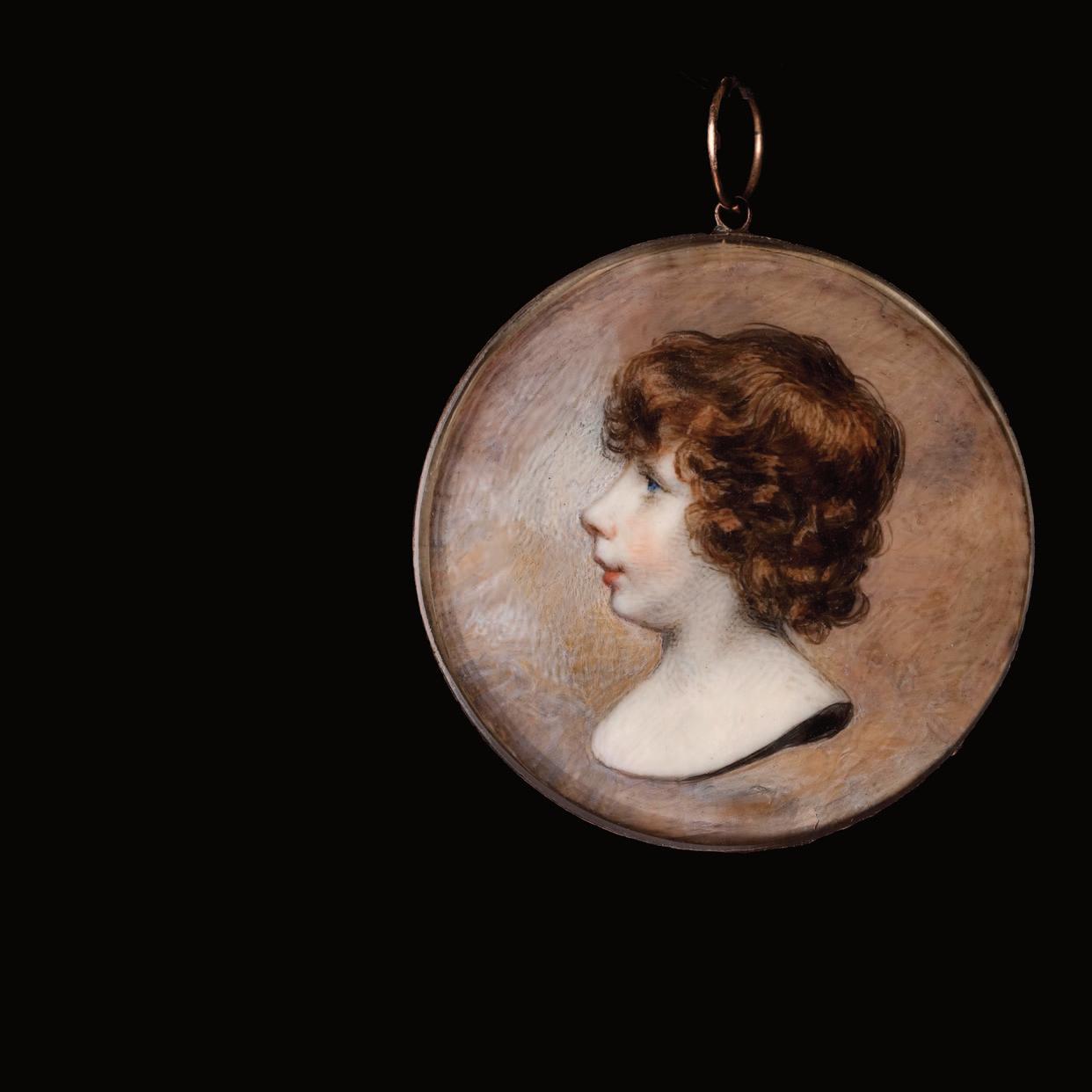

A Lady, standing in a wooded landscape, wearing a white dress with a tiered lace collar and yellow bodice, decorated with bright blue ribbons, flowers in her hair and at her corsage; circa 1770
Watercolour on ivory
Ormolu frame with engraved border.
Circular, 68 mm (2 ⅝ in) diam.
Provenance
Martin Månssons collections (no.218); Private Collection, UK.
Exhibited
‘Fem Stora Gustavianer’ (‘Five Great Gustavians’) exhibition at the Nationalmuseum in Stockholm, Sweden, 3 October – 15 November 1943, no. 218.
Pierre Adolphe Hall was born in Sweden but moved to Germany to study painting in Berlin in 1756, in Hamburg in 1758, and then in Stockholm from 1760 to 1766. By 1769 he was in Paris, where he became an associate of the Academy. His work is typified by his imaginative use of colour and fluid brushwork. He soon gained a following for his work on ivory and enamel. A critic, writing on Hall’s miniatures on the occasion of the Paris Salon of 1777, stated: “Mr Hall attracted the attention of all those who, in enamel and miniature painting, look for the gracefulness in the drawing, the immediacy of the brush and this subtlety of the brushwork, which, while miniaturising the model, bestow new appeal on it”.
The present work, painted circa 1770, would have been an early work during Hall’s settlement in France. Despite his Swedish origins, Hall’s style and subject matter characterised French taste so completely that he is considered one of the greatest French miniaturists of the eighteenth century. This work, painted in gouache, encapsulates the exciting appeal of Hall’s rapid brushwork and vivid colour. Although he excelled at painting women in bucolic settings wearing country-style bodices adorned with fresh flowers, he also painted complex and sincere portraits of some of the most celebrated men of the period, such as the portrait of fellow artist Dominique Vivant Denon (1747-1825).1 In 2023, the Nationalmuseum in Sweden hosted an exhibition of Hall’s work entitled ‘The Mysterious Peter Adolf Hall’, which included some 70 portrait miniatures from the museum’s collection, both by Hall himself and followers who were ‘heavily influenced by his mastery of free style’.
1 Sold Christie’s, Paris, 23 June 2010, lot 65.

Mary Anne Magaret (née Osborn) and Johnson Wilkinson; circa 1782
Watercolour on ivory
Both in gold clasp frames, with details of their marriage inscribed on the reverse
Ovals, both 25 mm (1 in) high
Provenance
With Judy & Brian Harden Antiques; Private Collection, UK.
Given the inscription on the reverse of these miniatures, it is likely that they were painted to commemorate the marriage of Mary Anne and Johnson Wilkinson in 1782. More is known about the life of Mary than her husband, as she was the daughter of Robert Osborn, Chief Clerk of the Admiralty and Commissioner of the Navy, of Chicksands Priory, Bedfordshire.
Though not unknown, pairs of miniatures like the present example are rare for the work of Cosway. The pair are extremely small, and could be held within the palm of the owner's hand. Presumably each one of the couple kept the other’s small portrait, making them a clear example of the intimate and romantic nature of the portrait miniature.
Cosway had entered the RA schools only 13 years before these miniatures are presumed to have been painted, in 1769. Throughout his career he remained a fashionable miniaturist and having portraits painted by him was sought after, especially given that he was employed as the miniaturist to the Prince of Wales in 1786.

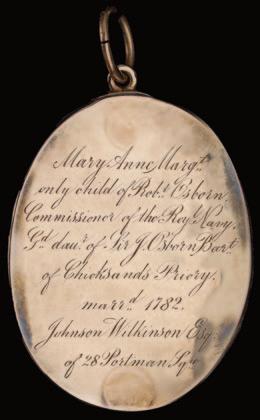
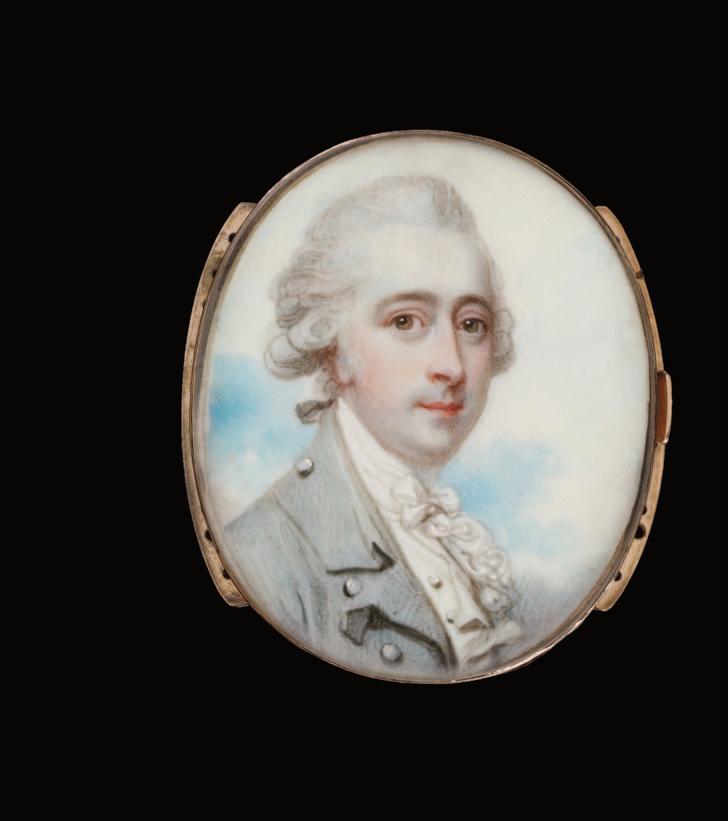

An officer of The Royal Regiment of Horse Guards; circa 1782
Watercolour on ivory
Oval, 57 mm (2 ¼ in) high
Gilt metal frame with hairwork reverse
Provenance
Private Collection.
This sitter can be identified as a junior officer in the Royal Regiment of the Horse Guards. In A History of the Uniforms of the British Army (1966), C.C.P. Lawson not only wrote about the different uniforms being worn in the army but also sketched many of them, taking copies from known portraits, including those by Engleheart. It appears that this miniature was used for exactly this purpose, in the fourth volume of Lawson’s work, to illustrate the officer’s uniform of the Royal Horse Guards of about 1782.1 In the supporting text for the figure, Lawson provided a history of the sitter, stating that he was ‘...an officer, who was Cornet in 1775, Lieutenant 1780, and left after 1782…’. Therefore, he must have been aware of the identity of the officer in this portrait. Unfortunately, that information has since been lost.
George Engleheart was an extremely talented and prolific miniature painter. First trained at the age of 19 in the Royal Academy Schools, Engleheart’s ability to capture personality in the format of miniatures would soon be recognised, and he became a popular option for those who wished to commission a portrait of themselves, or a loved one.
The artist’s use of lighter shades to create the effect of metal thread within the sitter’s epaulette is just one example of Engleheart’s painting skills in this form. We also get a glimpse of the sitter’s character - his left eyebrow is slightly peaked, and his mouth is held in a subtle smirk. Given the handling of the portrait, and the hairstyle worn by the sitter, it can be suggested that this miniature was painted in 1782 at the earliest, hence towards the end of the career of the officer that Lawson describes. If it was painted later than this, it is possible that Lawson was mistaken in the information he was given about the miniature.
We are grateful to Stephen Wood for his advice about the uniform in this portrait.

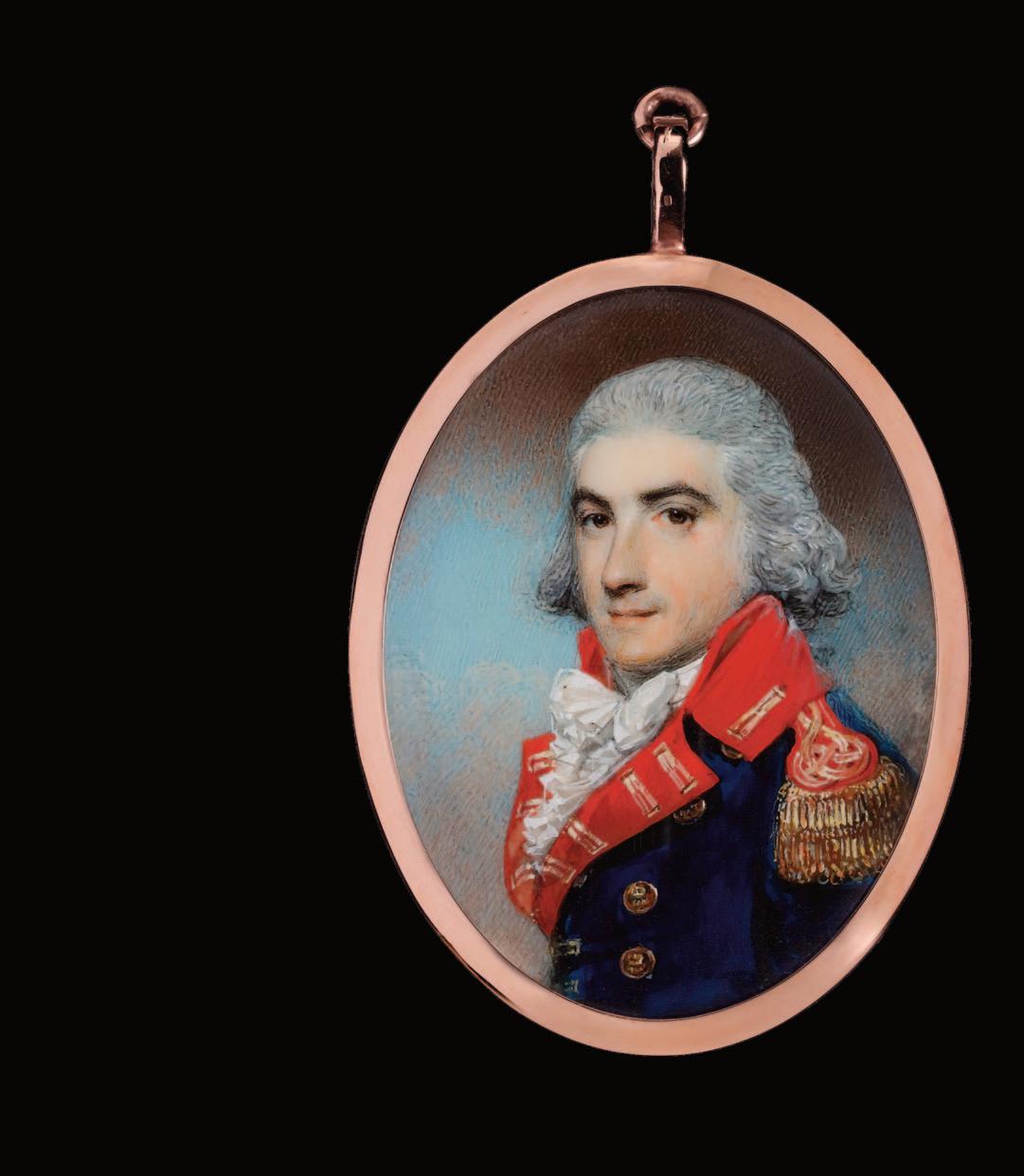
Mary Frances (Fanny) Swinburne (1771-1828), wearing white dress with frilled trim to her decollete, pearl pendant earring, her powdered hair dressed with a strand of pearls and worn ‘a la conseilleur’; circa 1793
Watercolour on ivory
Gilt-metal frame
Oval, 76 mm (2 11⁄16 in) high
Provenance
Before 1930, possibly Leo Schidlof (1886-1966, Paris); Bonhams, London, 21st November 2012, Lot 37 (as ‘A Lady’); Private Collection, UK.
Other versions Cleveland Museum of Art, Edward B. Greene Collection, 1941.553.
Literature for both versions: Winter, Carl. “The British School of Miniature Portrait Painters”. Proceedings of the British Academy v. 34. London: Milford, 1948:. Reproduced: pl. VII; Cleveland Museum of Art. Portrait Miniatures; The Edward B. Greene Collection. Cleveland: The Cleveland Museum of Art, 1951. Mentioned: p. 26, no. 7; reproduced: pl. XVI; Comstack, Helen. “The Edward B. Greene Collection of Miniatures.” The Connoisseur 128, no. 532 (October 1951): 137-144. Mentioned: p. 139; Cleveland Museum of Art, and Alan Chong. European & American Painting in the Cleveland Museum of Art: A Summary Catalogue. Cleveland, Ohio: Cleveland Museum of Art, 1993. p. 282; Korkow, Cory, and Dario Robleto, Disembodied: Portrait Miniatures and Their Contemporary Relatives (2013), p.86; Korkow, Cory, and Jon L. Seydl, British Portrait Miniatures: The Cleveland Museum of Art (2013), Cat. no. 64, pp. 247-249.
Although it has been suggested that Richard Cosway painted Mary Frances (Fanny) Swinburne along with her parents the travel writer Henry Swinburne and his wife Martha in 1786, the hairstyle and clothing indicate this portrait was painted for her wedding in 1793 at the age of 21 or 22. Mary’s future husband was Paul Benfield (1742-1810), a friend of Cosway’s – and in fact the artist attended their wedding in September 1793 at St. George’s in Hanover Square (he signed the marriage register for the couple).
The couple lived at the magnificent Neoclassical house Woodhall Park, Hertfordshire, after Benfield acquired it in 1794 (for the equivalent of £15,000,000 in today’s money). Settling into married life with a huge dowry provided by her parents, Mary cannot have foreseen the dramatic financial ruin that was just around the corner. Benfield - an East India Company employee, financier and politician – was (perhaps generously) described as an ‘adventurer’. He amassed a huge fortune in Madras where he was based from 1764, making his money partly by trade, partly by loans at high rates of interest, and partly through contracts.
Benfield was eventually charged with having aided and abetted the malcontents in the Madras council and he was ordered by the court of directors in 1777 to return to England, where an investigation cleared him. Edmund Burke, who had waged a long campaign over the corruption in the Company, gave a speech regarding the debts of the Nawab of the Carnatic which included an attack on Benfield in which he denounced him as ‘a criminal who long since ought to have fattened the region’s kites with his offal’.
This portrait of Mary by Cosway was painted at a time of huge optimism for the new Mrs Benfield. With her husband Paul settled in their grand estate in England, he had presented her with a ring on their wedding day worth £3000 (or around £500,000 today). However, their happiness was short-lived. While a son and two daughters were born to the couple, their fortune was funnelled into a mercantile firm in London, called Boyd, Benfield, & Co.. For a few years the new venture thrived, but by 1797 it had overreached itself and could not meet its obligations. On 8 March 1799 Boyd, Benfield & Co. was wound up and the partners were declared bankrupt the following year. Boyd gives a glimpse of Benfield’s personality, complaining that his ‘Temper, Disposition, Habits and Pursuits’ made him an impossible person with whom to do business. Mary’s husband, who had promised a secure and happy future, died in poverty in Paris in 1810, their home bought by the Nottingham banker Samuel Smith in 1801.
A version of this portrait, also by Richard Cosway, is part of the Edward B. Greene collection at Cleveland Museum of Art, USA [see ‘other versions’].

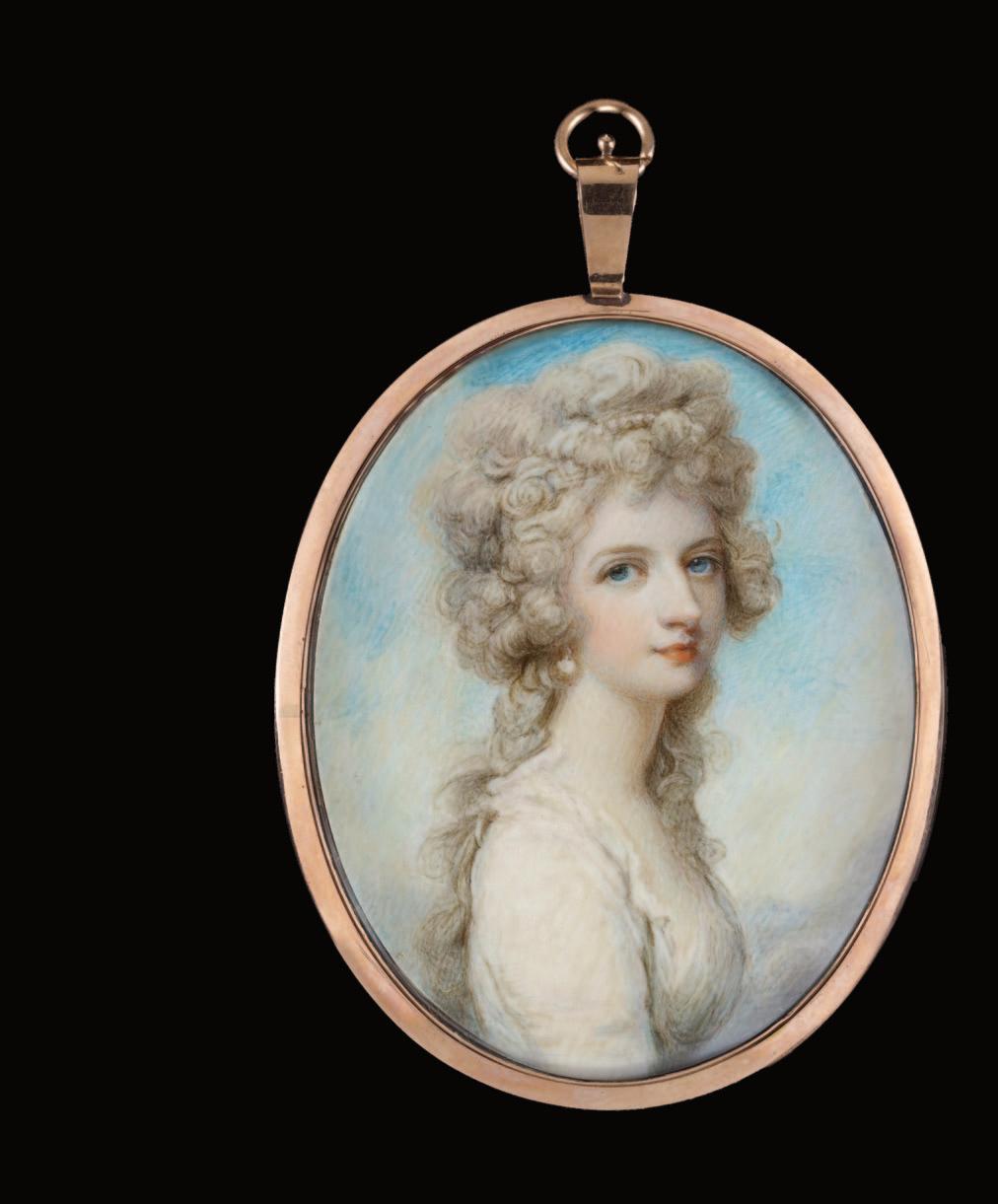
A Gentleman wearing a navy blue jacket with a high buff collar and brass buttons; circa 1785
Watercolour on ivory
Original gold and pearl frame
Oval, 47 mm (1 4⁄5 in) high
Provenance
D.S. Lavender Antiques, 2010; Private Collection, UK.
This portrait of an unknown gentleman by George Engleheart mirrors the pose and swagger of Cosway’s portraits of this period, for example the portrait of a ‘Mr Bradshaw’ in the Cincinnati Art Museum. The slight upward tilt of the head and sky background give a dynamism to these small works of art which were also closer in feel to the larger oil portraits of the period (Engleheart had trained with Sir Joshua Reynolds). This work is a particularly good example by Engleheart and is particularly well preserved in terms of the bright colours.
The care that Engleheart took in every portrait he painted is evident in this work. Over his 39-year career, he is estimated to have painted 4,853 miniatures, and the quality of his work remained consistent throughout. This is astonishing, given that he was working around 70 hours a week (the time it took to paint a miniature is fairly well documented - typically around 35 hours for a head and shoulders portrait).

Miss Courtney, wearing a white dress with a blue sash and a coral necklace, her hair worn with a chain of pearls and powder; 1788
Watercolour on ivory
Oval, 70 mm (2 ¾ in) high
Gilt metal frame with hairwork on the reverse
Provenance
Bulgari Collection; With Judy and Brian Harden Antiques, 2005; Private Collection, UK.
Women’s fashion in the late Georgian era had many distinctive features, some of which can be seen in the present work. Mrs Courtney wears a dress with a low neckline, decorated with ruffles. Her hair, likely a powdered wig, is also worn up and decorated with pearls, a style that was becoming more popular in this period. Her simple, round coral necklace reflects fashionable tastes, and going into the Regency Era such pieces of jewellery would become more and more common.
Engleheart records painting two portraits of ‘Mrs Courtney’ in 1777 and 1788. The sitter’s fashion and style of painting indicate that this miniature was painted at the latter date. It has previously been suggested that this lady is Mary Courtney, née Hallett, who married John Courtney in Dorset in 1788. If this is the lady depicted in the miniature, she would be widowed only a year after her marriage and the completion of the portrait.


Alexander Johnston (1775-1849), aged 15, wearing a black jacket and white stock; 1790
Watercolour on ivory
Signed and dated 1790 with an ‘I’ for India
Oval, 76 mm (3 in) high
Provenance
By family descent; Sale, 1936 (misidentified as Charles Lennox, 3rd Duke Richmond); Private collection, UK.
Alexander Johnston (1775-1849), the British statesman and advocate-general of Ceylon is shown here portrayed by Smart at around fifteen years of age. Descended through the family, this is the first time the portrait of this philanthropic pioneer of indigenous rights has been seen in public. In 1781, the Johnston family boarded an East Indiaman destined for Madras. Alexander’s father Samuel likely had an appointment in the service of the East India Company. Four years later, John Smart, the artist, would also travel to Madras, looking to make his fortune, as Alexander’s father Samuel had, from the growing opportunities in India for the British.
Alexander lived in India from the age of six until the age of sixteen, when he and his family returned to England. While in India, he was taught the missionary Christian Friedrich Swartz and Sir Thomas Munro and, through them, Alexander soon learnt to speak Tamil, Telugu and Hindustani fluently – a fact which would prove essential to his future. At the age of 11, he was offered a commission in the Dragoons which he, or his family, declined.
With England as his new base from 1792, he travelled through Europe while studying law, including Gottingen and Hanover. Far from being willing to settle down in London, he travelled to Ceylon (now Sri Lanka) to become the Advocate General of Ceylon in 1799. In this same year he married Louisa Campbell, who was aged only 17.1
The work that Johnston did in Ceylon was highly praised, and so was his character. In the Gentleman’s Magazine, he was said to be ‘ever conspicuous for his munificent acts, his kindness to the poor, and his endeavours to promote the rising talents of his countrymen’. Having been taught native languages at a young age, he was able to act as an interpreter, and was a strong supporter of native rights. These included a system of universal popular education, religious liberty, and emancipation of slaves. Public
1 Louisa was the only daughter of Captain Lord William Campbell, R.N..
2 For a letter upon the jury system in Ceylon see Bentham's Works, ii. 182–8.
employment was then largely opened to the indigenous population, while Europeans were still permitted to invest in land. Trial by jury was established, and a considerable advance was made in the preparation of a code of law, in which provision was made for the due preservation of the views and usages of Hindus, Muhamadans, and Buddhists.2 When Johnston returned to England in 1819, Lord Grey declared in the House of Lords that his ‘conduct in the island of Ceylon alone had immortalised his name.’ He was also the founder of the Royal Asiatic Society (1823). He died in London on 6 March 1849, and was buried at Carnsalloch, Dumfriesshire, the place where he had been born.
Johnston was a typical sitter for Smart in this period, and the portrait in turn is archetypal of Smart’s work during the second half of his sojourn in India. John Smart had trained as an artist in London, where he created and maintained connections with his sitters, largely of the wealthy middle class. This proved most advantageous for the artist when he made the decision to move to Madras in 1785, where employees of the East India Company, whom he had met in England, also lived. Alexander is shown here slightly flushed, which may have been a consequence of wearing too warm clothing that was intended for the English, not Indian, climate.
At fifteen years of age, Alexander Johnston was already a conspicuously gifted young man. That he went on to live a life far beyond the horizons of most Georgian gentlemen, using his intelligence for altruistic means at a time when many were becoming rich on the spoils of Empire-building, makes for an extraordinary narrative. Johnston was portrayed in later life in popular prints but this portrait of the future advocate for human rights is a fascinating image of him on the brink of manhood, his ideas likely shaped by what he had witnessed as a child in India.

Thomas Augustus Hervey (1775-1796), wearing a dove grey coat and a white cravat, his hair worn down and curled; 1793
Watercolour on ivory
Oval, 77 mm (3 1⁄16 in) high
Signed and inscribed verso ‘R.dus Cosway/ RA/ Primarius Pictor/ Sereniffimi Walliae/ Principis/ Pinxit/ 1793’1
Provenance
John Henry Hervey Vincent Lane (1867–1917), King’s Bromley Manor, Lichfield, Staffordshire; Christie’s, J. H. H. V. Lane sale, 12 December 1912, lot 103; ‘H. I Collection’, no. 923; H. Walters Collection (Baltimore, USA), 6 March 1913;
Parke-Benet, New York, Walters sale, 30 November – 4 December 1943;2 Sotheby’s, London, Alison Uttley sale, 11 December 1978, lot 114 (as portrait of ‘a Youth’);
Sotheby’s, London, 16 April 2008, lot 75 (as ‘portrait of a Young Gentleman’); Sotheby's, London, 1 May 2013, lot 130; Private Collection, UK.
Literature
Sotheby's, Art At Sotheby’s, 1978-79, p.381 (illustrated).
This portrait miniature has been described as ‘certainly one of Cosway’s most distinctive and successful portraits of a male adolescent from the 1790s’.3 It captures a teenager on the cusp of manhood and is made more poignant by the sitter’s premature death in Lisbon, Portugal a few years later in 1796. It may be that this miniature was commissioned in anticipation of his departure.
Thomas Augustus Hervey was born to Thomas Hervey (c.1735-1781) and his wife Elizabeth (née March) (1749-1820) on 15th August 1775. His grandfather was the eccentric politician, courtier and pamphleteer, Thomas Hervey (1699-1775), who was disinherited by his father (the present sitter’s great-grandfather), John Hervey, 1st Earl of Bristol (1665-1751). In this portrait, Thomas Augustus bears a resemblance to his handsome elder cousin, Frederick William Hervey (17691859), 5th Earl of Bristol and later 1st Marquess of Bristol4. His other cousin, the 5th Earl’s sister, was Elizabeth Foster (nee Hervey) (1759-1824) later Duchess of Devonshire [see cat. no. 20].
On his maternal side, Thomas Augustus’s uncle was the writer and art collector William Thomas Beckford (1760-1844). Here, perhaps, might be found the connection to Portugal, as his uncle lived in Portugal 1791-92, 1793-96 (and again later in 1798-99). There was an English community in Portugal, from which his uncle was ostracised following various scandalous relationships, including one with young Viscount William Courtenay (1768-1835), known as the Powderham Scandal. During his second sojourn, which coincided with Thomas Augustus’s visit, it is said that ‘youthful companions were always at hand; on his travels, as he tells us, his cavalcade resembled a caravan on its way to Mecca’.5 Thomas Augusuts may have numbered amongst these companions, likely visiting Portugal on a Grand Tour.6
1 When sold at Sotheby’s in 2013, the inscribed date was listed as ‘1799’.
2 The provenance thus far has previously been given to another version of this portrait, however, considering the fact that the dates precede the known provenance for the current work, there is no reason to believe the portraits are not one and the same.
3 Dr Stephen Lloyd, Curator of the Derby Collection, Knowsley Hall, Merseyside, who assisted the cataloguing of this miniature when sold at Sotheby’s in 2013.
4 JOHN HOPPNER, RA (London 1758 – London 1810), Portrait of Frederick William Hervey, 5th Earl of Bristol and later 1st Marquess of Bristol, MP, FRS, FSA (1769-1859), aged 30
5 Oxford Dictionary of National Biography, vol. 4, 2004, p.734.
6 Other members of this generation of the Hervey family were painted by Cosway in the 1790s and early 1800s, who, as the premier society portrait miniaturist of the age, was the obvious choice for a family of high rank. Three miniatures by Cosway survive in the Bristol Collection at Ickworth (National Trust), the seat of the Hervey family until the mid-20th century. They were part of a group including the present miniature that had belonged to John Henry Hervey Vincent Lane (1867–1917) and were broken-up following his estate sales in December 1912.


An Officer wearing the uniform of an auxiliary infantry or artillery unit; circa 1793-1816
Watercolour on ivory
Gilt Metal Frame
Oval, 77 mm (3 ⅛ in) high
Provenance
Private collection, UK.
The sitter of the present work wears the uniform of an auxiliary infantry, or possibly artillery, unit. Auxiliary units of the cavalry, infantry and artillery were raised in the period in which this miniature was painted for home defence in order so that the regiments of the regular army could be deployed abroad. Though the sitter remains unidentified, some features of his uniform may help identify his regiment. His shoulder-belt plate (which can be seen towards the right of the composition, on his white belt) appears to feature the Prince of Wales’s Feathers. This symbol implies that the officer may have served in a unit from Wales, where the badge is most often featured in uniforms, or in one that used the sub-title ‘Prince of Wales’s’. It has been suggested that this gentleman would have been an officer of Volunteer Infantry or Artillery, rather than one of Militia or Fencibles.
William Wood trained at the Royal Academy Schools, and before his rather premature death, became a founding member of the Society of Associated Artists in Watercolour. His works can often be identified in their background, which tends to fade into a dark brown or black towards the bottom of his portraits. Wood created texture within these backgrounds using short strokes of colour, which create a cross-hatched appearance in places. During his career, the artist made the effort to record the names of most of his sitters, and these can be found within a manuscript at the Victoria and Albert Museum.
We are grateful to Stephen Wood for assisting in the identification of the uniform.

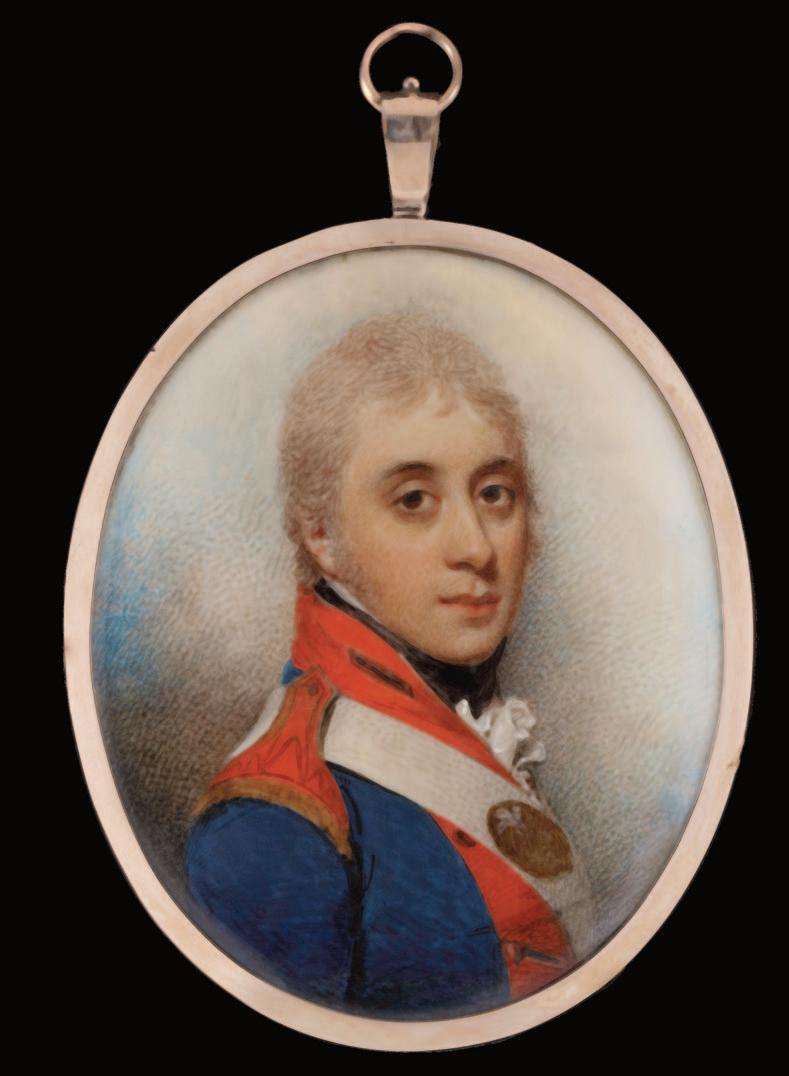
A young Girl, wearing a white dress and black ribbon sash; circa 1790
Watercolour on ivory
Gold frame, glazed reverse with plaited hair
Oval, 73 mm (2 ⅞ in) high
Provenance
Leo R. Schidlof (1886-1996), Vienna, by 1927; Christie’s London, 10 November 1993, lot 52; Sotheby’s London, The Pohl-Ströher Collection of Portrait Miniatures Part I, 6 December 2018; Private Collection, UK.
This portrait miniature most likely depicts a young girl. Although for centuries, young children of both sexes had worn gowns until approximately the age of seven (when boys were ‘breeched’, i.e. adopted men’s clothes), the fashion for children had recently changed. In the 1780s, breeching began to happen earlier, at around the age of three or four, when boys would wear a transitional ensemble in imitation of men’s clothes known as a ‘skeleton suit’.1 At around the age of 10, boys began to wear clothes more closely resembling the suits of grown men, but still looser and more practical versions. Girls, however, tended not to transition into adult forms of dress until around the age of 12 - their later progression from infant clothing indicative of girls’ dependency on their parents. The gowns of young children might also include leading strings –strips of fabric hanging from the shoulders which acted like reigns. These, too, were worn much later by girls than boys, especially in the first half of the eighteenth century when it was not uncommon for girls to still be wearing leading strings in their teens.
The eighteenth-century developments in childrenswear were largely brought about by the Enlightenment. John Locke’s Some Thought Concerning Education, published in 1693 but remaining influential throughout the eighteenth century, and Jean Jacques Rousseau’s Emile, or On Education (1762), both advocated for more freedom and informality in childhood than had previously been considered morally acceptable. This progressive philosophy also concerned clothing.2
A broad sash tied at the waist in a large bow was a typical feature of children’s dress and was paired with both gowns and skeleton suits. Sashes tended to be bright in colour and blue was particularly popular. The black example worn here was less typical and may represent mourning.
Richard Cosway was one of the greatest miniaturists of the late-eighteenth and early nineteenth centuries - the period considered by many to be ‘the heyday’ of British miniature painting. In around 1786, a few years prior to the date of the present portrait, Cosway had been appointed miniaturist to the Prince of Wales (later George IV), who was also a close friend. Cosway was the most sought-after miniaturist in London, and, alongside royalty, he could count the most famous names of the late eighteenth-century among his clientele, including prime ministers, actors and society beauties Georgiana, Duchess of Devonshire (1757-1806), and Emma, Lady Hamilton (1765-1815). Cosway was particularly adept at painting portraits of children, arguably even more so after the birth of his own daughter, Louisa, in 1790. Portrait miniatures of children, particularly from a (relatively) expensive artist such as Richard Cosway, were not often commissioned. Although we do not know the identity of this child, she was likely to have been from one of the aristocratic families of the period.
1 See for example the portrait miniature of an unknown boy, perhaps Sir Frederick Augustus D'Este (1794-1848), by Richard Cosway – Victoria and Albert Museum [P.7-1941] https://collections.vam.ac.uk/item/O75276/unknown-boy-perhaps-sir-frederick-portrait-miniature-cosway-richard-ra/ 2 Reynolds, A., Style & Society: Dressing the Georgians (Royal Collection Trust), 2023, p.143.
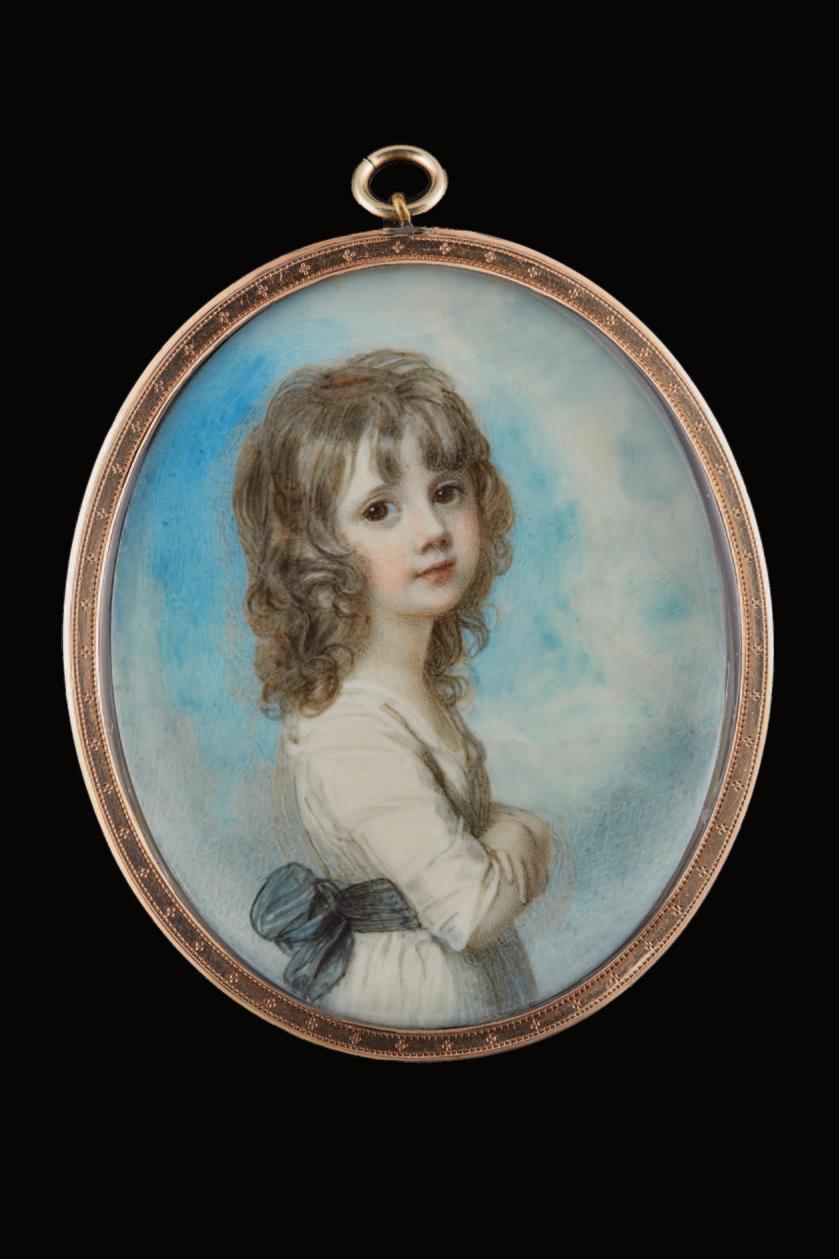
A Major of the 53rd (Shropshire) Regiment of Foot, with gold lace and epaulettes, a frilled cravat, and his hair powdered en queue; circa 1810-1816
Watercolour on ivory
Gilt metal frame with blue silk reverse
Oval, 75 mm (3 in) high
Provenance
Kenneth Guichard, Esq.; Christie's, London, 12 July 1988, lot 203; Collection of Dr. Erika Pohl-Ströher.
In addition to his abilities in portrait and watercolour painting, William Marshall Craig was known for his ability to train and teach other artists. One of his students was Sarah Biffin (1784-1850), [see cat. no. 89], who was introduced to Craig just before the present portrait would have been painted.1 Very few of his portrait miniatures are still known, making this portrait a rare example of his work outside of the artworks of his students. In 1812 he became watercolour painter to Queen Charlotte, and in 1815 he became both the drawing master to Princess Charlotte of Wales and painter to the Duke and Duchess of York. Records of his teaching materials exist, including Instructions for Drawing & Understanding the Human Figure (1817).2
Emma Rutherford has suggested that Craig was a ‘grounded, empathetic, and relatable instructor…’, and some of this empathy is reflected in the way Craig has depicted this gentleman.3 Though his identity remains unknown, his uniform is of the 53rd (Shropshire) Regiment of Foot. Elements of the officer’s uniform provide evidence of the date at which this portrait was painted. The star on the strap of his left epaulette was an element introduced in 1810; it indicates that the sitter was a Major. Therefore, the present work must have been painted after that date and before the significant changes to the style of British infantry uniform coats in circa 1816.
1 See E. Rutherford, E. Smith (eds.), “Without Hands”: The Art of Sarah Biffin, Philip Mould & Company, 2022.
2 Ibid., ill. p. 43.
3 Ibid., p. 41.
The 53rd (Shropshire) Regiment of Foot was one of only two regiments to have scarlet coats faced with red and the only one of the two whose officers had their coats embellished with gold-laced, squareended loops worn in pairs. In 1803, a second battalion of the regiment was raised; it was sent to the Peninsular War (1808-14) in 1809. The first battalion, in existence since 1755, was stationed in India at the date of this miniature. There is no record of Craig travelling to India, so it is more likely that this major was of the second battalion.
We are grateful to Stephen Wood for his advice about the uniform in this portrait.

GUY PEPPIATT started his working life at Dulwich Picture Gallery before joining Sotheby’s British Pictures Department in 1993. He soon specialised in early British drawings and watercolours and took over the running of Sotheby’s Topographical sales. Guy left Sotheby’s in 2004 to work as a dealer in early British watercolours and since 2006 he has shared a gallery on the ground floor of 6 Mason’s Yard, St James’s. He advises clients and museums on their collections, buys and sells on their behalf and can provide insurance valuations. Guy Peppiatt Fine Art exhibit as part of Master Drawings New York every January as well as London Art Week in July and December. He has recently curated an exhibition of early British watercolours at Eton College and held a loan exhibition in the gallery in 2022 - ‘Views of Nature – Four Centuries from Winchester College’. He has regular selling exhibitions in the gallery – recent ones including ‘Dr William Crotch and the Great School of Oxford’, ‘Bristol School of artists 1820-1860’, ‘Charles Gore 1729-1807’, ‘Edward Lear 1812-1888’, ‘British Portrait and Figure Drawings’, ‘John Linnell and his Contemporaries’ and in April 2024 ‘John Ruskin – Drawings and Watercolours from a Private Collection’. He is also a Trustee of Turner’s House in Twickenham.
Sarah Hobrough has worked as a consultant for Guy Peppiatt Fine Art since 2017. Sarah has spent over 30 years in the field of British drawings and watercolours. She started her career at Spink and Son in 1995, where she began to develop a specialism in British watercolours of the late 18th and early 19th centuries. In 2002, she helped set up Lowell Libson Ltd, serving as co-director of the gallery. Since then, she has established a landscape design company, which she continues to run, alongside her art consultancy practice, and worked for Christie’s watercolour department for a number of years.


Portrait of a Gentleman
Inscribed verso: Drawn at Bath 1727/8
Black and white chalks and stump on blue laid paper
32.5 by 28 cm., 12 ¾ by 11 in.
Provenance:
Iolo A. Williams (1890-1962), Kew Gardens, Surrey; Thence by descent
By the time the present, unidentified sitter, sat for his portrait in either 1727 or 8, Bath was beginning to undergo the rapid development which transformed it from the small, largely medieval walled city, with just 3000 residents, into the booming city, central to Georgian society life, with a population of about 35,000 by the end of the century.
Queen Anne began taking the waters in Bath from 1688, which encouraged visitors to come to the city to bathe in and drink the waters. In 1705, ‘Beau’ Nash (1674-1762) was appointed Master of Ceremonies, tasked with overseeing the entertainment and behaviour of Bath’s residents and was instrumental in helping to cement Bath’s reputation, not only as a medicinal spa, but as a popular resort for the wealthy to congregate.
Artists began to visit and to settle in Bath in increasing numbers during the eighteenth century, in order to paint the wealthy visitors and residents. However, when the present portrait was drawn, there were only a few professional artists recorded as being in Bath. The leading portrait painter at the time was Johann van Diest (1695-1767), although Bernard Lens III (1682-1740) visited in 1727 and Bath born, John Robinson (1715-1745), a pupil of Vanderbank (see no. 35) was also in Bath at various points.
In 1728, Van Diest was commissioned to paint a series of thirty portraits of Bath councillors by Field Marshall Wade, MP to celebrate the achievements of the council, in promoting and developing Bath. Several are still hanging in the Guildhall. There are no recorded drawings by van Diest but there are several landscape drawings by his father Adriaan, who had been employed by the Earl of Bath to depict views of the ruins of the West of England. Some of his drawings were in Sir Peter Lely’s collection.
The handling of the face in the present drawing bears some similarity to the work of Michael Dahl (1659-1743). Born in Sweden, Dahl visited London in 1682, following the death of Sir Peter Lely (1618-1680) and after several years travelling in France and Italy, he settled in England in 1689, becoming Sir Godfrey Kneller’s main rival.
Study of a Lady seated on an elaborate Chair
With collector’s mark on backing Pen and grey ink and washes over pencil on laid paper 17.1 by 13.2 cm., 6 ¾ by 5 in.
Provenance:
With Colnaghi & Co. Ltd, London; John Daniel Tilford (b.1978) (Lugt no.4498)
Vanderbank was widely regarded as the natural successor to the pre-eminent portrait painter, Sir Godfrey Kneller (16461723) in whose Academy he studies from 1711. He was also an accomplished draughtsman and developed a parallel career as a notable book illustrator. However, his success was effectively derailed by his love of high living.
Vanderbank’s father had been a Huguenot tapestry weaver who, on his death, left a substantial legacy to his family. This relative wealth appears to have encouraged Vanderbank to adopt the lifestyle of a gentleman and to live well beyond his means. In 1724, he ran away to France to escape debtors’ prison and, on his return, he had to live within the liberties of the Fleet Prison, until his brother Moses was able to discharge his debts.
Whilst at Kneller’s Academy he met the French artist Louis Chéron (1660-1725), who moved to England circa 1695, after studying in Rome. In 1720, Chéron and Vanderbank broke away from Kneller to establish their own Academy at St Martin’s Lane, where studying Old Master Paintings, rather than engravings was encouraged in order to understand human form and posture. Furthermore, a greater emphasis was placed on careful, detailed drawing from life rather than just producing rapid, schematic sketches that had, until then been the usual practice.
The present drawing demonstrates the extraordinary vivacity of line characteristic of Vanderbank’s draughtsmanship. It does not appear to relate to any known portrait.

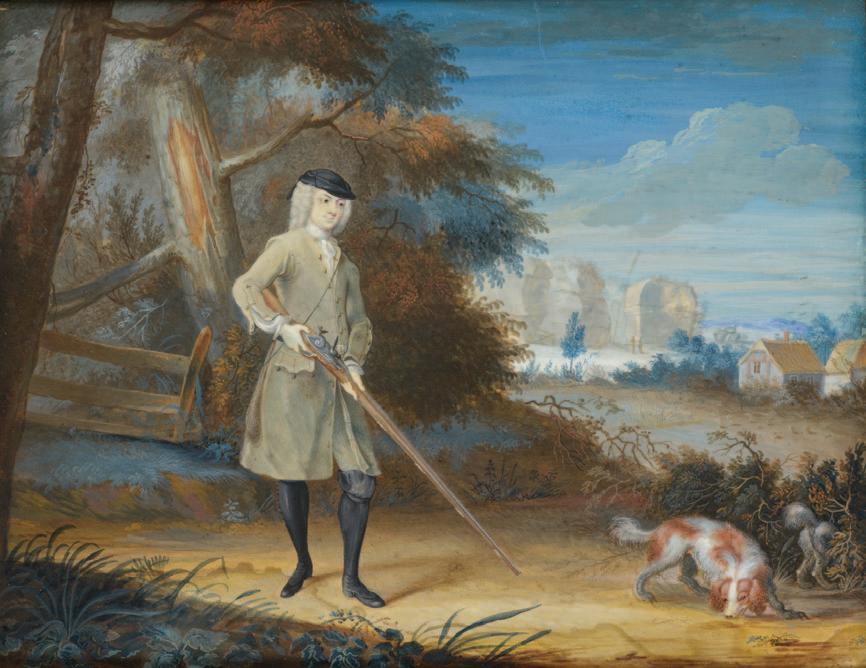
Portrait of a Sportsman with two Spaniels, possibly Charles Hyett (1688-1738)
Indistinctly signed lower right
Gouache on vellum, in an 18th century carved pearwood veneer frame 22.2 by 26.3 cm., 8 ¾ by 10 ¼ in.
Literature: Cathryn Spence, Nature's Favourite Child - Thomas Robins and the Art of the Georgian Garden, 2021 p. 68, ill. fig. 53
As a portrait, this picture is almost unique in Robins’s work and is likely to be of a Gloucestershire landowner. Cathryn Spence dates the work to 1738-40 and
suggests it may depict Charles Hyett (1686-1738) who was MP for Gloucestershire from 1722 to 1727 and lived at Hunt Court, Badgeworth. Thomas Robins was born at Charlton Kings near Cheltenham. Little is known of his early life but he was in Bath by 1760 where he established his reputation as a topographical artist producing views of the city and local grand houses. Robins’s importance is as one of the earliest topographical artists working on paper (or vellum), recording gardens and country houses from 1747 until the late 1760s when few others were doing so. His works are often drawn within a framework of painted intertwining rococo flowers. John Harris describes him as ‘an artist who painted English houses and garden when they were most enchanting; whose eye captured the rococo garden at its perfection and when it was most whimsical; whose paintings are almost sensual in the sheer delight they give; such was Thomas Robins the Elder’ (John Harris, Gardens of DelightThe Rococo English Landscape of Thomas Robins the Elder, 1978, p.1).
We are grateful to the late John Harris and Cathryn Spence for their help in cataloguing this picture. See the website for a longer version of this note.
Portrait of a Lady
Half-length, wearing a pink and white slashed dress Pastel
59.5 by 44 cm., 23 ½ by 17 ¼ in.
In the early 1720s, William Hoare entered the studio of Guiseppe Grisoni, an Italian who had moved to London in 1718. When Grisoni returned to Italy in 1728, Hoare accompanied him. There is some confusion as to whether Hoare stayed in Italy until c.1739, or whether he made two trips; the first lasting until 1732 and then a second trip which ended circa 1738/9. Either way, Hoare’s time in Italy was productive, not only was he able to study the work of the old masters and his contemporaries, but his charming personality and excellent classical education made him popular with the other British in Italy at the time, especially the young gentlemen on their Grand Tours. Thus he met many of the people who were to become his later patrons.
On his return to England, Hoare quickly moved to Bath, where his brother the sculptor Prince Hoare (c.17111769) was based, and where the rapidly growing population meant a ready market for portraits in oil or pastel. George Vertue regarded Hoare as largely responsible for the rise in popularity of pastel painting. He remained based in Bath for the rest of his life, making trips to London and occasionally exhibiting at the Society of Artists and the Royal Academy. His reputation was such that the King, requested that Hoare be made a founding Member of the Royal Academy in 1769.


Inscribed lower centre: Th Seconth Seth [sic] Black and red chalk, heightened with touches of white, on buff laid paper
38.5 by 25.5 cm., 15 ¼ by 10 in.
Provenance:
Major-General Claude Martin (1735-1800); Benjamin Wolff (1790-1866) (L.420), by descent until sold ‘The Wolff Collection’ Sale, Bruun Rasmussen, Copenhagen, 30 May 2018, part of lot 437
Exhibited:
London, Andrew Clayton-Payne, From London to Lucknow, A Re-Discovered Collection of Drawings by Johan Zoffany (1733-1810), 2019, cat. no.20
Zoffany here depicts a pause in a boxing match, presumably drawn from life. The fighter on the right is having his injuries attended to while his opponent on the left takes a swig from a bottle. Behind a group of young boys eagerly watch the fight perched on a pub sign. Boxing had been a popular sport in Britain since the late seventeenth century.
This drawing forms part of a group of fifty-three works assembled by Zoffany in the late 1790s and sent to his friend Major-General Claude Martin (1735-1800). Zoffany had met Martin in India in the mid 1780s. On Martin’s death his collection was sold and the drawings later came into the possession of the Danish lawyer Benjamin Wolff (1790-1866) who lived in Calcutta between 1817 and 1829. Wolff put together an important collection of European and Indian art which he housed at Engelholm Manor on southern Zealand, Denmark. The group remained with Martin’s descendants until they were sold in 2018. Zoffany drawings are rare and fewer than fifty were recorded before the emergence of this group.
for ‘Viscountess Bulkeley as Hebe’
Brown washes over pencil on laid paper
31.8 by 28.8 cm., 12 1/2 by 11 ¼ in.
Provenance: R.C. Harford;
Anonymous sale Christie's, 6th June 1972, lot 90; With Thos. Agnew & Sons (no.28749); Private collection, UK
Elizabeth Harriet Warren (1759-1826), later Viscountess Bulkeley, was the daughter of Sir George Warren of Poynton, Cheshire and Romney painted a group portrait of the family in 1769. Sir George Warren commissioned a further full-length portrait of Elizabeth, presumably to mark her forthcoming wedding, to Thomas, 7th Viscount Bulkeley of Beaumaris (1752-1822) in April 1777. She sat to Romney on five occasions during May 1776, with a final sitting in December (Romney had fallen ill in the intervening period). The finished painting is now in the collection of the National Museum of Wales, Cardiff.
Romney chose to depict the sitter as Hebe, cupbearer to the gods and goddess of youthful beauty, a popular allegorical identity for young women of the period. However, the freedom of handling, the dramatic pose and sublime surroundings depict the subject in a very different manner and mark a watershed in Romney’s stylistic development, following his return from three years in Italy and demonstrate the influence of artists such as Henry Fuseli, whom he met there.
There are several preparatory sketches including a related study, showing a single figure in a similar pose to the present drawing, in the Yale Center for British Art, New Haven, and another in the Morgan Library, New York.
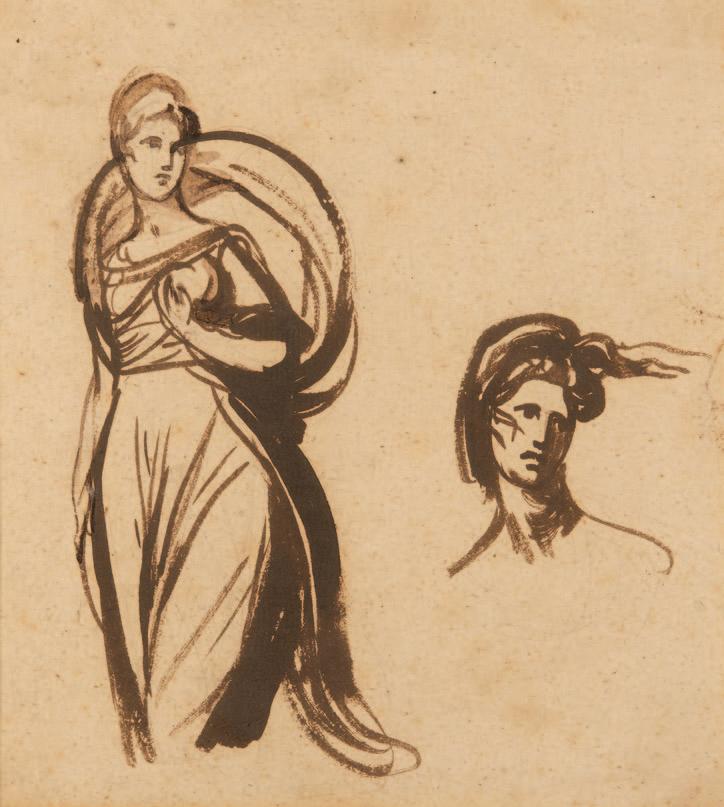

40
Sir Thomas Lawrence, P.R.A. (1769-1830)
Portrait of a Lady
Half-length, wearing a brown dress
Pastel, oval
27.2 by 22.7 cm., 10 ¾ by 9 in.
This early work by Lawrence dates from the mid 1780s when he was working in Bath. From the age of eleven when his father was declared bankrupt he was the main breadwinner of the family. He would produce three or four small pastel portraits a week, usually oval in shape, and sell them for three guineas a time. In 1787 he moved to London and began to work in oil. (See no.84 for a later drawing by Lawrence.)
Portrait of a Sculptor
Full-length leaning on an urn with a mallet in his right hand
Inscribed twice lower right: 490/350 and also: 2/L and inscribed verso: More Giacobbe Pen and black ink and black chalk heightened with white on prepared paper, a double page of a sketchbook
49.8 by 35.1 cm., 19 ½ by 13 ¾ in.
Provenance:
Anonymous sale, Sotheby’s, New York, 26th January 2000, lot 94
The present study of a sculptor at work was probably drawn in the 1770s in Italy and most likely in Rome. The inscription on the back links the work to the Edinburgh born landscape painter Jacob More (1740-1793), who moved permanently to Italy in 1773. More rapidly established himself as one of the leading landscape painters of the group of British artists living and working in Rome during this time. He also acted as dealer and agent, advising the Grand Tourists travelling through Italy on their purchases. More therefore knew all of the artists and sculptors in Rome during the period. The present drawing depicts a sculptor working in his studio, surrounding by examples of his work.
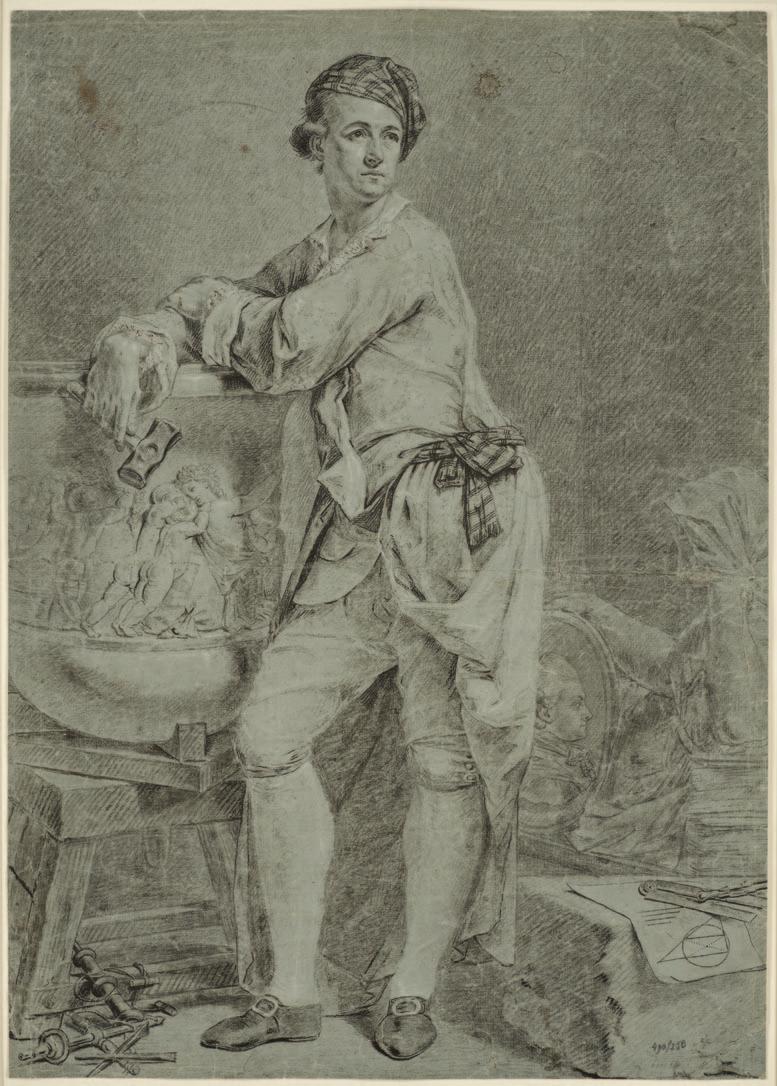

Portrait of Alexander Mitchell of Stow and Carolside
Half-length, in painted frame
Signed on painted frame lower left: J Russell R.A. pinx.t/1790
Pastel
60 by 44.5 cm., 23 ½ by 17 ½ in.
Provenance:
By descent from the sitter to Fanny Georgina Jane Mitchell (d.1917); Her second husband, Donald James Mackay, 11th Lord Reay (1839-1921); Given to his his godson Captain Hubert Charles Poulet Hamilton of Moyne House, near Durrow, Co. Laios, Ireland (1915-2007); By descent until 2017
Born in Guildford, the son of a bookseller, Russell was the preeminent portrait painter in pastel in London from the death of Francis Cotes in 1770 until his own death in 1806. He studied under Cotes in about 1767 and entered the Royal Academy Schools in 1770. He exhibited 329 pictures at the Royal Academy and at the height of his fame he charged 30 guineas for head portrait and £150 for large fulllengths, similar to the President of the Royal Academy, Sir Joshua Reynolds.
Portrait of Amelia and Harriet Harding-Newman of Nelmes, Essex at their Music Lesson

Inscribed on an old label attached to the backboard: Amelia and Harriet HardingNewman … Grandaughter of Richard Harding Pastel on paper Oval 44 by 49 cm., 17 ½ by 19 ½ in.
Provenance:
Dr W.R. Schweizer: Anonymous sale, Sotheby’s, 4th November 1964, lot 44 as H.D. Hamilton; By descent to the present owner
This pastel has recently been re-attributed to Anna Tonelli, an Italian artist who specialised in miniatures and pastel portraits, whose work has often been mistaken for her likely teacher Hugh Douglas Hamilton (1740-1808). For more on Tonelli see the note to no.58.
Amelia (1784-1864) on the left, and Harriett (1782-1837) were the children of Richard Harding (1757-1808) and Harriett Schutz (1759-1791) who married at St. James’s Piccadilly in 1776. Their father was the sitter in George Romney’s Pink Boy (which was sold at Christie’s in 2014) who had inherited the Manor of Romford, Essex in 1766 from his maternal grandfather, Richard Newman. As Harding he acquired Nelmes in 1781 and took the Newman surname in 1783 by Act of Parliament to become Richard Harding Newman. The family lived at Nelmes Manor, Hornchurch, Essex. Neither Amelia nor Harriett ever married.
We are grateful to Neil Jeffares for the attribution of this work to Tonelli.
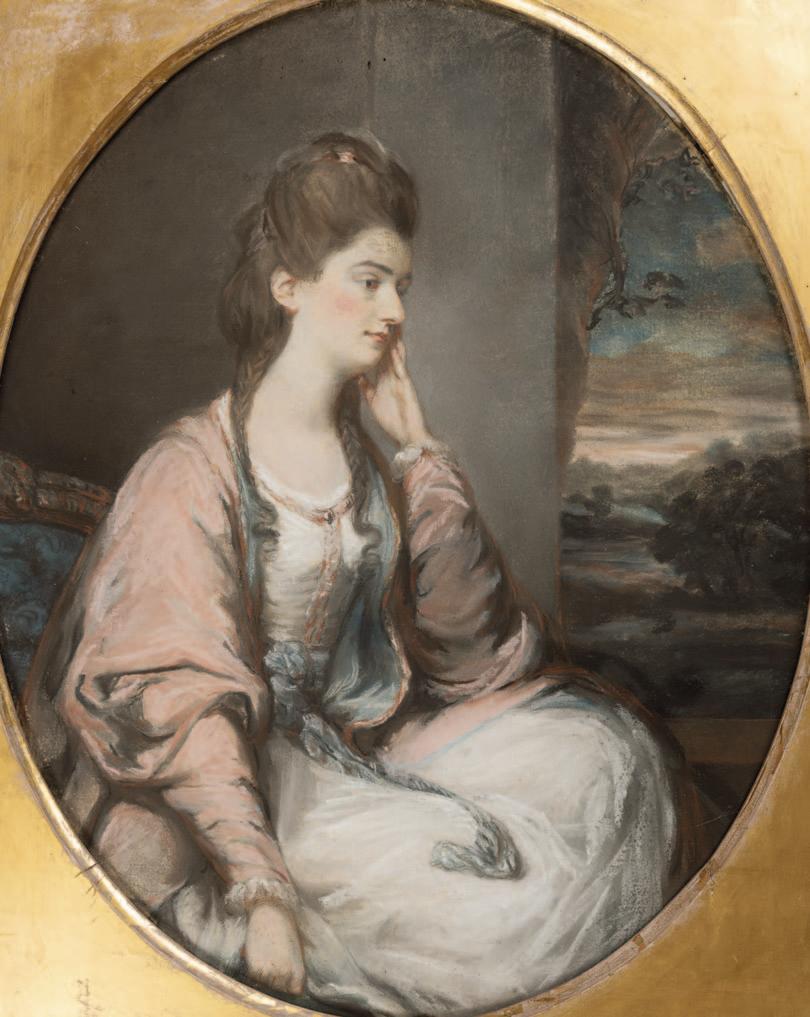
Portrait of a Lady
Three-quarter length seated, a landscape beyond Pastel
Oval 34.2 by 35.5 cm., 13 ½ by 14 in.
Provenance:
Private Collection since circa 1980
Born in Kendal, Cumbria, Gardner took lessons from the young George Romney before moving to London in about 1767. He entered the Royal Academy Schools in 1770 and worked briefly for Sir Joshua Reynolds in 1773. He quickly built up a successful practice in portraits so felt no need to exhibit. He invented his own technique which gives his portraits a rough appearance combining gouache and pastel. Along with John Russell (see no. 42), Gardner dominated the market for pastel portraits in London in the late eighteenth century.
Portrait of a Lady
Half-length facing right
Inscribed on a label attached to the backboard: For M.rs Wallop and on the reverse of the backboard: If not approved/desires it may be returned/to London Gouache
Oval 32.2 by 27 cm., 12 ½ by 10 ½ in.
The label on the backboard suggests that this is likely to be a portrait of Mrs Camilla Wallop, née Powlett Smyth (1755-1820). She was the daughter of the Reverend Richard Smyth and Annabella Powlett. She married the Reverend Dr. Barton Wallop, the son of Viscount Lymington and Master of Magdalene College, Cambridge in 1771.


Portrait of a Lady
Half-length turned to the left, wearing a black dress and white bonnet
Pastel over pencil on laid paper
Oval 25 by 19.8 cm., 9 ¾ by 7 ¾ in.
Provenance:
Anonymous sale, James Adam, Dublin, 29th September 2004, lot 20, one of three
Born in Dublin, Hamilton was one of the most celebrated Irish artists of the eighteenth century and unusually was also one of the few to return to Ireland following his success in London and Italy.
Hamilton entered the Dublin school of Drawing circa 1750 where he spent about eight years, before he established himself as a portraitist specialising in small-scale pastels; a format he favoured throughout his career. In 1764 he moved to London where he found success capturing likenesses of the wealthy, the aristocracy and members of the royal family. In 1779, Hamilton moved with his family to Italy, where he continued as a portrait painter, spending several years based in Rome and Florence, as well as visiting Venice and Naples. He became a key figure in the artistic circles and the numerous portraits that exist from this period attest to his success. Not only did he work in pastel, in the small oval form that he had habitually favoured, but he also began to produce larger-scale rectangular compositions with the figures placed within landscape, or architectural settings, and also in oil.
In 1791, Hamilton returned to England briefly, before returning to Ireland, where apart from brief visits to London, notably in 1802, he remained until his death. He retired from painting in 1804, leaving his daughter to finish his outstanding commissions.
The group of pastels by Hamilton in the present catalogue (cat. nos. 46, 47 and 58) are all his preferred small-scale oval format. The refined, delicate treatment with a careful use of line and colouring, is characteristic of his sophisticated handling of the medium of pastel.
It has previously been suggested that this may be a portrait of Viscountess Doneraile, née Mary Barry. She married St Leger St Leger, 1st Viscount Doneraile (1715-1787) and they had six children. They lived at Doneraile Court, Co. Cork, Ireland 47
Portrait of a Gentleman
Half-length turned to the left, wearing a brown coat and a white stock
Pastel over pencil on laid paper
Oval 23 by 18 cm., 9 by 7 in.
Provenance:
Anonymous sale, James Adam, Dublin, 29th September 2004, lot 20, one of three
It has been suggested that this is a portrait of Viscountess Doneraile’s second son, Col. Hon. Richard St Leger (1756-1840).

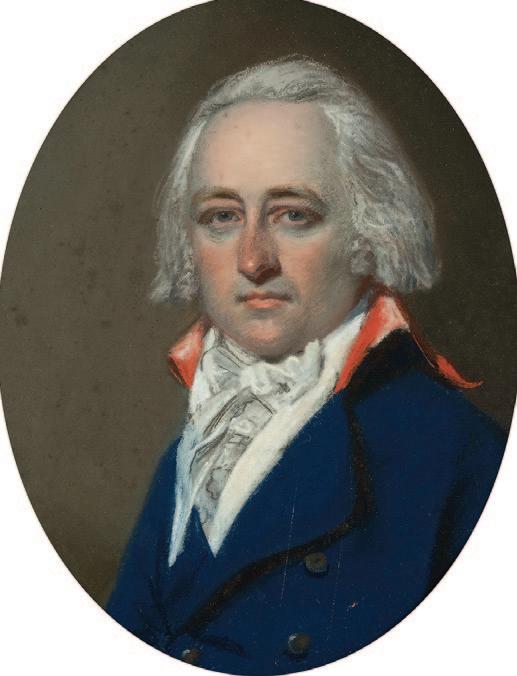

Portrait of Anthony Clarke of Lady Wootton’s Green, Canterbury; Portrait of Mrs Matilda Clarke
A pair, oval, coloured chalks
Each approx. 20.8 by 16.2 cm., 8 by 6 ¼ in.
Provenance:
Mrs George Pidduck, Canterbury, the sale of her effects, 27th November 1882; Dr John A. Packer, Canterbury
Anthony Clarke (1760-1830), a stockbroker, married Matilda Hill Macaree (1760-1835) in Canterbury in 1790. The Clarkes were friends of John Raphael Smith and his family. Matilda Clarke inherited £15,000 and decided to give it to Smith’s daughter Emma to enable her to marry a barrister Robert Smith. Anthony and Matilda Clarke, and John Raphael Smith, were witnesses to the marriage which took place in Marylebone on 10th August 1808.
See note to no.59 for more on the artist.
Portrait of William Simpson of York
Three-quarter length in an interior, with a view of York through the window
Inscribed on a label attached to the backboard: William Simpson Esq/ Corn merchant/Micklegate/York
Pastel
45 by 34.3 cm., 17 ¾ by 13 ½ in.
The label on the backboard suggests that this is a portrait of William Simpson (1786-1819) but he was only twenty-six when John Raphael Smith died so it might depict his father Richard and maybe the picture belonged to William. Richard Simpson (1756-1816) was a successful corn merchant of Pickering, alderman, and Sheriff of York. The family lived at Blansby Park, Pickering, but moved to York in the early 1800s. William took over his father’s business at North Street, at the bottom of Micklegate, and became a corn merchant and miller in his own right after his father’s death in 1816. William died young, age thirty-three and was buried on 4th March 1819 at St Mary’s Church, Bishophill Senior, York. The family business was taken over by his younger brothers and thrived for another sixty years. William was survived by Mary, his Lincolnshire wife of nine years, and five of their six children. The National Archives include a record of a Yorkshire corn dealer called William Simpson circa 1790 who could possibly have been Richard’s brother. See note to no.59 for more on the artist.
We are grateful to Elizabeth Cottell for the information on the sitter.


50 Thomas Rowlandson (1756-1827)
Study for ‘Procession of the Cod Company from St Giles’s to Billingsgate’
Signed lower right: Rowlandson Pen and ink over touches of pencil
20.3 by 17.1 cm., 8 by 6 ¾ in.
Provenance: With Sabin Galleries, London
The left hand figure appears in the print of this title published on 18th September 1810.
Thomas Rowlandson (1756-1827)
Single or Unmarried
Pen and grey ink heightened with watercolour over touches of pencil on laid paper 19 by 12.6 cm., 7 ½ by 5 in.
Provenance:
With Spink & Son, London, 1978 where bought by the present owner
Exhibited:
London, Spink & Son, Thomas Rowlandson 17561827, An exhibition of drawings and watercolours in conjunction with Morton Morris & Company, 7-23 March 1983, no 23.
Literature:
Spink & Son, Thomas Rowlandson 1756-1827, An exhibition of drawings and watercolours in conjunction with Morton Morris & Company, 7-23 March 1983, no 23, ill.
This relates to a print entitled ‘Single’ or ‘Unmarried’ and published as a pair with ‘Married’ in 1786 and again in 1791. ‘Married’ shows a woman with a baby on her lap.

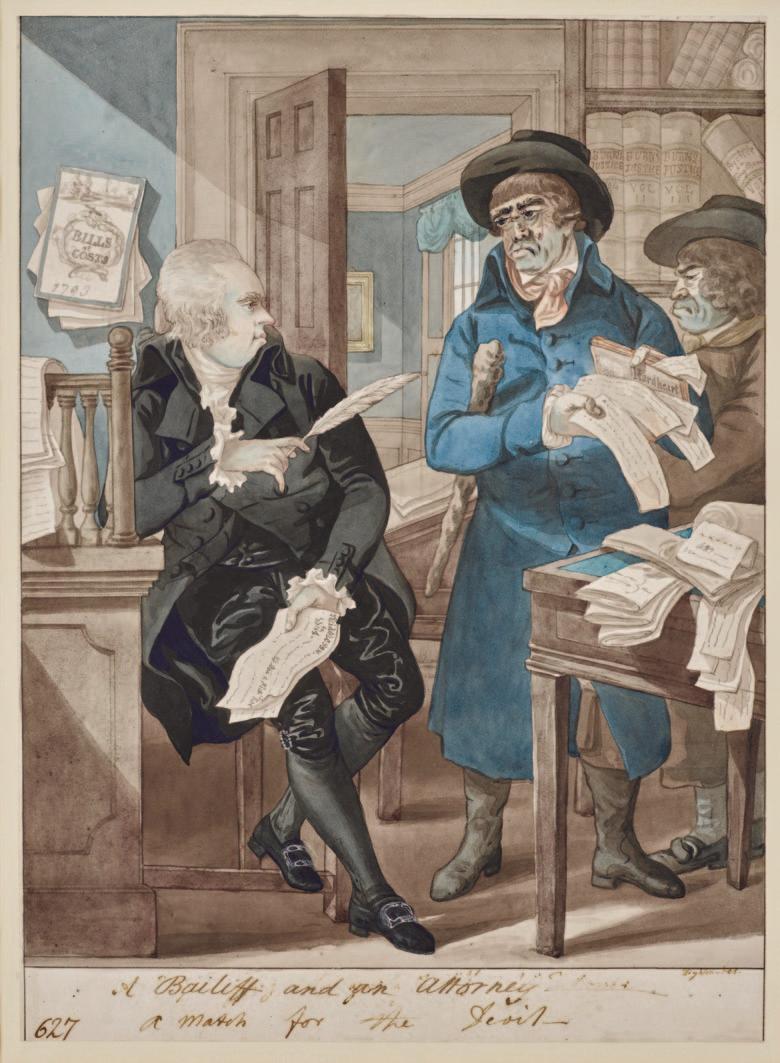
A Bailiff and an Attorneya Match for the Devil
Signed and inscribed along the bottom of the sheet: Dighton del./A Bailiff and an attorney/a match for the Devil-/627 Pen and ink and watercolour 35.2 by 25.6 cm., 13 ¾ by 10 in.
Provenance:
Henry Carington Bowles (1763-1830); By descent in the Carington Bowles family until sold, Sotheby’s, 30th April 1952, bt. Sabin; Jeffrey Rose, his Executor’s sale, Sotheby’s, 23rd February 1978, lot 67; Anonymous sale, Christie’s 7th April 1992, lot 127; Private Collection until 2024
Literature:
Dennis Rose, Life, Times and Recorded Works by Robert Dighton (1752-1814) – Actor, Artist and Printseller, 1981, p.76, ill.
Engraved: By Bowles and Carver, circa 1792
The son of a London printseller, Dighton was a man of many talents – caricaturist, actor, writer and singer. He is best known for his satirical portraits which he exhibited at the Free Society and the Royal Academy. His sons Richard and Joshua also became caricaturists.
Henry Carington Bowles, a publisher and bookseller, owned a large collection of original works by Dighton which were sold by his descendants at Sotheby’s in 1952.
The Mandarin of Tourane with his pipe-bearer
Signed with initials and dated '95 and with inscription verso: Mandarin of Toron [sic] with Pipe bearer 22.2 by 17.5 cm., 8 ¾ by 6 ¾ in.
Provenance:
Roger Makins, 1st Baron Sherfield (1904-1996); Private collection, USA
Literature:
Sir G. L. Staunton, An authentic Account of an Embassy from the King of Great Britain to the Emperor of China, London 1796, pl. 16
Engraved:
By James Caldwall, 12 April 1796, for Sir G.L. Staunton, An Authentic Account… 1976, pl. 16
William Alexander was one of the first European artists to visit China. It was probably through his teacher Julius Caesar Ibbetson that Alexander was recommended for the post of junior draughtsman in Lord Macartney’s embassy to China in 1792-4, Ibbetson having turned the role down for himself. This extended visit was a lasting source of inspiration for Alexander and provided the bulk of images of China and its people that were available to the British public. Indeed for over fifty years, his images of China were widely borrowed by book illustrators and by interior decorators in search of exotic themes.
Between 26th May and 16th June 1793, Macartney’s Embassy anchored off Tourane (Da Nang, southern Vietnam). On 3rd June, a number of important dignitaries visited the ship and Alexander recorded in his Journal: ‘This morning a Mandarine from court… came on board to see our ship…with another of inferior rank who sat a few minutes while I made a slight sketch of him… I persevered in keeping the sketch, so he went out in a huff' (S. Legouix, Image of China; William Alexander, London, 1980, p.9).

Alexander executed individual sketches of the ‘Inferior Mandarin’ and his ‘Pipe-bearer’ of ‘Cochin China’ both dated 1793, see Sotheby’s 1st April 1976, lots 5 & 6, with the latter now in Maidstone Art Gallery. Alexander combined the two portraits into the present drawing, which was the model for plate 16 in Staunton's Account. John Barrow observed that the pipe-bearers not only carried their masters’ pipes, tobacco and betel but invariably acted as homosexual companions to their mandarins (John Barrow, Travels in China… London, 1804, pp. 149-50).
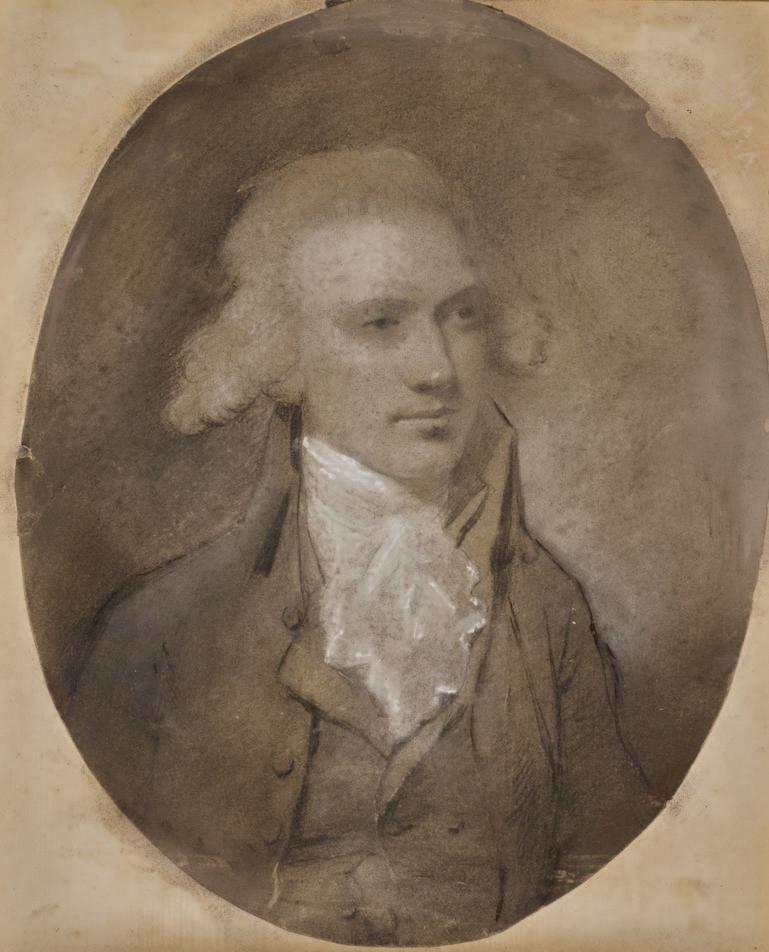
Half length, wearing a dark jacket and waistcoat and a white stock
Inscribed on old label attached to the backboard: For/Anne Bramwell Coloured chalks on laid paper
Oval 27.7 by 21.7 cm., 10 ¾ by 8 ½ in.
The present portrait by an as yet unidentified artist is characteristic of the sorts of smallscale atmospheric chalk portraits that were being produced in Ireland during the last decades of the eighteenth century. Artists such as Hugh Douglas Hamilton (1740-1808), Thomas Hickey (1741-1824), Robert Healy (1743-1771) and his brother William (fl. 175778), Charles Forrest (fl.1765-1780), George Lawrence (1758-1807) and Alexander Pope (1763-1835) all worked in pastel and in chalk, producing such works.
Part of the reason for the popularity of the medium was the early training that the artists received in the Dublin Society Drawing School under the tutelage of Robert West (c.17101770), who had studied in France probably under Carl van Loo (1805-1765) and François Boucher (1703-1770).
Portrait of Honora Edgeworth, née Sneyd (1751-1780)
Half-length, looking left
Inscribed on part of old backing: Honora Sneyd/married to R.L. Edgeworth/ this portrait belongs to/C.S. Edgeworth/Langham House Ham Com.. Pastel over pencil
Oval 23.3 by 18.2 cm., 9 by 7 in.
Provenance:
By descent to Charles Edgeworth (1786-1864), Langham House, Ham; Anonymous sale, Sotheby’s, 9th November 1978, lot 144 as by Hugh Douglas Hamilton
This fine pastel has recently been re-attributed to Anna Tonelli, an Italian artist who specialised in miniatures and pastel portraits, whose work has often been mistaken for her likely teacher Hugh Douglas Hamilton (1740-1808). Her early training seems to have been under the tutelage of Guiseppe Piattoli (1748-1834) in Florence before, later becoming a pupil of Hamilton (see nos. 46, 47 and 58). By 1794, Tonelli had moved to London where she was employed to teach drawing to the children of Lord and Lady Clive, who she had met in Italy. Between 1798 and 1801 she accompanied the Clives to India, where she worked in watercolour or miniature, rather than pastel. She returned to Italy at the end of 1801, where she remained for the rest of her life.
The present portrait may be a copy after a portrait by Hugh Douglas Hamilton. It is characteristic of the precise style that Tonelli adopted when copying the work of her former tutor. There are two further portraits of two of the sitter’s sisters, Charlotte and Mary, in the National Gallery of Art Washington. There are also recorded portraits of the sitter’s uncle, Lewis Bagot (1740-1802), Bishop of Bristol, and his wife, who sat for Tonelli in 1797. A painting of her husband Richard Lovell Edgeworth by Hamilton is in the National Gallery of Ireland (NGI 1350).
The writer Honora Sneyd (1751-1780) was born in Bath, but following the death of her mother, she moved to Lichfield, aged 5, to be brought up by Canon Thomas Seward (1708-1790) and his family. His progressive beliefs on female education encouraged both Sneyd, and his own daughter, the poet Anna Seward (1742-1809), in their literary careers. In 1773, she married the writer, politician and inventor, Richard Lovell Edgeworth (1744-1817) and the couple moved initially to Ireland, to oversee the family’s estate Edgeworthstown, County Longford before returning to England in 1776. In 1779, Honora was diagnosed with tuberculosis and they remained in England until her death the following May. Richard Edgeworth returned to Ireland in 1782 and the following decade, sat for Hamilton for a portrait in oils in 1795 (National Gallery of Ireland 1350).
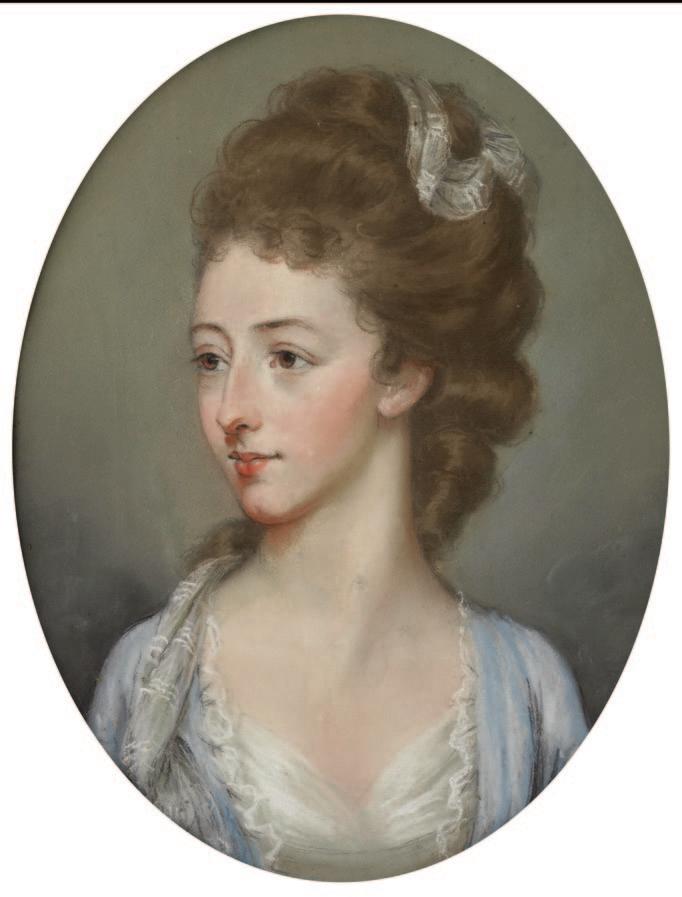
We are grateful to Neil Jeffares for the attribution of this work to Tonelli.
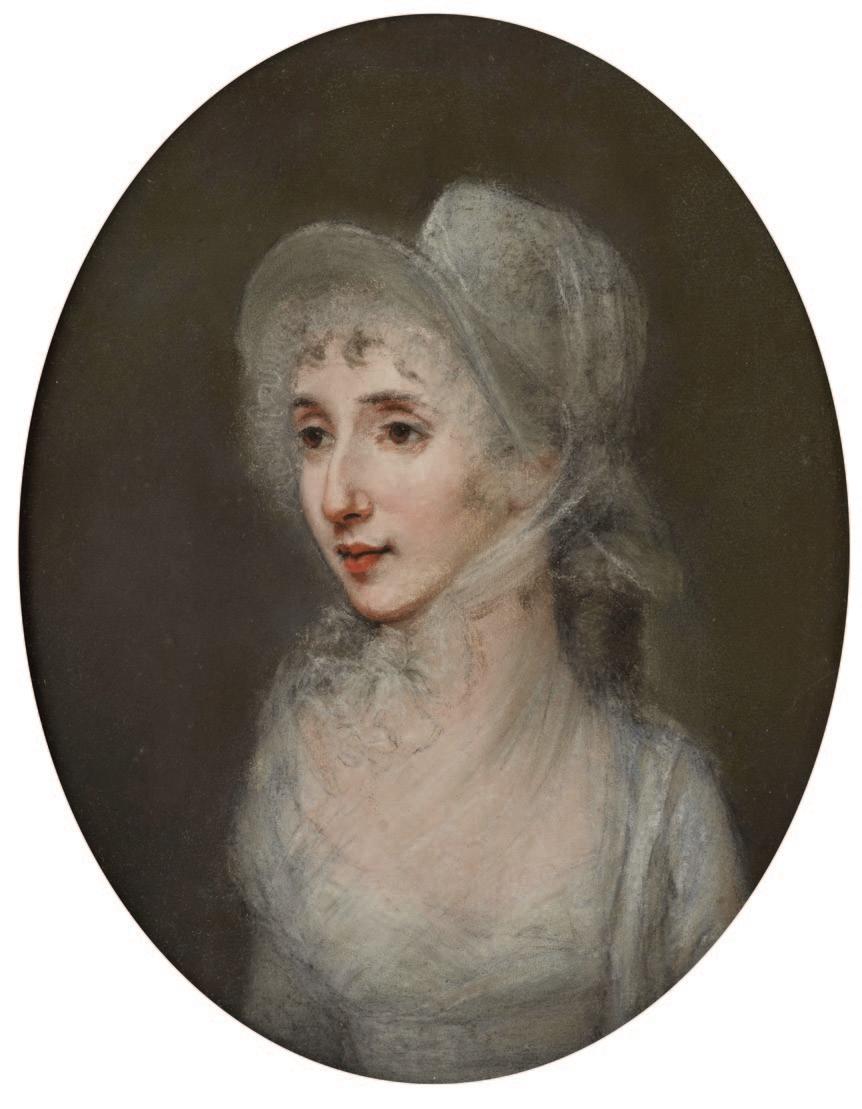
English School, late eighteenth Century Portrait of a Lady
Half-length, wearing a white dress and bonnet
Pastel over pencil
Oval 23 by 18.1 cm., 9 by 7 in.

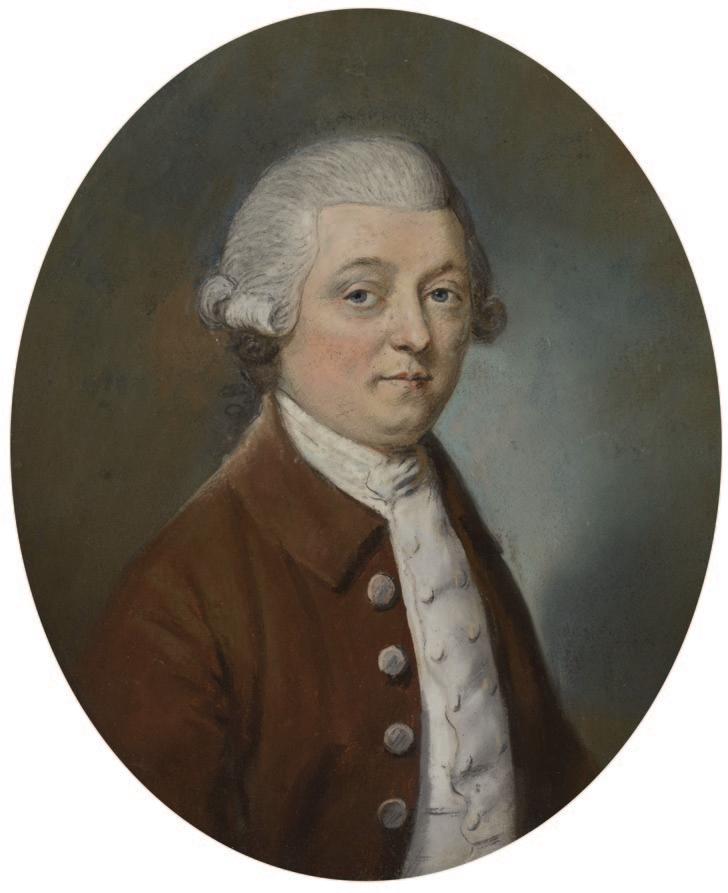
Portrait of a Gentleman, traditionally thought to be Rev. Fulwar Craven Fowle
Inscribed on backboard: For Mr C Fowle/Revd F C Fowle
Half-length, wearing a brown coat and white waistcoat Pastel over pencil
Oval 21.5 by 17.6 cm., 8 ½ by 7 in.
The present portrait is traditionally thought to be of the Rev. Fulwar Craven Fowle (1764-1840) who was born in Kintbury, Berkshire, the son of Rev. Thomas Fowle (1726-1806), vicar of Kintbury, and Jane Craven (1727-1798). However, the costume of the sitter dates to the end of the 1770s, which would make Fulwar about sixteen at the time, and the sitter appears to be older. The inscriptions on the backboard links the portrait to the Fowle family and to both the Rev. Fulwar and his younger brother Charles (17701806).
Fulwar matriculated at St John’s College, Oxford in June 1781. In 1788, he married Eliza Lloyd and took over the living at Kintbury from his father in 1798. He was fascinated by developments in agriculture and he kept a flock of prizewinning Leicestershire sheep. He also helped form a brigade of local volunteer rifles, part of the mass of local regiments formed at the time to defend England in the event of a French invasion. Fulwar led his regiment on parade in front of George III in 1805 and the King is recorded as saying that whilst he knew Fowle to be a good clergyman and a good man and now he knew he was also a good officer.
His brother Charles Fowle joined Lincoln’s Inn in 1790, was called to the bar in 1800 and subsequently practiced as a lawyer in the nearby market town of Newbury. He married Honoria Townsend in 1799. He fell ill in 1805 and moved to Bath for his health but returned to his brother’s house in February 1806, where he died just a few days after his father.
Thomas Fowle was close friends with Rev. George Austen, father of the writer Jane, from their student days at Oxford and he sent all four of his sons to George Austen to be educated. The friendship of the fathers continued into the next generation and the Austen and Fowle children became close and the families often visited each other. Jane Austen’s sister Cassandra became engaged to Fulwar’s brother Thomas (1765-1797), although he died in the West Indies before they could marry. Jane’s brother, Rev. James Austen (1765-1819) was close to Fulwar and was on occasion called to officiate in Kintbury church including to christen Fulwar’s fourth child Caroline. Furthermore, James married Fulwar’s sister-in-law, Mary in 1797. Jane and Cassandra became close to both Eliza and her sister Martha Lloyd and Charles Fowle and Jane appear to have enjoyed a teasing friendship, judging from Jane’s correspondence. In 1828, following the death of his first wife, Francis Austen (1774-1865), later Admiral of the Fleet, married Martha Lloyd.
Portrait of a Gentleman
Half-length wearing a brown coat and yellow waistcoat
Coloured chalks on laid paper Oval 22.8 by 19 cm., 9 by 7 ½ in.
The present work is typical of the small-scale lively portraits that Smith produced either in chalk, as here, or in pastel. The rapidity and spontaneity of handling introduces an informality and feeling of intimacy to his portraits.
Smith had initially established himself as probably the leading printmakers of the late eighteenth century in Britain. At the height of his career, he employed some thirty engravers and had reproduced the work of most of the leading painters of the period, including pastels by Jean-Etienne Liotard, Hugh Douglas Hamilton (see nos. 46, 47 and 58), Daniel Gardner (see nos. 44-45) and John Russell (see no. 42).
In 1802, he retired from printmaking and sold off his entire stock, leaving the way clear for Rudolf Ackermann (17641843) to take over his position. Smith from this date onwards worked in oil, chalk and pastel, travelling widely throughout Britain to undertake portrait commissions. See nos. 48 and 49 for other works by the artist.
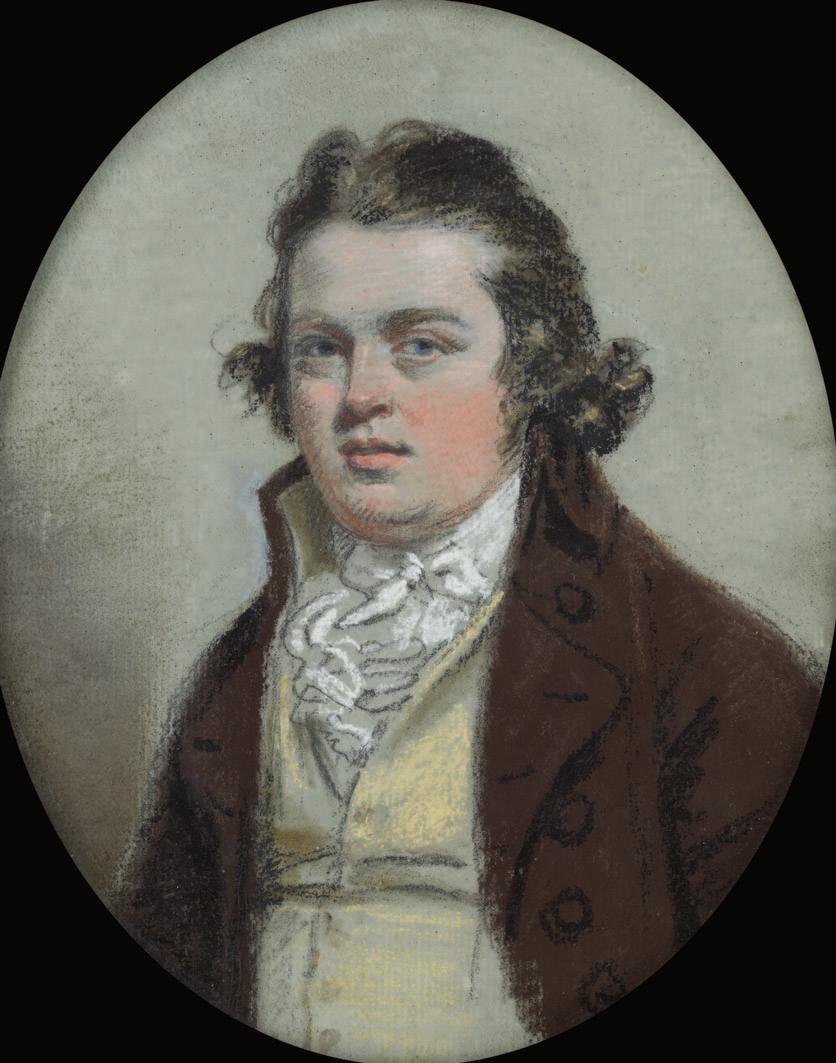

Half-length, facing left wearing a brown coat and grey and white waistcoat
Oval, pastel
30.4 by 25.4 cm., 12 by 10 in.
The present portrait of a young gentleman can be dated to the 1780s or early 1790s. Although waistcoats had always been important part of male attire, during the last two decades of the century, they became even more of a focal point and fashionable gentlemen favoured pattered or striped waistcoats with plain coats and breeches. His knotted plain, rather than lace, cravat also became increasingly popular and furthermore he is wearing his own hair, powdered, rather than a wig. In May 1795, William Pitt introduced a tax on hair powder and within 5 years, the use of hair powder had virtually stopped, apart from specific roles and at court.
For a further discussion on artists of the Irish school see no. 54.
Portrait of a Gentleman in a red Jacket
Half-length wearing a red jacket and yellow waistcoat
Pastel
Oval 30.4 by 25.4 cm., 12 by 10 in.
Pastel became an immensely popular medium for portrait drawing during the 18th century, particularly in Britain and France, but also in Italy and Switzerland. The medium is highly malleable, allowing artists to work rapidly and to easily correct errors. It can be manipulated, smudged and blended and can produce both fine, delicate lines and areas of colour at the same time which allowed the artist to capture a wide range of textures, fabrics, lace and other materials beautifully. Not only was pastel embraced by professional portrait artists, who were able to create accurate and detailed portraits quickly, in just a couple of sittings and thus increase output and revenue. But it also became popular amongst the wealthy amateur artists who embraced its versatility and portability.

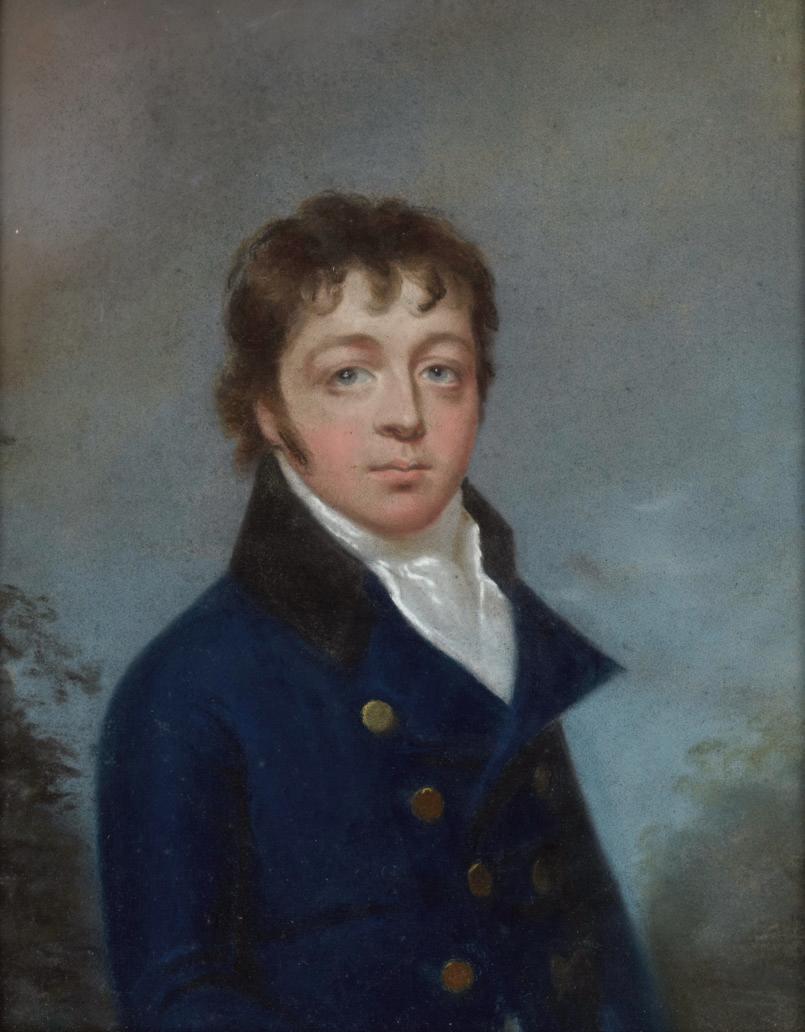
Portrait of Mr William Hunter of Kilburn Hall, Derbyshire
Half-length, wearing a blue coat
Inscribed on part of old backing attached to the backboard: W. Hunter/Kilborne and:
Given to Caroline Brown Macham Pastel
25.3 by 20.2 cm., 10 by 8 in.
The present portrait depicts a member of the Hunter family, of Kilburn Hall, Derbyshire. It has not as yet been possible to identify which William Hunter, as there appear to be several, but none, so far, appear to be the right age for our sitter, circa 1800. There is a William Hunter Hunter (1768-1833) who inherited the estate from his uncle (changing his name from Fletcher in 1795), but the figure depicted here looks younger than William Hunter Hunter who would have been thirty-two at this date.
It appears likely that the present portrait was painted by one of the Sharples family of artists. Ellen Sharples (1769-1849) was married to the artist James Sharples (see cat. no.63). Their two children, James (1788-1839) and Rolinda (1793-1838), as well as James’s son by his second marriage, Felix Sharples (1786–c.1830) all became artists. When the family moved to America in 1794, James’s success depicting notable public figures such as George Washington, Thomas Jefferson and Alexander Hamilton, meant that there was large demand for copies, and Ellen worked with her husband to provide these. On James’s death, Ellen, James Junior and Rolinda all returned to Bristol.
Half-length wearing a blue coat
Signed and inscribed on backboard: JSharples/Lansdown place/Bath Pastel
Oval 21 by 17.8 cm., 8 ¼ by 7 in.
Born in Lancashire, Sharples exhibited initially at the Liverpool Society of Artists in 1774 before sending work to the Royal Academy in London from 1779 to 1785, where he is variously listed as living in Cambridge, London and Bath.
Sharples lived in Bath periodically from 1782 until he left England permanently for America in 1808. He lived there first from 1782 until the death of his second wife in about 1786. He then returned to Bath towards the end of the century, with his third wife, Ellen Wallas (1769-1849), whom he had married in 1787. Ellen became a talented small-scale portrait painter in her own right, but spent much of her time copying her husband’s work. Following his death, she founded the Bristol Academy for the Promotion of Fine Arts (subsequently the Royal West of England Academy).
This inscription on the backboard indicates that this portrait must date from between December 1790 and late 1792 when Sharples was based in Lansdown Place, Bath. He advertised in late 1790 in the Bath Chronicle that his work could be viewed either at his home in Lansdown Place or his apartment at Mr Vasey’s adjoining the Pump Room. Two years later, in December 1792, he advertised his removal from Lansdowne Place to 16 Queen’s Square.
In mid 1794, the family went to the United States for the first time, where they remained until 1801, based mainly in New York but spending long periods in Philadelphia, the seat of the US Government. There were few pastellists in America at this time and Sharples found a ready market for his work. He established his reputation by portraying local and national figures including George Washington, Thomas Jefferson and John Adams amongst others. The success of this extended stay encouraged the family to decide to settle in America.


64
English School circa 1800
Portrait of a Girl holding a Rabbit
Three-quarter length in a wooded landscape
Pastel
28 by 21.8 cm., 11 by 8 ½ in.
Portrait of Marianne Sherman holding a Doll
Full-length, seated in a landscape
Inscribed on an old label attached to the backboard: Marianne Sherman/wife of J.B. Lawes/died 1875 aged 8... Pastel
24.5 by 19.4 cm., 9 ½ by 7 ½ in.
The Sherman family lived at Drayton, Oxfordshire. Marianne (1791-1875), pictured here by an unknown hand at the age of about 4 or 5, married first the Rev. D.G. Knox in 1810, who died just a few months after their wedding. She then married John Bennet Lawes in 1812, who died in 1822, leaving Marianne to bring up their three children, Marianne (b. 1813), John (b.1814), later Sir John Lawes of Rothamsted and Emily (b. 1820).

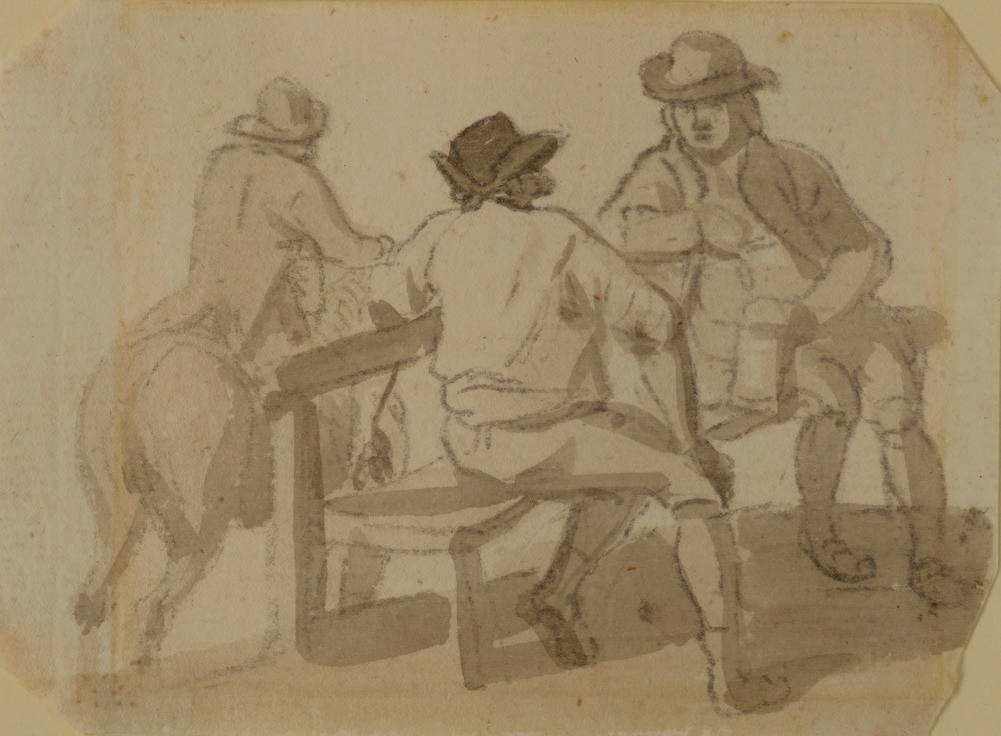
Paul Sandby, R.A. (1730-1809)
Study of Three Figures by a Bench
Grey washes over pencil on laid paper, with cut corners
6.9 by 9.4 cm., 2 ¾ by 3 ¾ in.
This is typical of Sandby’s on-the-spot figure studies.
A Farmer drinking from a Tankard
Signed with initials lower left Black and white chalk on buff paper 26 by 14.6 cm., 10 ¼ by 5 ¾ in.
Provenance:
Anonymous sale, Christie's, 1st April 1881, lot 50; With Thos. Agnew & Sons, 1998
Exhibited:
London, Thos Agnew & Sons, English Watercolours
Drawings and Small Oil Paintings, 25th February to 20th March 1998, no.29
This is a study for the figure to the right-hand side in Ward’s painting ‘The Farrier's Shop’ exhibited at the Royal Academy in 1796, no.477.


A Couple under a Tree, possibly the Artist and his Wife
Pencil
22.8 by 14 cm., 9 by 5 ½ in.
The present drawing may depict the artist Richard Cosway and his wife Maria, in seventeenth century costume, seated in their garden at Schomberg House, Pall Mall. Cosway was influenced by the work of Sir Peter Rubens, whose work he also collected, and the present drawing is one of a small group depicting a couple in costume, inspired by Rubens’s work. There is a further, well-known print of the couple, with their servant, the celebrated anti-slavery campaigner, Quobna Ottobah Cugoano, also known as John Stuart. (c.1757-c.1791), by Thomas Rowlandson, after a drawing by Cosway dated 1784.
In January 1781 Cosway married the artist and musician Maria Hadfield and during the following decade, the couple were at the centre of fashionable society in London. They operated a popular salon, hosted musical evenings, from their home in the heart of St James’s and numbered the Gainsboroughs amongst their neighbours. They published original music compositions and drew the most eminent figures of the day, many of whom numbered amongst their patrons, including George, Prince of Wales (later George IV) for whom Richard Cosway worked for thirty years.
Maria was the eldest child of Charles Hadfield and Isabella Pocock, who owned a hotel in Florence. She was talented both in music and drawing and aged 13, she came to the notice of Johann Zoffany (1733-1810), who encouraged her artistic ability and introduced her to many of the leading artists of the day. In 1778 she was elected to the Florentine Accademia del Disegno. In 1779 when Maria moved to London, she arrived with letters of recommendation and introduced to the leading figures in the London art world, including Sir Joshua Reynolds and Angelica Kauffman. Despite this, Maria found it difficult to forge an independent career, which may have, in part at least, led her to accepting Cosway's offer of marriage. The marriage however, appears to have caused Maria further problems professionally, with her husband’s refusal to allow her to sell her work. Consequently, Maria began to spend long periods in Italy and France, where she concentrated on encouraging girls’ education, establishing a school at Lyons in 1803 and then at Lodi in Lombardy in 1812. She returned to London in 1817 to nurse her ailing husband, until his death in 1821, when she then returned to Europe, settling in Lodi until her death in 1837.
Study of a Vestal Virgin
Numbered 54 lower left
Pen and brown ink and pencil on laid paper
16.2 by 10.9 cm., 6 ¼ by 4 ¼ in.
This drawing dates from the 1790s.


70
Pen and grey ink over pencil 27.7 by 28.7 cm., 10 ¾ by 11 ¼ in.
Provenance: Gerald Robinson; L.G. Duke; Iolo A. Williams (1890-1962), Kew Gardens, Surrey; By descent until sold at Sotheby's, 31st March 1999, lot 6
The drawing relates to William Blake's poem ‘The Voice of the Ancient Bard’ published in Songs of Innocence in 1789.
‘Our Father which art in Heaven’
Inscribed upper centre:
Our Father which art in Heaven Pen and grey ink and grey wash over pencil on laid paper 19.9 by 14.7 cm., 7 ¾ by 5 ¾ in.
Provenance:
With P. and D. Colnaghi, 14 Old Bond Street, London; Private Collection
Eight lithographs of illustrations to the Lord’s Prayer by Flaxman were published after his death by Richard Lane in 1835. The original drawing by Flaxman for one of these, entitled ‘But Deliver us from Evil’, was recorded with Chris Powney in 1979 (see David Bindman (ed.), John Flaxman R.A., exhibition catalogue, 1979, no.146, p.123, ill.). A second titled ‘Lead us not into Temptation’ was in an exhibition at the Heim Gallery in 1976 (see Heim Gallery, John Flaxman, exhibition catalogue, 1976, no.25).

Born in North Wales, Downman trained in London under Sir Benjamin West before leaving for Italy with Joseph Wright of Derby in late 1773. He was back in London in 1775 and established himself as one of the most fashionable portrait painters of the period in the 1780s. He invented a method of drawing on very thin paper with watercolour on the reverse to give the colouring a subtle effect. He exhibited frequently at the Royal Academy but complained about the positioning of his pictures in the less prestigious rooms.
John Downman, A.R.A.
(1750-1824)
Portrait of John Congreve
Signed centre left: J Downman/p.t/1787
Coloured chalks and watercolour
Oval 20.4 by 16.3 cm., 8 by 6 ¼ in.
Provenance: Ruskin Gallery, Stratford-upon-Avon
The Rev. John Congreve (1654-1710), originally from Staffordshire, bought an estate near Kilmeaden, in Waterford, Ireland. His grandson and heir John Congreve commissioned John Roberts to build Mount Congreve House in 1760.
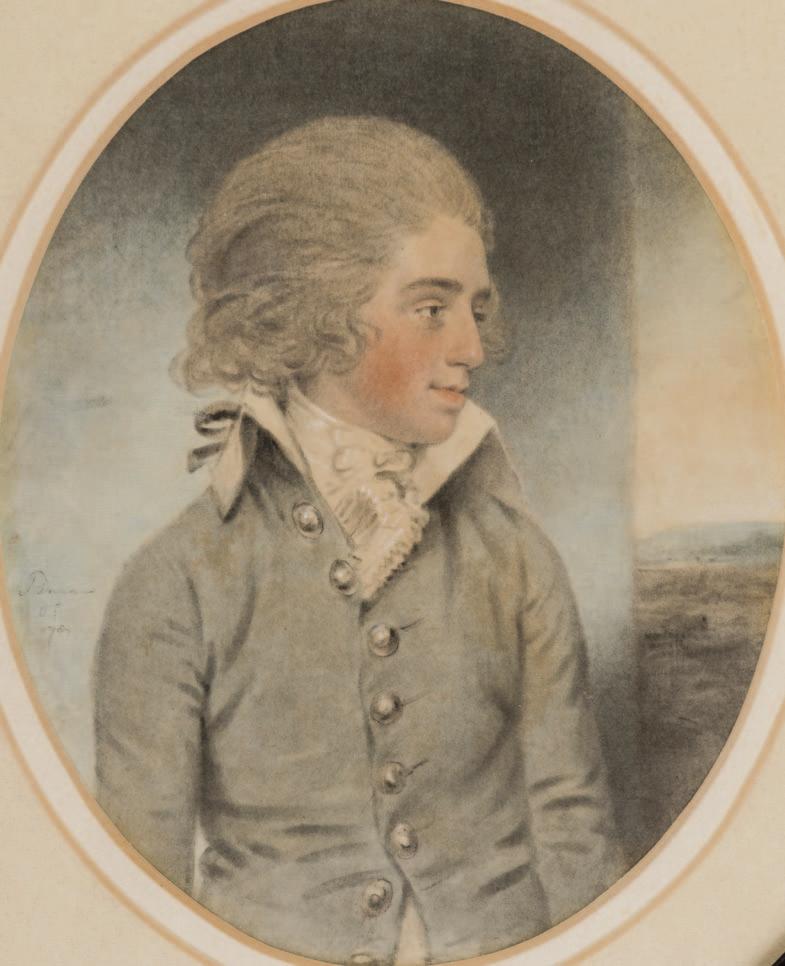
Portrait of Mrs Townley and her Son
Signed on original mount lower left: JoD 1812 and inscribed lower right: M.rs Townley and Son London
Coloured chalks, watercolour and pencil heightened with touches of white
30.3 by 23.8 cm., 12 by 9 ¼ in.
Provenance:
With M. Knoedler & Co, New York; Mrs William M. Grieve, his Executor’s sale, Christie’s London, 8th June 1976, lot 86:
Mr and Mrs W.A. Rappolt, their Executor’s sale, Sotheby’s, 26th November 1998, lot 7
Exhibited: London, Philip Mould and Co., Downman in Vogue, 18th September to 9th October 2020
A sketch for this portrait is recorded in the collection of Mrs Maitland (see G.C. Williamson, John Downman, his life and works, 1907, p.44).


with initials on reverse of backing
by 16.7 cm., 5 by 6 ½ in.
Portrait of Mrs FitzGerald
Signed with initials and dated lower left of original backboard: J D 1807 and inscribed lower right on original backboard: Mrs Fitzgerald from Ireland/Fancy dress
Pencil, brush and ink and watercolour and stump 27 by 21 cm., 10 ¾ by 8 ¼ in.
Provenance:
Anonymous sale, Christie’s South Kensington, London, 11 December 2007, lot 555; With Abbott and Holder, London, where bought by the father of the present owner
The inscription ‘Mrs Fitzgerald from Ireland’ suggests that this may be a portrait of Mary Frances Fitzgerald (1779-1855) who married her cousin the MP John Fitzgerald (1775-1852) in 1801. She was the daughter and heiress of John Fitzgerald of Little Island, Waterford and was renowned for her beauty. After her marriage she lived at Bredfield near Woodbridge, Suffolk. He became MP for Seaford in Sussex while his wife spent her time socialising in London and Brighton and they eventually separated. She was painted by Sir Thomas Lawrence in 1825 and also by Thomas Phillips. Their son was the poet Edward Fitzgerald (1809-1883) best known for his translation of the Rubaiyat of Omar Khayyam.


Portrait of Miss Fanny Andrews
Inscribed on an old label attached to the backboard: Miss Fanny Andrews 1794 a Study for the Picture/ of Fanny in Dr Downman’s poem of The Land/ of the Muses as added to Spencer’s Fairy Queen/ She was niece to Mr Downman and Cousin to Lord Courtenay Pencil and watercolour 21 by 17.8 cm., 8 ¾ by 7 ¼ in.
Provenance:
Captain Norman Colville (1893-1974); Anonymous sale, Christie’s, 4th June 1974, lot 129, bt. Hazlitt Gooden & Fox for 700 gns; Peter Chance (1911-1985); Private Collection, UK
This is an illustration to a poem by John Downman’s cousin Dr Hugh Downman (17401809). Miss Fanny Andrews is a character in his poem ‘The Land of the Muses’. Born in Exeter, Hugh went to Balliol College, Oxford before going up to Edinburgh to study medicine. He worked briefly in London before returning to his native city and established his practice. He was highly regarded for his amiable personality, moral standing and for being an able and kind doctor.
Whilst at Edinburgh, Hugh had lodged with the poet and orator, Thomas Blacklock and Hugh published ‘Land of the Muses’ a poem in the manner of Spencer in 1768, whilst still at university. His most successful poem, ‘Infancy of the management of children: a poem in three books’, published between 1774-6, ran to nine editions during his lifetime. He also published a number of plays and helped to translate an edition of Voltaire’s work. In 1796 he founded a literary society in Exeter, ‘The Society of Gentlemen’, whose other members included the Cornish clergyman, poet and historian Richard Polwhele and Isaac d’Israeli, father of Benjamin Disraeli. He must have remained close to his artist cousin, as he remembered him in his will.
after Sir Thomas Lawrence, P.R.A.
Study of the Portrait of General Blücher at Windsor Castle
Signed and inscribed lower left: after Sir T Lawrence/JW RA and further inscribed with artist’s shorthand Pencil
22.7 by 13.7 cm., 8 ¾ by 5 ¼ in.
Provenance:
Iolo A. Williams (1890-1962), Kew Gardens, Surrey
The present study of Lawrence’s full-length portrait of the Prussian, Field-Marshall Gebhert Leberecht von Blücher, Fürst von Wahlstatt (1742-1819), was probably drawn when the portrait was exhibited at the Royal Academy’s Annual Exhibition in 1815. The exhibition contained several paintings intended to celebrate the end of the Napoleonic wars. However, Napoleon’s escape from Elba in March 1815 and the resumption of hostilities proved the celebrations a little premature, with Napoleon’s final defeat happening just days before the exhibition closed.
Napoleon’s abdication and imprisonment on the Island of Elba in spring 1814, had been taken as a signal that the long period of war was over. Thanksgiving services were held at St Paul’s Cathedral in London, Wellington was created Duke and the rulers, ministers, army leaders of the allied countries, and their entourages, visited London for the Congress of London, or Allied Sovereign’s Visit, in June 1814. Various celebrations took place to mark the occasion.
Ward, like many of his contemporaries, was fascinated by events in London at this time and captured several of the allied figures including studies of costumes and portrait drawings of Gregory Yelloserf (Yale Center for British Art, New Haven and Private collection) and Tarmorfait Carborlof (Fitzwilliam Museum, Cambridge and Ashmolean Museum, Oxford). In 1815, Ward exhibited Portraits of Prince Platoff’s favourite charger and of Four of his Cossacks (collection of the Duke of Northumberland, Alnwick Castle) at the Royal Academy.
Blücher led the Silesian army into Paris in 1814 and was thus instrumental in forcing Napoleon’s first abdication. After Lawrence’s portrait was painted, he became Commander-in-Chief of the army of the Lower Rhine and was crucial in helping win the Battle of Waterloo. He sat for Lawrence in 1814, when he was attending the Congress of London. The portrait seems to have always been intended for what became the ‘Waterloo Chamber’ at Windsor Castle. The chamber was commissioned by George IV as part of Wyatville's reworking of Windsor Castle and is lined with portraits of the key allied rulers and leaders, military and civilian that defeated Napoleon.

Edridge was born in Paddington, London, and studied at the Royal Academy where he began to exhibit portrait miniatures from 1786 (he exhibited 260 pictures there during his lifetime). In 1790s he started drawing fulllength portraits in pencil and subtle washes. His subjects were seated or standing in a landscape in the manner that Cosway had popularised in the 1780s. He achieved considerable success with these portraits in the late eighteenth and early nineteenth centuries.
Portrait of a Gentleman
Full-length standing in a landscape in riding dress Signed and dated lower left: Edridge1801. Grey washes over pencil
31.4 by 22.3 cm., 12 ¼ by 9 in.
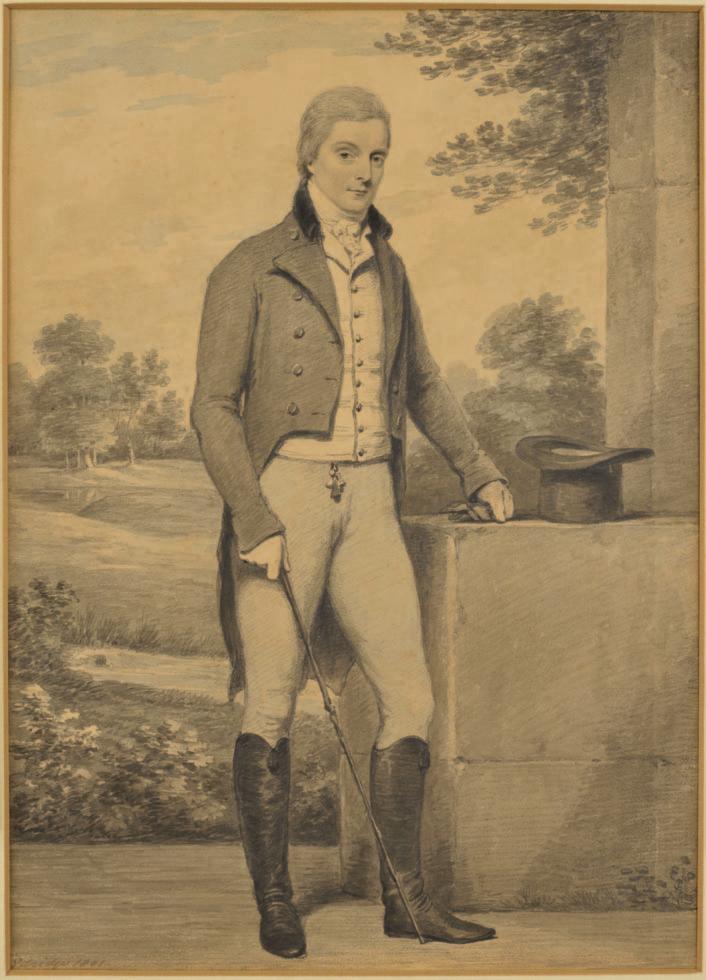
79
Henry Edridge, A.R.A. (1769-1821)
Portrait of a Fellow of Magdalen College, Oxford
Signed and dated 1800 lower left Grey wash and pencil
32.5 by 23.5 cm., 12 ¼ by 9 ¼ in.
Provenance: Anonymous sale, Christie’s, 29th June 2005, lot 3; Private Collection, London

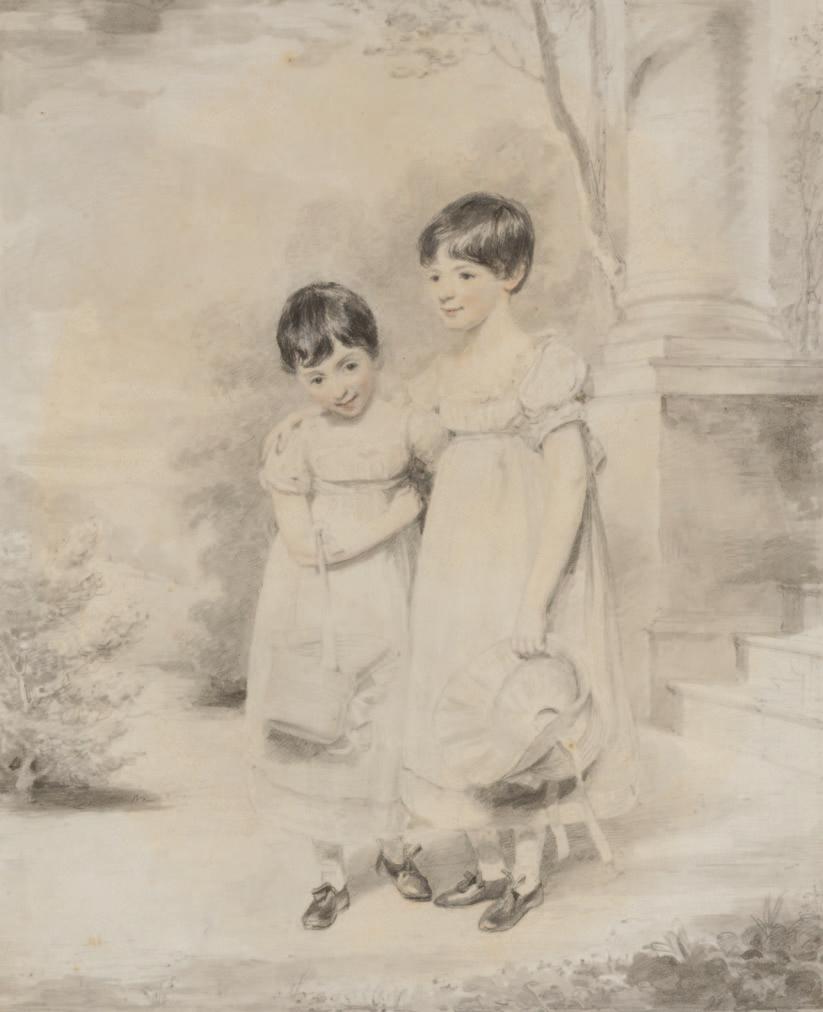
80
Henry Edridge, A.R.A. (1769-1821)
Portrait of two Sisters
Indistinctly signed lower right Watercolour and pencil
27.6 by 22.6 cm., 10 ¾ by 8 ¾ in.
Provenance: Anonymous sale, Christie’s, 24th April 1997, lot 176; Timothy Clowes
Portrait of Lady Charlotte Pelham-Clinton
Full-length, kneeling
Inscribed on backboard: Charlotte Pelham Pelham Clinton Watercolour over pencil 9.8 by 8.1 cm., 3 ¾ by 3 in.
Lady Charlotte Pelham-Clinton (1812-1886) was the daughter of Henry Pelham-Clinton, 4th Duke of Newcastle (1762-1851) and Georgiana Elizabeth Mundy (1789-1822) of Clumber Park, Nottinghamshire. They married in 1807 and had fourteen children. Charlotte never married and from the 1850s lived with spinster sister Lady Charlotte at Ranby Hall near Retford, Nottinghamshire. A photograph of Lady Charlotte taken in 1861 is in the collection of the National Portrait Gallery.


Portrait of George Carnegie, Lord Rosehill
Full-length standing in a landscape leaning against a memorial, with the sea beyond Signed lower left: H. Edridge. March 1805. and inscribed on original backboard: George Lord Rosehill/HMS Blenheim/March 1805 Pen and grey ink and grey washes over pencil
31.3 by 22.2 cm., 12 ¼ by 8 ¾ in.
Provenance:
By descent from the sitter until sold at Sotheby’s, 11th November 1993, lot 62; With Agnew’s London, 1994; Anonymous sale, Christie’s London, 4th June 2008, lot 25 (1 of 2); By descent to the present owner
Exhibited:
Agnew’s London, 121st Annual Exhibition of Watercolours and Drawings, 28 February25 March 1994, no. 23
The sitter was born in 1789, the eldest son of William, 7th Earl of Northesk and his wife Mary, daughter of William Henry Ricketts of Longwood, Hampshire. He is depicted here as a sixteen year old leaning against a memorial to his uncle Captain Ricketts Jervis who was drowned at sea in January 1805 two months before the present drawing was executed. Tragically George Carnegie himself died at sea two years later, on 2nd February 1807 on board HMS Blenheim.
Portrait of George Carnegie, Lord Rosehill, with his brother the Hon. William Carnegie, as children
Full-length standing in a landscape with the sea beyond
Signed and dated, lower left: Edridge 1800 and inscribed on original backboard: George Lord Rosehill 9 years of age/William Hopetoun Carnegie 6 years of age/…. Rosehill Novbr 1800
Pen and grey ink and grey washes over pencil 29.2 by 22.2 cm., 11 ½ by 8 ¾ in.
Provenance:
By descent from the sitter until sold at Sotheby’s, 11th November 1993, lot 61; With Agnew’s London, 1994; Anonymous sale, Christie’s London, 4th June 2008, lot 25 (1 of 2); By descent to the present owner
Exhibited:
Agnew’s London, 121st Annual Exhibition of Watercolours and Drawings, 28 February-25 March 1994, no. 24
The two boys, aged nine and six respectively, were the two eldest sons of Admiral William Carnegie, 7th Earl of Northesk (1756-1831) and his wife Mary Ricketts, of Longwood, Hampshire. George Carnegie was lost at sea in 1807, off the Rodrigues Island in the Indian Ocean aged 15. His younger brother William became 8th Earl, on the death of his father and died in 1878, at the age of 84.


Black and red chalk and stump 63.2 by 41.3 cm., 24 ¾ by 16 ¼ in.
Provenance:
Richard Monckton Milnes, 1st Baron Houghton, London and Fryston Hall, Castleford, West Yorkshire; By descent to his son Robert Crewe-Milnes, 1st Marquess of Crewe (1858-1945); By descent to his daughter, Mary Innes-Ker, Duchess of Roxburghe, London and West Horsley Place, Surrey, her posthumous sale, London, Sotheby’s, 27-28th May 2015, lot 71;
With Daniel Katz, London
Exhibited:
Saltaire, The Royal Yorkshire Jubilee Exhibition, 1887, unnumbered
This drawing is one of the largest recorded by Lawrence and is likely to date from the 1790s. It is also unusual in being a genre subject and can be viewed as a ‘fancy picture’ which were popular at the period. Fancy pictures depicted a scene of everyday life often with a story behind it and an element of sentimentality. They usually include studies of children, beggars, maids, shepherd or street urchins.
Lawrence was the leading portrait painter in oil of his generation, replacing Gainsborough and Reynolds. He started his career in Bath producing small portraits in pastel (see no.43) before moving to London in 1787 where he began to work in oil. He replaced Reynolds as Painter to King George III on the latter’s death in 1792 and became a full member of the Royal Academy in 1795. He enjoyed royal patronage throughout his career and was knighted in 1815, becoming President of the Royal Academy in 1820.
He was much admired for the quality of his draughtsmanship during his lifetime and subsequently. His friend Lavinia Banks recalled after his death: ‘The Taste, the delicacy, the elegance of his drawings was unrivalled and unique, and rendered them deservedly prized and admired’ (see The Builder, 6th July 1867, p.483). The critic Cosmo Monkhouse (1840-1901) wrote in the late nineteenth century: ‘As a draughtsman, especially of faces and hands, he is scarcely equalled by any English artist…. His most perfect works are his drawings in crayon and pencil, which he continued to execute throughout his life’ (William Cosmo Monkhouse, The Dictionary of National Biography, 1892-3, vol. XI, pp.725-6).


Study for ‘The Bride at her Toilet on the Day of her Wedding’
Pen and brown ink, with artist’s notes verso 8.6 by 6.8 cm., 3 ¼ by 2 ½ in.
Provenance:
Bought at the Gerald Norman Gallery, London, March 1976; By descent until 2019
The present lively, drawing is a study for an oil painting, now in the National Galleries of Scotland and which was exhibited at the Royal Academy in 1838. Wilkie was a superb draughtsman, whose technique was heavily influenced by the work of earlier seventeenth century, particularly Dutch old masters, such as Rembrandt and Rubens.
It was characteristic of Wilkie’s practice, that he produced numerous sketches and studies, both rapid, slight sketches and more carefully worked up compositional studies, when working out the compositions of his paintings. He worked in a range of media from highly finished coloured drawings, to rapid pencil studies to lively compositional studies in pen and ink, such as the present work.
Inscribed lower right: 44, pencil 8 by 7 cm., 3 by 2 ¾ in.
Provenance: With Cyril Fry, 1965; Anonymous sale, Sotheby’s, 21st March 2002, lot 220; Private Collection
Literature:
Patrick Noon, Richard Parkes Bonington - the complete drawings, 2011, no.227, ill.
Patrick Noon dates the present drawing to circa 1825. It is likely to be a copy of a Florentine painting or engraving.
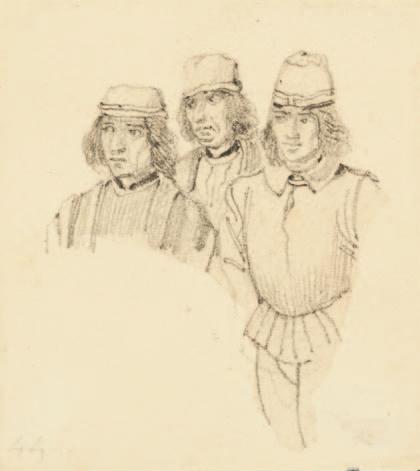
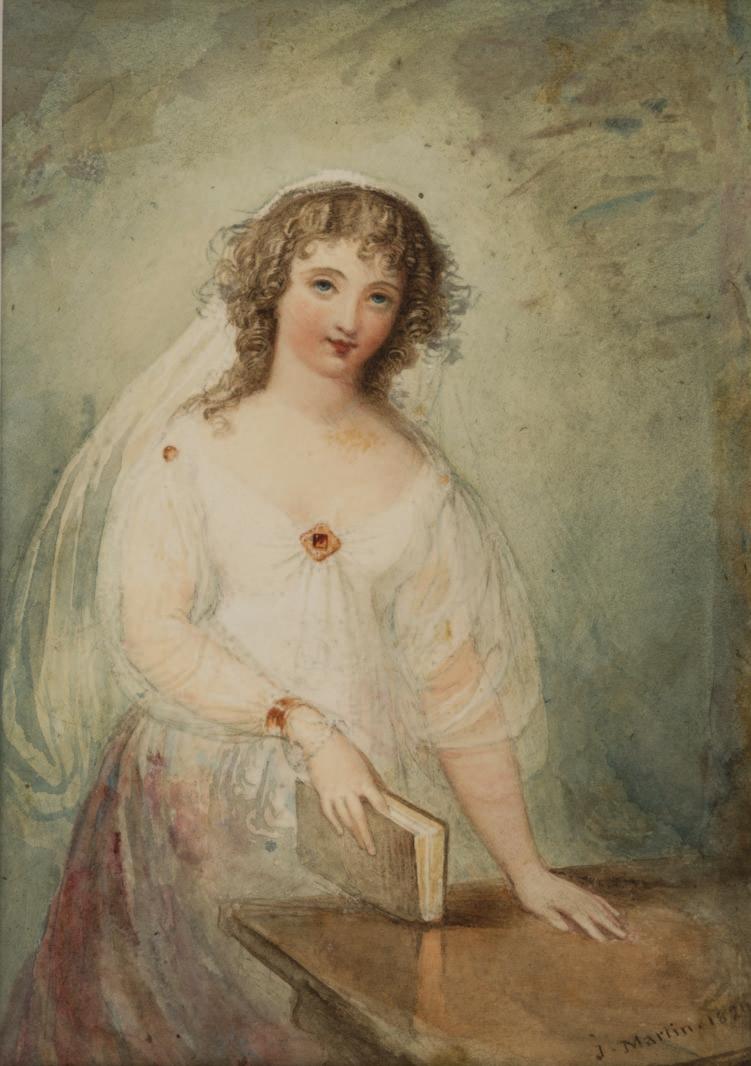
Portrait of a Girl resting a Book on a Table
Signed and dated 1829
Watercolour over traces pencil heightened with bodycolour
18.5 by 13 cm., 7 ¼ by 5 in.
Provenance: With the Christopher Wood Gallery, London; Anonymous sale, Christie’s, 9th July 1985, lot 107, where bought by the present owner
This is a rare figure study or portrait by Martin who is best known for his large paintings and watercolours of biblical or historical subjects. It was likely to have been used or intended for a book illustration. William Feaver writes: ‘Between 1827 and 1834 Martin provided many illustrations for Keepsakes, Amulets, Gems and Literary Souvenirs’ (see William Feaver, The Art of John Martin, 1975, p.110).
Portrait of the MacGregor Family
Full-length, seated in a interior
Signed with monogram under mount and inscribed: LIGHT ON THE RIGHT OF THE DRAWING
Watercolour over pencil heightened with bodycolour and scratching out 43 by 33.5 cm., 16 ¾ by 13 in.
Provenance:
David Daniells and Stevan Beck Baloga; Anonymous sale, Sotheby’s, 14th July 1994, lot 11;
Anonymous sale, Christie’s, 19th May 2000, lot 129;
Private Collection until 2019
Exhibited:
London, Royal Academy, 1832, no. 612; New York, Shepherd Gallery, English Realist Watercolours, 1830-1915, October to December 1997, no.24
Maclise was born in Cork, Ireland but moved to London in 1827 where he trained at the Royal Academy Schools. This family portrait dates from the early 1830s when he claimed to have painted a thousand portraits. He drew portraits of popular literary figures for Fraser’s Magazine in the early 1830s including Paganini, Thackeray and his close friend Charles Dickens whom he depicted on a number of occasions. From 1846, he began work on frescoes for the newly built House of Lords and from then on concentrated on large scale history pictures and frescoes.


Born in rural Somerset, Sarah Biffin was taught the rudiments of painting by a Mr Dukes, whom she met in about 1804. She later became a pupil of the accomplished miniature painter, William Marshall Craig (1765-1827) [see no.33]. Born without arms or legs, Sarah started her artistic career exhibiting both her working practice and her art at travelling fairs. She would also rent rooms where people would pay an admission price to see her write, sew and paint using her mouth and shoulder.
Biffin entered into a contract with Dukes, who took the admission fees and paid her a small annual salary and between 1804 and 1810, they travelled extensively throughout the country. For several years, Biffin seemed happy with the arrangement, which probably also provided security; furthermore the opportunity to travel must have appealed. However, by about 1816, Biffin began to break away from Dukes and establish herself independently.
Inscribed on backboard: Painted by Mifs/Biffin/born without arms/or legs/1825
Watercolour and bodycolour on vellum 8.2 by 8 cm., 3 by 3 in.
In 1808, Biffin met George Douglas, 16th Earl of Morton and Chamberlain to the Queen’s Household, who became her informal advisor and arranged for her to study under Craig. He also brought her to the attention of King George III. In 1830, George IV purchased a miniature for 25 guineas and also that year she was appointed Painter in Miniature to Princess Augusta Sophia, one of the King’s sisters. Biffin was later able to boast that she had the patronage of three monarchs, George IV, William IV and Queen Victoria, as well as Prince Albert.
In 1821, Biffin moved to London, where she exhibited at the Royal Academy for the first time and was awarded the large silver medal by the Royal Society of Arts. On a visit to Brussels she was appointed Miniature Painter to Willem Frederik, Prince of Orange. In 1825 she moved to Birmingham where she established herself as a teacher, offering not only in-person sessions in her studio, but also correspondence classes. She was accomplished in a range of media from porcelain to watercolour on ivory, vellum and paper. It is interesting to note that she specifically wanted to teach women, something she advertised.
In anticipation of a possible move to America, in 1841, Biffin moved to Liverpool. It seems that Biffin knew Ellen Sharples (1769-1849), wife of James Sharples (see no. 64) who had lived in the States for several years. It is also likely that Biffin would have heard about the success that several disabled artists found there. However, ill health and declining eyesight meant that Biffin remained in Britain. She found favour with the Rathbone family, well-known Liverpool philanthropists and Joseph Mayer, a noted collector, and they did much to help support her until her death in 1850.
The present painting is unusual in the artist’s oeuvre, as most of Biffin’s output was portraits with the exception of some still lives and highly detailed studies of feathers, which she painted when touring. Religious subject matter is rare in her oeuvre and this may be a commission.

90
English School, circa 1830
The Artist’s Children Playing with a Toy Boat Oil on millboard
13 by 15.5 cm., 5 ¼ by 6 ¼ in.
Provenance: Private Collection 2012 until 2024
This recently rediscovered oil sketch forms part of a series of charming alla prima studies made by Constable of his young family in the early 1820s. These pictures, all clearly spontaneous in their conception, were usually executed on small pieces of millboard or discarded panel. They give a touching insight into Constable’s status as a devoted family man. The present scene almost certainly depicts the artist’s three eldest children: John Charles (1817–1841), Maria Louise (1819–1885) and Charles Golding (1821–1879). It is probably set in the artist’s residence on Charlotte Street and shows the artist’s eldest son directing his younger siblings in a game involving a toy boat being blown by bellows in a wooden tub. Whether a coincidence or not, Constable's third child, Charles, developed a nautical obsession at a young age and would depart for the East Indies and China at the age of only fourteen. He later rose to the rank of Commander in the Indian Navy.
Comparable studies of the artist’s family include a sketch of Constable’s wife Maria with their two eldest children from c.1820 now in the Tate (no. T03903) and a humorous picture of his daughter Maria Louise peering from behind a curtain dressed as Bo-Beep (see G. Reynolds, The Early Paintings and Drawings of John Constable, 2 vols, London 1996, p. 242, no. 20.88A (text), reproduced in colour fig. 1388 (plates)). Constable was clearly engaged by the humour and ingenuity of his children as they played, on one occasion executing a swift watercolour sketch of two of them constructing a Heath-Robinson style vehicle made up of chairs and a rocking horse (fig.1). Probably originally part of a letter, he proudly comments below the watercolour: “All this is entirely his own invention.”

Fig.1 John Constable, RA (1776-1837), A Drive in the Nursery: John Charles and Maria Louisa Constable, c.1821, watercolour over pen and ink, 8.5 by 19 cm (Private Collection)


Study of Turkish Figures
Signed upper left: GH/1824
Pen and brown ink on laid paper 13.4 by 24.1 cm., 5 ¼ by 9 ½ in.
Provenance:
Iolo A. Williams (1890-1962), Kew Gardens, Surrey
This is typical of Hayter’s pen and ink drawings which are highly finished and often signed. He travelled to Italy in 1816 to study where he met Canova and Hayter’s drawings show evidence of the sculptor’s influence. He returned to London in 1818 and practiced as a portrait and history painter in oils often working on a large scale. In 1831 he was commissioned to paint a portrait of the future Queen Victoria and on the death of David Wilkie in 1841, he was appointed Painter in Ordinary to the Queen.
Portrait study of a European in Turkish Dress, probably Sir John Gardner Wilkinson (1797-1875)
Watercolour over pencil and black chalk heightened with bodycolour
Sheet 37.3 by 27.3 cm., 14 ¾ by 10 ¾ in.
This intriguing portrait of a European man in Oriental dress by John Frederick Lewis is likely to have been made during the artist’s decade-long sojourn in Egypt, from 1841 to 1851. During this time, Lewis lived in a large wooden, Ottoman-style house, in a district of Cairo ‘far away’, according to William Thackeray, ‘from the haunts of European civilisation’. A prominent member of the expatriate community during the mid 19th century was Sir John Gardner Wilkinson (1797-1875), who by the 1840s had gained acclaim and fame for his ground-breaking studies in Egyptology. Wilkinson revisited Egypt another four times between 1841 and 1856, and during the first of these return trips he met Lewis at least twice. In Lewis’s studio sale held in 1855, a few years after his return from Egypt, lot 129 is ‘Sir Gardiner[sic] Wilkinson, in Oriental Costume’ (Christie’s, 5 July 1855, bought by the dealer, William Vokins). A portrait of ‘Sir G. Wilkinson’ is also listed in a letter of 14 April 1857 from Lewis to another dealer, John Scott (Private Collection). Another similarly sized version of the portrait that is here identified as likely to be of Wilkinson, is in the Ashmolean Museum, Oxford (WA.OA966), currently titled Study of a Seated Oriental Man, smoking.
Wilkinson’s fame during his lifetime resulted in several known portraits of him. Among these, made at around the same time as the Lewis portraits, are drawings by William Brockedon, 1838, and Alfred, Count d’Orsay, 1839 (both, National Portrait Gallery, NPG 2515(86) and NPG 4026(28)), and by Godfrey Thomas Vigne, 1844 (Victoria and Albert Museum, SD.1156). The most widely known portrait of Wilkinson is a painting by Henry Wyndham Phillips, Sir John Gardner Wilkinson, aged 46, in Turkish Dress, 1844 (The National Trust: Calke Abbey, Derbyshire).
See our website for an extended version of this note. We are grateful to the late Briony Llewellyn for this note with thanks to Charles Newton.


Portrait of Henry and Philip Fletcher
Coloured chalks on paper laid on canvas Oval 61 by 61.5 cm., 24 by 24 ½ in.
Literature: Raymond Lister, George Richmond, 1981, p.158, no.46
This is a portrait of Henry Charles Fletcher and his brother Philip, the sons of Major General Fletcher of the Scots Guards and his wife the Hon. Mrs Ellen Shore. Henry was later a Lt Colonel in the Scots Guards.
This portrait is dated in Richmond’s stockbook to February 1840 and was sold for £31.10 and is described as ‘Captain Fletcher's Two children.’ Richmond drew a number of members of the Fletcher family between 1831 and 1850. See note to no. 96 for more on the artist.
Portrait of a Gentleman
Watercolour over pencil heightened with bodycolour and gum arabic
56.7 by 44.1 cm., 22 ¼ by 17 ¼ in.
This relates stylistically and is in the same format as a portrait of Henry Addington, 1st Viscount Sidmouth dated 1835 in the NPG. See note to no.96 for more on the artist.

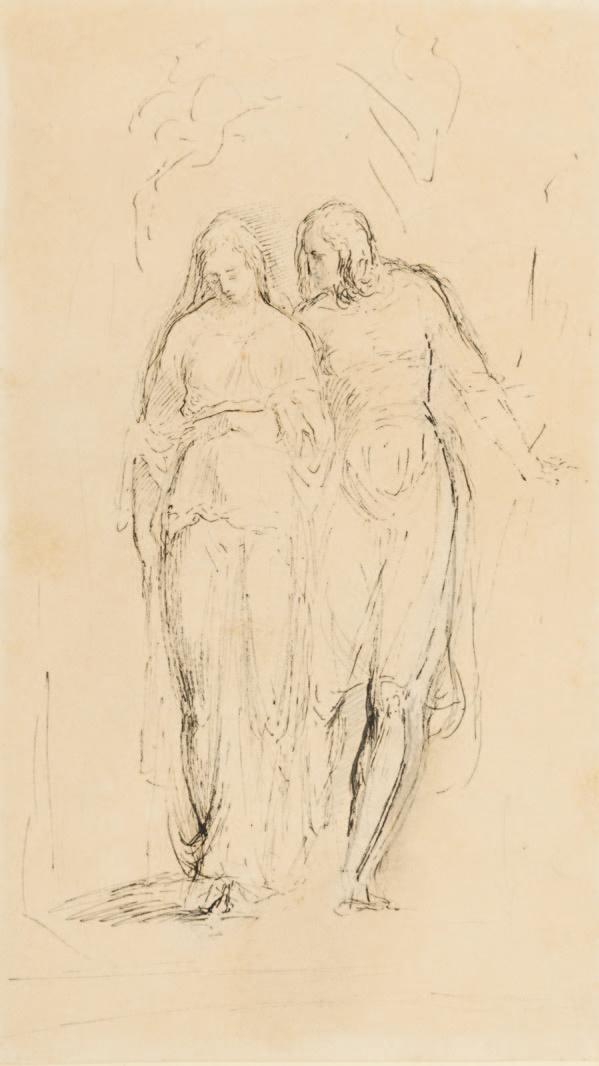
Pen and black ink over pencil 21 by 12.7 cm., 8 ¼ by 5 in.
Provenance: With Chris Powney; Private Collection, London
George Richmond along with Samuel Palmer and Edward Calvert, formed the core of a group of young artists, who became known as ‘The Ancients’ and were close to and deeply influenced by the artist and poet, William Blake at the end of his life. ‘The Ancients’ were so called, due to their belief that ancient man was superior to modern man. They sought inspiration through religion, literature, especially the poetry of Milton and Spencer and the work of Shakespeare, as well as through the natural world. Two of Richmond’s early exhibited works at the Royal Academy were religious subjects, ‘Abel the Shepherd’ and ‘Christ and the Woman of Samaria’ in 1825.
As Richmond’s reputation as a portrait painter grew in the early 1830s, he had less time to indulge his interest in landscapes and literary works and became increasingly rare in his oeuvre and were produced largely as a means of relaxation.
Portrait of the artist Miles Edmund Cotman
Inscribed by a later hand verso: Miles Edmund Cotman/by Geldart Black and white chalk on brown paper 32.3 by 23.5 cm., 12 ¾ by 9 ¼ in.
Provenance: By descent in the Cotman family until 2023
Literature:
Illustrated London News, 1st August 1942, p.136
Miles Edmund Cotman (1810-1858) was the eldest son of the Norwich School artist John Sell Cotman (17821842). He trained under his father and first exhibited at the Norwich Society aged thirteen. In 1834 when Cotman senior was appointed drawing master at King’s College, London, Miles took over his father’s teaching practice in Norwich. In 1836 he joined his father in London and took over his professorship until the mid 1850s. His style relates closely to that of his father.
Geldart was a close friend and sketching companion of Miles’ brother John Joseph Cotman. He abandoned a career in the law in favour of being an artist and became a pupil of John Sell Cotman. Geldart also sketched his friend John Joseph, a chalk drawing which was later engraved.


Portrait of a seated Girl in red Shoes
Watercolour over pencil heighted with touches of white
16.5 by 10.8 cm., 6 ¾ by 4 ¼ in.
Provenance:
Given by the artist, along with other watercolours, to his housekeeper; by whom given to Jane Bishop (d.1952), and by descent
Hunt’s daughter, Emma, was born in either 1831 or 1832 and she appears as the model in several watercolours by the artist, possibly including the present work. The soft brushstrokes add to the sense of intimacy of the scene.
Head study of a Man
Pen and brown ink and watercolour on laid paper 9.6 by 8.3 cm., 3 ¾ by 3 ¼ in.
Provenance: Cyril Fry (1918-2010)
Literature:
Probably John Witt, William Henry Hunt, Life and Work, with a Catalogue, London 1982, p. 177, no. 378
Exhibited:
Probably, London, The Fry Gallery, Watercolours and Drawings from the Collection of Mr and Mrs Cyril Fry, 1967, no. 38a

The abolition movement gripped fashionable London, turning Britain in the early 19th Century from a nation benefitting from slavery, to one that became an international supporter of abolition. Slavery was abolished throughout the British Empire in 1833. There were relatively large numbers of black residents throughout Britain, particularly in London, Liverpool, Kent and Edinburgh. During the 1840s and 1850s Britain became a popular destination from figures all over the world for the study of theology and medicine. Furthermore, numerous fugitive slaves arrived from the States and elsewhere. ‘In conscious tribute to urban diversity,’ (Jan Marsh ed., Black Victorians: Black People in British Art 1800-1900, 2005, p. 14) artists regularly included black figures in their crowd scenes, such as in George Sidney Shepherd’s large exhibition watercolour of Old Covent Garden Market in London, painted in 1829 (with Guy Peppiatt Fine Art, 2023). Apparently, visitors from the United States remarked on the integration within Britain’s cities. However, intolerance and racism was also evident and this seems to have grown as the century progressed.
Hunt had a number of friends within the black community and made several studies of these, including a pencil Portrait of a Young Girl at the Courtauld Institute, London; A Boy with a Slate at the Victoria and Albert Museum, London and Study of a Young Model, in the Metropolitan Museum of Art, New York. See website for an extended version of this note.
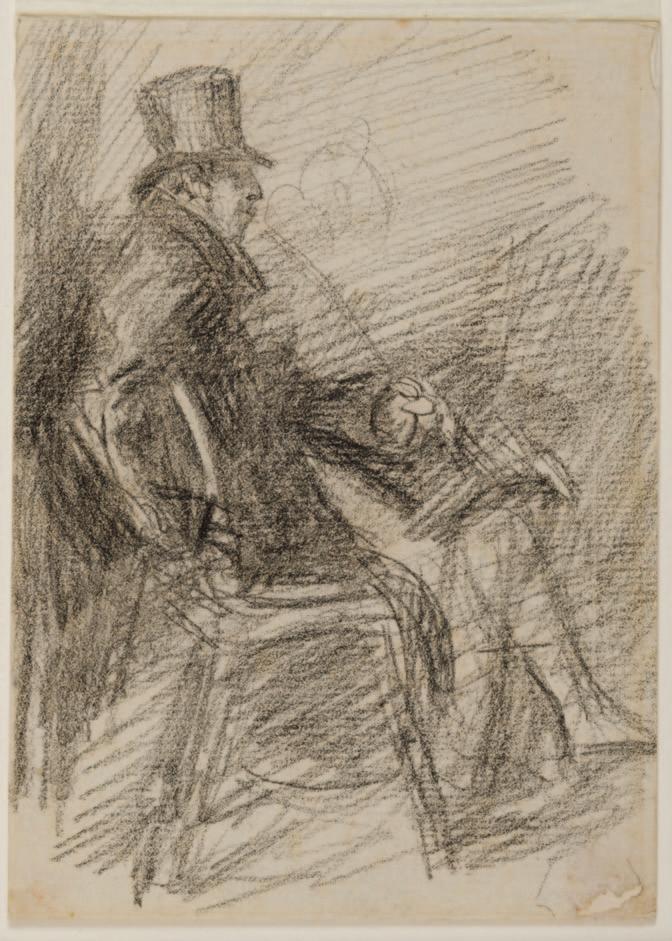
100
William Henry Hunt O.W.S. (1790-1864)
Study of a Gentleman seated, smoking a Pipe
Pencil on laid paper 12.8 by 9.1 cm., 5 by 3 ½ in.
Provenance: Cyril Fry (1918-2010)
Literature:
Norwich, Castle Museum and London, J.S. Maas Gallery, William Henry Hunt 1790-1864, Water-colours and Drawings from the Collection of Mr & Mrs Cyril Fry, 1967, part of no. 16
Exhibited:
Norwich, Castle Museum and London, J.S. Maas Gallery, William Henry Hunt 1790-1864, Water-colours and Drawings from the Collection of Mr & Mrs Cyril Fry, 1967, no 16 (one of Three Pencil Portrait Sketches).
101
William Henry Hunt O.W.S. (1790-1864)
A Girl seated holding a Toy
Signed and dated lower right: W. HUNT./1814. Pencil
15.4 by 12.6 cm., 6 by 5 in., oval
Provenance: Cyril Fry (1918-2010)
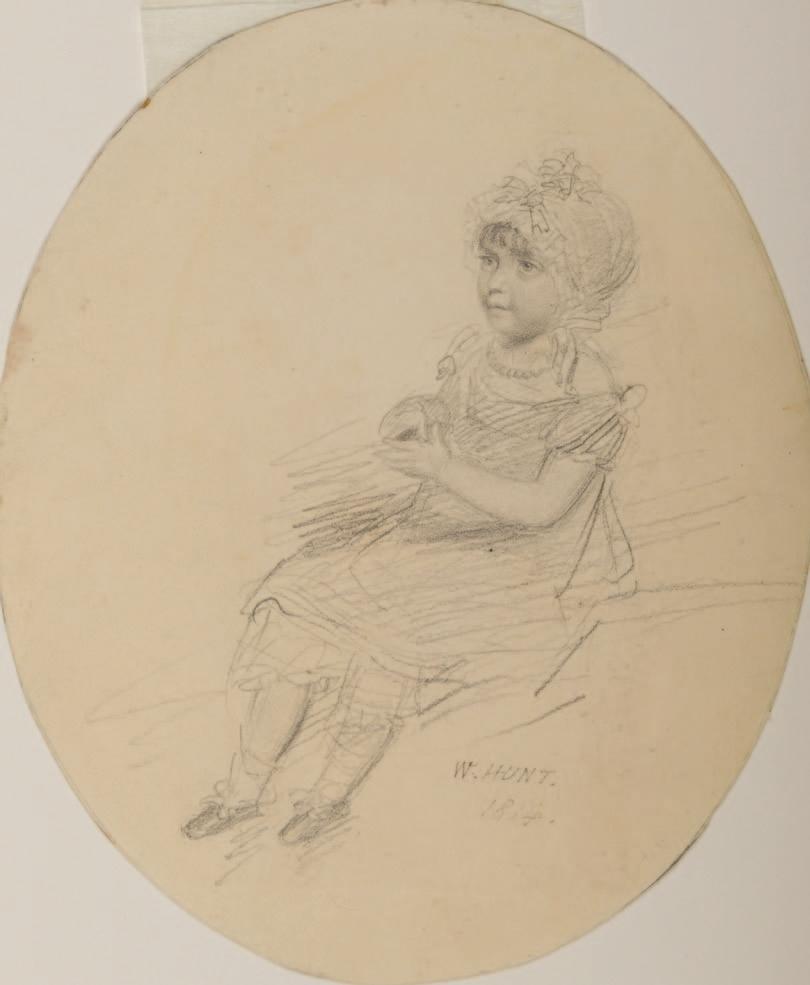

Sir William Rothenstein
Study of a Violinist tuning up
Inscribed centre right: effect 2 lights Black and white chalk on buff paper
36.4 by 23.6 cm., 14 ¼ by 9 ¼ in.
Provenance:
By descent from the artist until sold, Sotheby’s Olympia, 26th February 2003, lot 15; Private Collection, London
Rothenstein was born in Bradford, Yorkshire, his father having emigrated from Germany in 1859 to work in the textiles industry. His uncles Charles and Albert were both involved in the arts as an important collector and artist respectively. They both changed their surnames to Rutherston during the First World War. Rothenstein studied at the Slade and later in Paris and became a successful artist. He is best known for his work during both World Wars and for his portraits, more than two hundred of which are in the National Portrait Gallery.
Rothenstein painted musicians and composers on many occasions. An oil ‘The Violinist’ is in the collection of the University of Sheffield and a drawing of Arnold Dolmetsch playing the violin is in the Tate Gallery. He also drew chalk studies of Ralph Vaughan Williams (Royal College of Music) and Edward Elgar (NPG).
Signed lower right: G.L. Brockhurst
Pencil
30 by 27cm., 11 ¾ by 10 ½ in.
Provenance:
With Daniel Katz, London
Brockhurst’s talents were evident very early on and he was admitted to the Birmingham School of Art by 1901, before then entering the Royal Academy Schools in 1907. A travel scholarship took him to Paris and Italy in 1913, where he was inspired by the work of the 15th century Italian masters, especially Botticelli, Piero della Francesca and Leonardo da Vinci, whose work had a lasting impact on his development as an artist. Between 1915 and 1919, Brockhurst and his first wife and muse, Anaïs Folin lived in Ireland, where they became friends with Augustus John (1878-1961) and his circle. In 1919, they returned to London when the Chenil Gallery put on the first major exhibition of Brockhurst’s work.
During the 1920s Brockhurst became fascinated by etching and produced a remarkable body of works, mainly of women and primarily of his wife. The following decade however, saw his return to painting and the emergence of a new muse and model, Kathleen (Dorette) Woodward, with whom he began a passionate affair (the couple later married in 1940, following Brockhurst’s divorce). His technical virtuosity and power, combined with remarkable psychological insight rapidly cemented his position as one of the most celebrated and fashionable portraitists of the interwar period. He was able to command large fees (up to 1000 guineas) for his work and limit his commissions to just 20 a year. Notable sitters included the Duchess of Windsor, Marlene Dietrich, Merle Oberon, John Paul Getty and Mrs Paul Mellon.
At the height of his powers in 1939, Brockhurst moved to America, settling first in New York and then New Jersey where he remained for the rest of his life and where he continued to paint and undertake portrait commissions.

Portrait of the Artist’s Daughter, Lady Diana Cooper
Inscribed lower left: “Off to Philadelphia”/in train Feb, 1924 Pencil on laid paper 11.1 by 8.8 cm., 4 ¼ by 3 ½ in.
Marion Margaret Violet Lindsay, granddaughter of 24th Earl of Crawford, was widely regarded as one of the most striking beauties of her day. In 1882, she married Henry Manners, who became Marquess of Granby, before succeeding as 8th Duke of Rutland in 1906. She and her husband however, moved in very different circles: he was politically conservative, aesthetically disinterested and interested in country pursuits, especially hunting. Violet, on the other hand was bohemian, intellectual and determined to be taken seriously as an artist. She became a leading member of The Souls, a loosely knit social group of intellectual aristocrats which formed in the 1870s. The group were known for their shared avant-garde artistic taste and cultural sophistication. Other members included Arthur Balfour, George Curzon, Alfred Lyttelton, Margot Asquith and Henry Cust (reputedly the father of her third daughter, Diana).
A talented draughtswoman and sculptor, Violet was largely self-taught and encouraged by her family in her passion. She exhibited at the Royal Academy, Grosvenor Gallery and Fine Art Society as well as in France and America. She continued to work and exhibit until a month before her death in November 1937.
The present portrait is of her youngest daughter, Lady Diana Manners. Another great wit and beauty, Diana was one of the most painted and photographed women of her day. In 1919 she married the diplomat, Duff Cooper (later Viscount Norwich) and partly in order to finance her husband’s political career she turned to the stage. The present work depicts Lady Diana Cooper on a train to Philadelphia during her 1924 North American revival of Karl Vollmoller’s, The Miracle. The play performed entirely without words was originally produced by C.B. Cochran at Olympia, London in 1911, with Diana taking the role of the Madonna. It was revived in New York in 1924 and again at the Lyceum Theatre in 1932 with costumes by Oliver Messel. The revival was extremely successful and toured for two years in Britain and abroad.
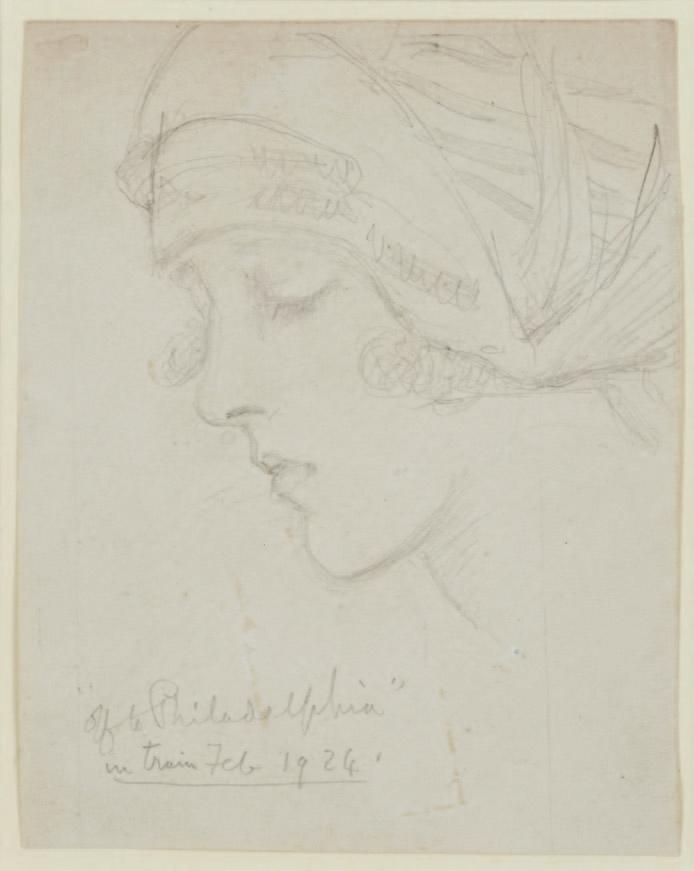
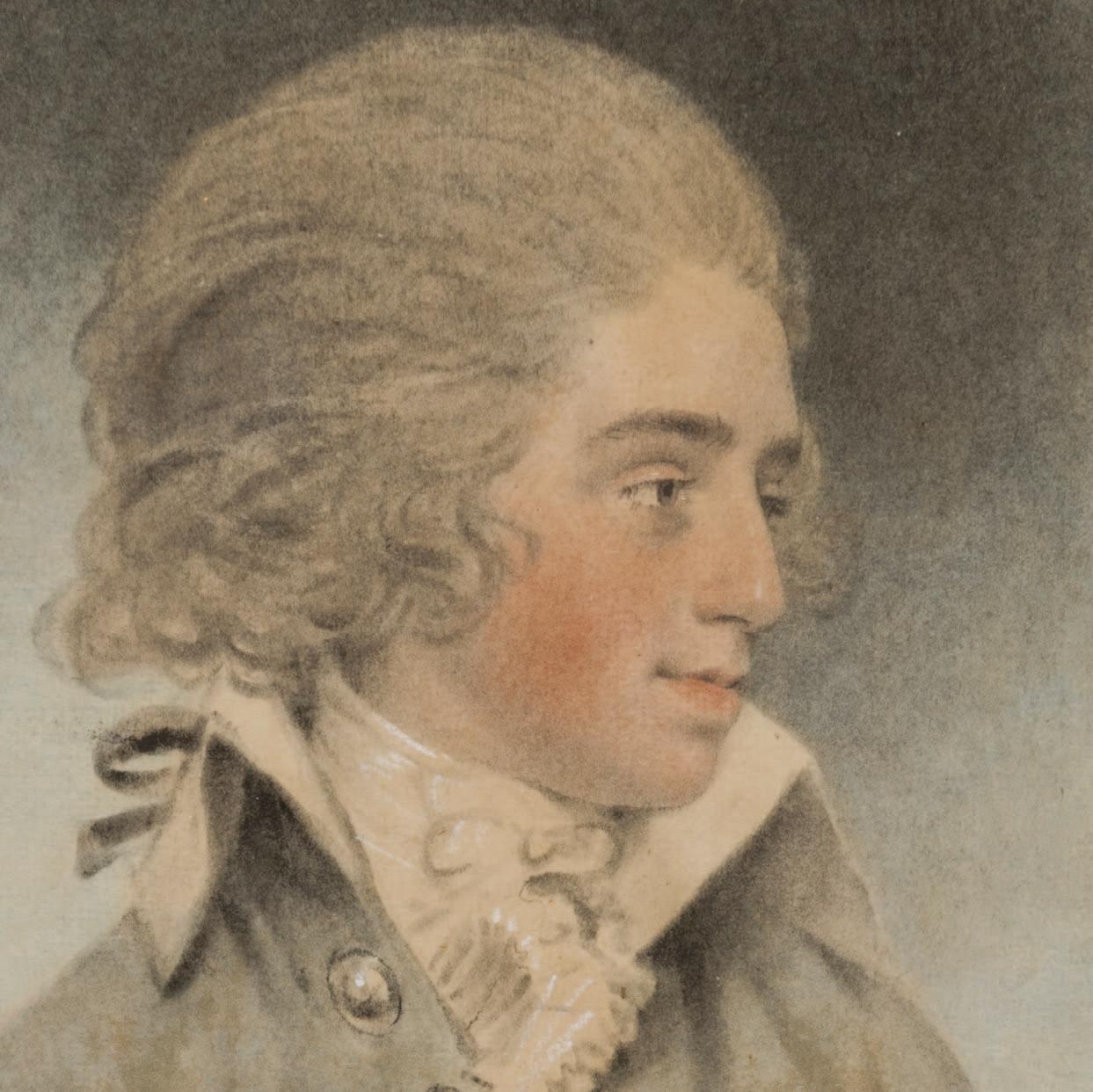
A
Cat. No.
Alexander, William (1767-1816) 53
Beale, Charles Junior (1660- c.1714) 9
Bernard, Samuel (1615-1687) 10
Biffin, Sarah (1784-1850) 89
Boningto, Richard Parkes (1802-1828) 86
Brockhurst, Gerald Leslie R.A (1890-1978) 103
C
Constable, John R.A (1776-1837) 91
Continental School (18th Century) 41
Coques, Gonzales (Attributed To) (1618-1664) 4
Cosway, Richard R.A (1742-1821) 24, 26, 30, 32, 68, 69
Craig, William Marshall (c. 1764-1829) 33
D
Des Granges, David (1611-1672) 6, 7
Dighton, Robert (1752-1814) 52
Dixon, Nicholas (1660-1708) 11
Downman, John A.R.A (1750-1824) 72, 73, 74, 75, 76
Edridge, Henry A.R.A (1769-1821) 78, 79, 80, 81, 82, 83
Engleheart, George (1750-1829) 20, 22,25, 27, 28
English School (1727-1728) 34
English School (17th Century) 12
English School (c.1795) 65
English School (c.1801) 64
English School (c.1830) 90
English School (Late 18th Century) 56, 61
FOpposite: (72) John Downman, A.R.A. (1750-1824)
Portrait of John Congreve (detail)
Cat. No.
Ferguson, Henry (1665–1730) 13
Flaxman, John R.A (1755-1826) 70, 71 French School (c. 1590) 2
Gardner, Daniel (1750-1805) 44, 45
Geldart, Joseph (1808-1882) 97
Gibson, Richard (Attributed To) (c. 1605-1690) 8
Grimaldi, William (1751-1830) 21
HHall, Pierre Adolphe (1739-1793) 23
Hallé, Nicolas (Attributed To) (1749-After 1790) 18
Hamilton, Hugh Douglas (1740-1808) 46, 47, 58 57
Hayter, Sir George (1792-1871) 92
Hoare of Bath, William R.A (1707-1792) 37
Hoskins, John The Younger (1620s- after 1703) 5
Hunt, William Henry O.W.S (1790-1864) 98, 99, 100, 101 I Irish School (1770s) 54 Irish School (1780s) 60
LLawrence, Sir Thomas P.R.A (1769-1830) 40, 84 Lewis, John Frederick R.A (1804-1876) 93 Lockey, Rowland (Attributed To) (c. 1566-1616) 3
Maclise, Daniel R.A (1806-1870) 88
Manners, Violet Duchess of Rutland (1856-1937) 104
Martin, John (1789-1854) 87
Meyer, Jeremiah R.A (1735-1789) 16 R
Richmond, George R.A (1809-1896) 94, 95, 96 Robins, Thomas The Elder (1715-1770) 36
Romney, George (1734-1802) 39
Rothenstein, Sir William (1872-1945) 102 Rowlandson, Thomas (1756-1827) 50, 51
Russell, John R.A (1745-1806) 42
S
Sandby, Paul R.A (1730-1809) 66
Sharples Family (c. 1800) 62
Sharples, James (1752-1811) 63
Smart, John (1741-1811) 15, 17, 19, 20
Smith, John Raphael (1752-1812) 48, 49, 59 Spencer, Gervase (c. 1715-1763) 14 T
Teerlinc, Levina (Attributed To) (1510-1576) 1
Tonelli, Anna (c. 1763-1846) 43, 55 V Vanderbank, John (1694-1739) 35 W
Ward, James R.A (1769-1859) 67, 77 Wilkie, Sir David R.A (1785-1841) 85
Wood, William 31
Z
Zoffany, Johan Joseph R.A (1733 –1810) 38
Tel: +44 (0) 7983 510 056 emma@portraitminiature.com www.portraitminiature.com
Riverwide House, 6 Mason’s Yard, Duke Street, St James’s, London SW1Y 6BU
Tel: +44 (0) 20 7930 3839 Mobile: +44 (0) 7956 968284 guy@peppiattfineart.co.uk www.peppiattfineart.co.uk
by sarahgarwoodcreative.com Printed by healeys-printers.co.uk
Opposite: (73) John Downman, A.R.A. (1750-1824) Portrait of Mrs Townley and her Son
